

न्यूजट्रैक के नए ऐप से खुद को रक्खें लेटेस्ट खबरों से अपडेटेड । हमारा ऐप एंड्राइड प्लेस्टोर से डाउनलोड करने के लिए क्लिक करें - Newstrack App

The Chinese army fired a barrage of "warning shots" in the air at the North Bank of Pangong lake in eastern Ladakh last week to "intimidate" the Indian troops ahead of the talks between foreign ministers of the two countries in Moscow, official sources said on Wednesday.
The incident took place on the ridgeline of Finger 4 where the Indian Army has been significantly increasing its deployment after occupying several strategic peaks on the southern bank of the lake, they said.
The sources said a sizeable number of troops from the Chinese People's Liberation Army aggressively approached towards an Indian position but they returned sometime later as alert Indian Army personnel held on to their ground with firmness.
While going back, the Chinese troops fired 100-200 rounds of warning shots primarily to intimidate the Indian Army personnel, they added.
The incident took place ahead of a meeting between External Affairs Minister S Jaishankar and his Chinese counterpart Wang Yi last Thursday on the sidelines of a Shanghai Cooperation Organisation conclave in Moscow.
The first incident of firing of shots was reported on the evening of Sept. 7 near an Indian position in Mukhpari area of Rezang-La ridgeline on the southern bank of Pangong lake. Both sides accused each other of firing in the air.
The Chinese troops unsuccessfully attempted to close in on the Indian position and it was the first instance of shots being fired at the Line of Actual Control in 45 years.
At the Jaishankar-Wang talks, both sides reached a five-point consensus to resolve the over four-month-long border standoff.
The agreement included measures like quick disengagement of troops, avoiding action that could escalate tensions, adherence to all agreements and protocols on border management and steps to restore peace along the LAC.
In the Lok Sabha, Defence Minister Rajnath Singh on Tuesday said the Chinese side has mobilised a large number of troops and armaments along the LAC as well as in the depth areas.
He said there are several friction areas in eastern Ladakh including Gogra, Kongka La and North and South Banks of the Pangong Lake.
"In response to China's actions, our armed forces have also made appropriate counter deployments in these areas to ensure that India's security interests are fully protected," he added.
Meanwhile, both sides are yet to firm up a date for the sixth round of Corps commander-level talks.
Tension in eastern Ladakh increased manifold following the Galwan Valley clashes on June 15 in which 20 Indian Army soldiers were killed. The Chinese side too suffered casualties, but it is yet to give out the details.
The situation deteriorated again after China unsuccessfully attempted to occupy Indian territory in the southern bank of Pangong lake on the intervening night of Aug. 29 and 30.
India occupied a number of strategic heights on the southern bank of Pangong lake and strengthened its presence in Finger 2 and Finger 3 areas in the region to thwart any Chinese actions.
China has been occupying the areas between Finger 4 and Finger 8. The mountain spurs in the area is called Fingers. China has strongly objected to India's move. However, India has maintained that the heights are on its side of the LAC.
India has also rushed in additional troops and weapons to the sensitive region following China's transgression attempts. Following China's fresh attempts to change the status quo in the southern bank of Pangong lake, India has further bolstered its military presence in the region.



न्यूजट्रैक के नए ऐप से खुद को रक्खें लेटेस्ट खबरों से अपडेटेड । हमारा ऐप एंड्राइड प्लेस्टोर से डाउनलोड करने के लिए क्लिक करें - Newstrack App

Sixty-six per cent of Indian Americans currently favour Democratic presidential candidate Joe Biden.
Sixty-six per cent of Indian Americans currently favour Democratic presidential candidate Joe Biden for the 2020 presidential election as compared to only 28 per cent who prefer President Donald Trump, according to a survey released Tuesday.
Indiaspora, a nonprofit member organisation of global Indian diaspora leaders, and Asian American Pacific Islanders (AAPI) Data on Tuesday released their joint report on Indian American voters' attitudes in the upcoming 2020 US presidential election.
"66 percent of Indian Americans currently favour Vice President Biden, 28 percent favour President Donald Trump, and 6 percent were undecided. In the 2016 presidential election, 77percent voted for Secretary Hillary Clinton, and 16 percent voted for President Trump. If the remaining undecided voters broke in the same pattern as those who have madeup their mind, Joe Biden would secure 70 percent of the vote, when compared to 30 percent for Trump," the report read.
Election experts project that Democrats should be worried about Indian American voters attrition considering the overall percentage number may have dropped down for the Democrats from the 84 percent that supported Obama in 2012 and the 77 percent who supported Hillary Clinton 2016 as compared to the 66 percent supporting former Vice President Joe Biden. Meanwhile, President Trump's vote share has gone up from 16 percent in 2016 to 28 percent.
"I think Democrats absolutely should be concerned about making sure that they conduct sufficient outreach to Indian Americans that they conduct sufficient outreach to the different groups that comprise bases and Indian Americans because every vote is going to count especially in those battleground states," said Raja Krishnamoorthi, a Democrat congressman.
An Indian American himself and a representative from the state of Illinois, Raja Krishnamoorthi further said that the states of Pennsylvania, Michigan, Florida and North Carolina could be a part of the tipping factor this election. "And because of that I think the Joe Biden campaign has to be especially attentive," Raja Krishnamoorthi further asserted.
The survey report also documents the strengthening political power of the Indian American electorate in the U.S. due to factors such as their rapidly growing population and increased political participation.
"With increased attention being paid to the Indian American vote given our growing numbers, increasing political contributions and overall political engagement, we wanted to shine a spotlight on the issues that really matter to Indian American voters," said MR Rangaswami, founder of Indiaspora.
The report, which has survey results of 260 Asian Indian registered voters, regardless of party affiliation, found that some of the issues at the top of the list for Indian Americans in this election included education, jobs and economy, health care, and the environment.
The report also chronicles the rise of the Indian American electorate as one of the fastest-growing minority groups in the U.S., with significant numbers in "battleground" states.
"Indian Americans are positioned to make a difference in several swing states that may be close in this election, such as Florida (87,000), Pennsylvania (61,000), Georgia (57,000), Michigan (45,000), and North Carolina (36,000), and perhaps even Texas, which has 160,000 Indian-American voters," said Dr. Karthick Ramakrishnan, professor of public policy and political science at UC Riverside, and founder of AAPI Data. "Given Senator Kamala Harris's historic vice presidential nomination, as well as highly publicized rallies that President Trump and Prime Minister Modi held together, high turnout could make a huge difference in this election."
Currently, there are 1.8 million Indian Americans in the U.S. who are eligible voters. About 310,000 Indian green cardholders remain in a backlog for citizenship as of 2019, and another 310,000 Indian residents in the U.S. are in a backlog to obtain their green cards.
In addition, Indian American political engagement extended to several areas, with a fifth of Indian American registered voters saying they contacted their representative or government official in the U.S. this year, 74 per cent had discussed politics with family and friends, and a quarter of those surveyed had donated to a candidate, political party or campaign this year. By the end of June 2020, Indian Americans had donated at least USD3 million to 2020 presidential campaigns.
Both Democratic and Republican parties have conducted outreach to Indian Americans in this election, with 56 percent of Indian American registered voters surveyed saying they had been contacted by the Democratic party in the past year, and 48 percent saying they had been contacted by the Republican party. This is a marked increase from 2016, when only 31 percent of Indian Americans said they had been contacted by a political party, compared to 44 percent of White voters and 42 percent of Black voters.
In addition, several hundred Indian American candidates also are running for office in record numbers at federal, state and local levels.
"Given the Indian diaspora's increasing political importance in the US, it's no surprise they are being courted by both sides of the aisle," said MR Rangaswami, Founder of Indiaspora. "It's great that both major political parties have begun to realize just how critical it is to reach out to Indian Americans - our impact is only going to increase over time."
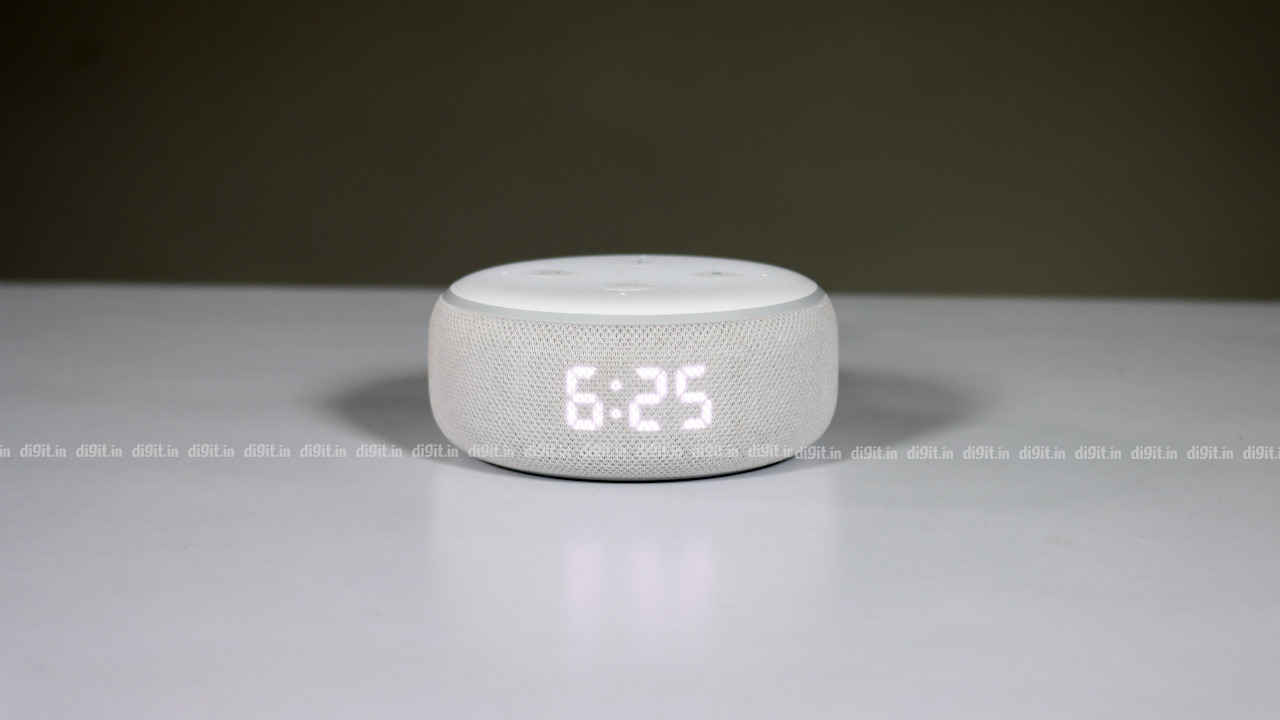
55
70
75
72
The Amazon Echo Dot with Clock is an ideal bedroom companion for music playback, nearby device control, and everyday tasks (such as taxi booking, etc.) even if it is priced a bit steep.
In a manner of speaking, the Echo Dot is to the Echo what the iPod nano was to the original hard drive-driven iPod. But this likeness wasn’t always so apparent when the Echo Dot was first released in March 2016. Also, it didn’t help that we only started seeing the Echo Dot in India from the second-generation model on. With the new third-generation model though, it’s amply clear that the Echo Dot is a shorter, more affordable version of the outgoing Echo. Sure, it may feature fewer microphones and speakers but it’s a proper Echo device nonetheless, in the same way an iPod nano was considered a proper iPod. And that’s exactly what Amazon wanted to create.
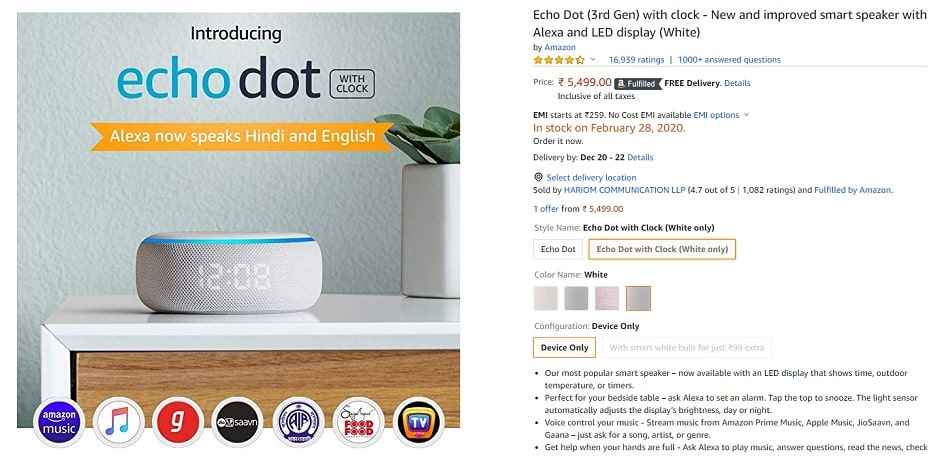
Rs 5,499 is rather steep for the added time display functionality
Amazon is currently selling the third-generation Echo Dot with an optional digital clock on its website. So, the clock-less Echo Dot sells for Rs 3,499 as of writing this review. If you wait for a grand sale (the way I did), you can get it for as low as Rs 1,999 along with a free smart bulb. It comes in grey, black, purple, and white colour options. The variant with a clock, however, sells for Rs 5,499. It’s available only in white and, as of writing this review, in stock again only in late February 2020. Still, let’s find out how it did during its stay at the Digit Test Centre.
The third-generation Echo Dot shares its design language with the current Echo and that’s no coincidence. It’s lost that original hockey puck design but has acquired a larger, softer, more curvy figure that looks friendly and approachable in any part of the house. Like the larger models, the Echo Dot is wrapped in fabric tightly around the sides. Like the second-generation model, there are four buttons on top: Volume up, Volume down, Microphone on/off, and Action. The signs on these buttons are embossed, so identifying them in the dark shouldn’t be a challenge. While the Echo has seven microphones around its four buttons, the Echo Dot makes do with four. The Echo Dot with Clock, however, comes with the addition of a four-character eight-segment LED display.
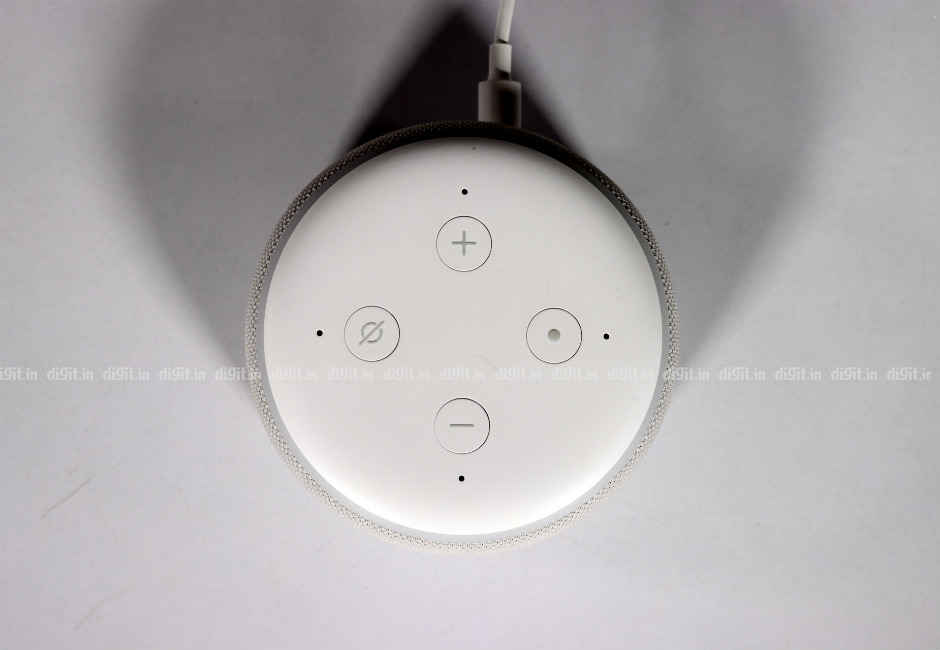
Four mics on top
On the back, the Echo Dot features a round-pin power port and a 3.5mm jack for audio output. The latter gives the Echo Dot a serious edge over the recently launched Google Nest Mini, its most direct competitor. You can read our review of it here. This should let you hook the device up to a larger, more powerful set of external speakers, thus letting you enjoy better sound while retaining the device’s smartness. The Echo Dot’s base has a large circular rubber foot, which should keep the speaker in place on most indoor surfaces. Like the more expensive models, the Echo Dot sports a proper multi-colour light ring to tell you what the device is up to. All things considered, the Echo Dot is built and designed quite well. If anything, the non-clock variant could have come with a wall mount on the back for added flexibility.
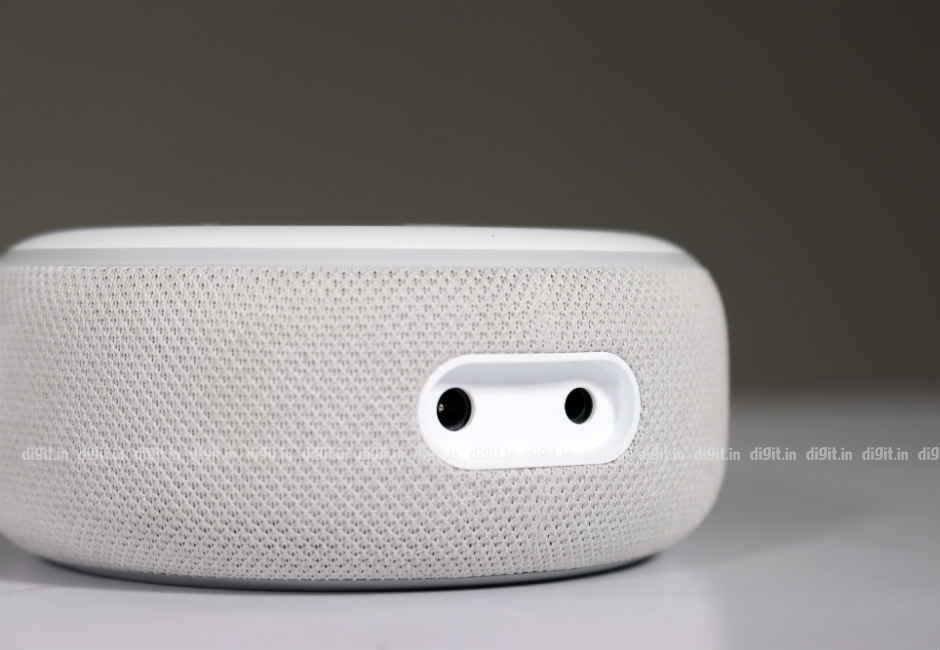
The 3.5mm audio output jack is a boon
Setting up the Amazon Echo Dot is as easy as setting up the Google Nest Mini, if not easier. The setup process, which typically takes up to twenty minutes to complete, requires you to install the Amazon Alexa app on your iOS/Android smartphone first. The display greets you with a quick ‘Hello’ when the device is powered on but doesn’t help with the setup process or display any other messages, which means you have to hook the Echo Dot up to your local Wi-Fi network using the app. That’s understandable because very little textual information can be communicated on the speaker’s four-character eight-segment LED units. If anything, the Amazon Alexa app could be more responsive. Whether it's on iOS or Android, the app is tiring to use.

Four-character eight-segment display is only to show the time
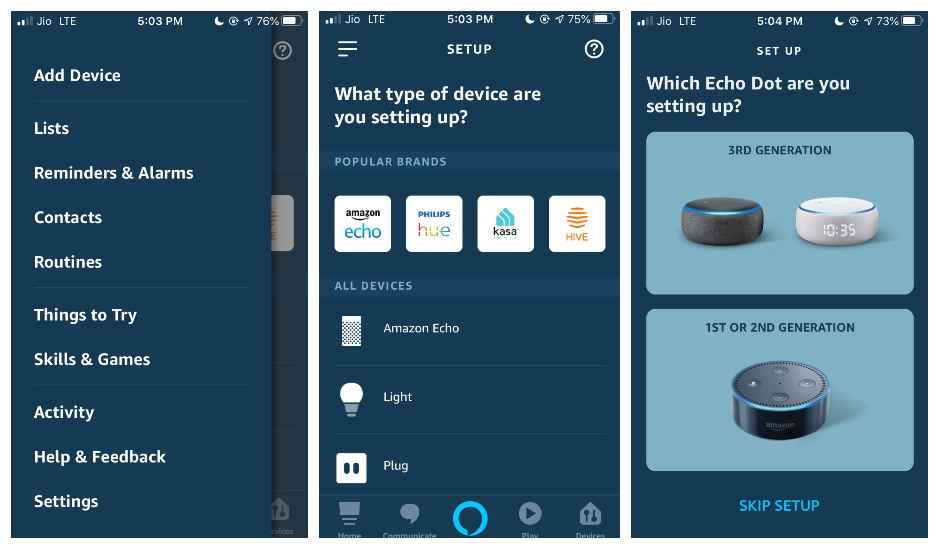
Amazon Alexa app is not always responsive
Once you’ve set the Echo Dot up, you can start using the speaker for simple questions such as, “How far is the moon?” and “Who is the President of India?” To book a taxi, you’ll have to go to the Skills & Games section of the Amazon Alexa app to enable the Ola and Uber skills. The same goes for other requests that need an Alexa Skill to be enabled beforehand. You can, in addition, hook up smart appliances to the speaker in the Settings section. You can even connect to a smartphone over Bluetooth, which will then allow you to use the Echo Dot like any other Bluetooth speaker. If you connect the Echo Dot to a pair of external speakers, then it will work as a Bluetooth receiver for your phone, in addition to following voice commands.
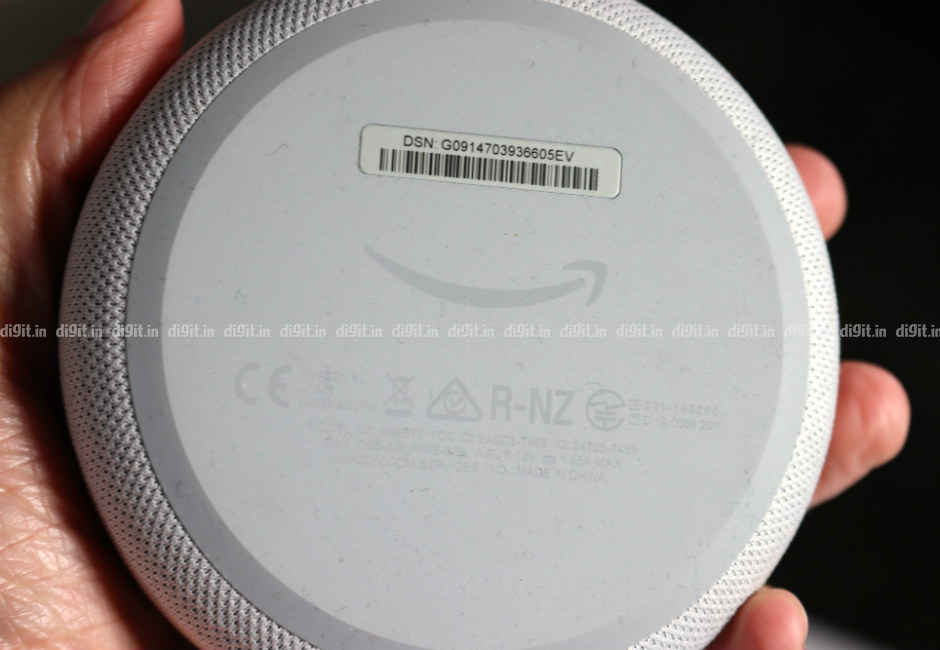
No wall mount on the clockless variant of the Echo Dot
Like all the other Echo products in Amazon’s stable, the Echo Dot is powered by the company’s proprietary digital assistant Amazon Alexa. On our review unit, the device responded to lusty ‘Alexa’ calls from as far as eight feet away but only in a quiet environment. It worked when the call was made from other rooms as well but only one out of two times. With music playing in the background, it was a little hard to get Alexa’s attention but not to the point where I had to yell when I was in the same room as the device. In other words, you’ll have very few problems reaching out to Alexa if you’re in the same room as the device. I’m happy to report that the whisper mode on the unit worked well for quiet responses. When I whispered, “Cancel all my alarms,” Alexa responded in an equally quiet tone, “Cancelling all your alarms.”
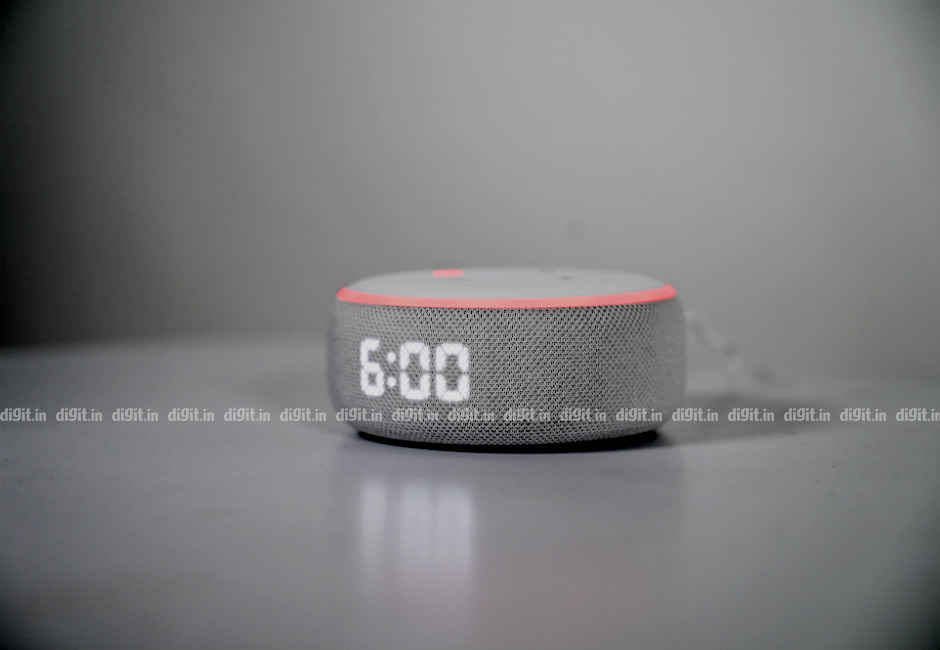
That's a nice and bright clock on the new Echo Dot
Apart from showing the time, the display on the front side of the Echo Dot tells you how much time is left on an active timer, when the next alarm will ring right after you’ve set it, and the current volume level when the volume buttons are pressed. The brightness of the display changes automatically based on ambient light, making it ideal for bedside use. In my experience, the Echo Dot is an ideal bedroom companion for help with everyday tasks such as ordering food, controlling nearby smart devices, and music playback. In my opinion, its physical buttons are nicer to operate than the haptic ones on the Google Nest Mini.
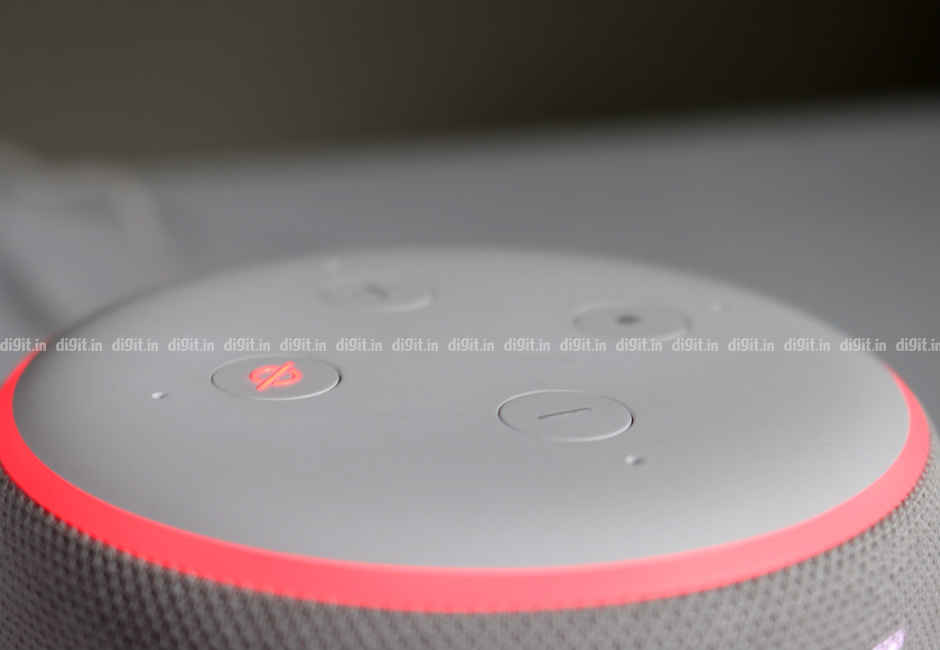
The etched physical buttons on the Echo Dot are easier to press than the haptic ones on the Google Nest Mini
The Echo Dot features a single 1.6-inch speaker driver, which works fine for Alexa’s responses and casual music playback. Compared to the louder and crisper-sounding unit on the Google Nest Mini, the speaker on the Echo Dot sounds muffled for most genres of music, especially pop. Lows are generally heard when the volume is maintained below 70 per cent but mids and highs don’t always make it. Luckily, the Echo Dot can be hooked up to a pair of external speakers using the 3.5mm jack on the back. This ability to connect to another audio source while retaining the smartness of Alexa is easily one of the Echo Dot’s best features.
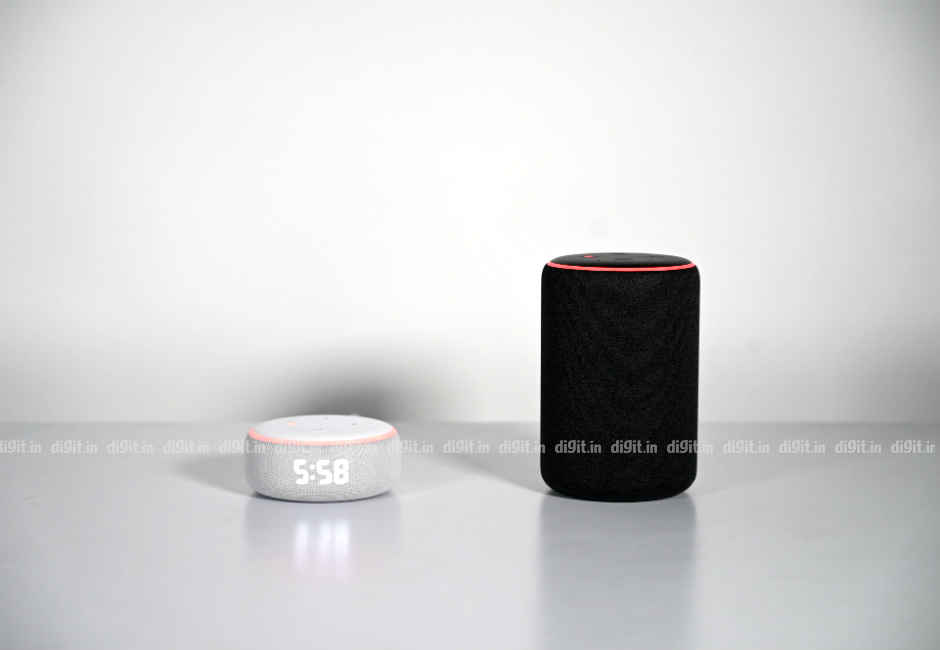
The little Echo Dot is no match for the Echo but does the job for casual music listening and voice commands
I got a chance to use Google’s recently launched Nest Mini around the same time I set the Amazon Echo Dot up for review, so I had enough room for comparison. I personally like the Echo Dot over the Nest Mini because Amazon’s Alexa is friendlier to talk to and can do more than Google Assistant can at the moment, such as connect to my Apple Music account for music playback. The Echo Dot, in my opinion, is also better aesthetically in that it has a handy display, a 3.5mm audio jack for audio output, and easy-to-press physical buttons. All things considered, the Amazon Echo Dot is a fine bedroom companion for music playback, nearby device control, and common tasks (such as taxi booking, etc). If anything, the variant with the clock is priced a bit too steeply.
| Price: |
 Rs. 4999
Rs. 4999
|
| Release Date: | 16 Dec 2019 |
| Variant: | None |
| Market Status: | Launched |
 Playback Time
Playback Time
 Frequency Range
Frequency Range
 Channels
Channels
 Dimensions
Dimensions








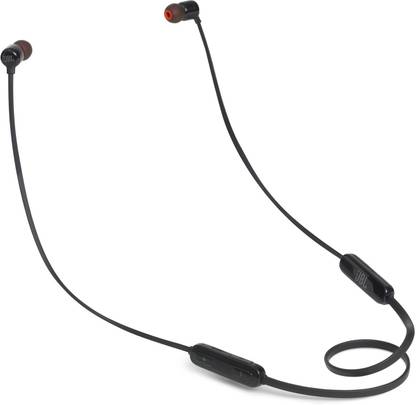

 4999
4999
 4999
4999

Digit caters to the largest community of tech buyers, users and enthusiasts in India. The all new Digit in continues the legacy of Thinkdigit.com as one of the largest portals in India committed to technology users and buyers. Digit is also one of the most trusted names when it comes to technology reviews and buying advice and is home to the Digit Test Lab, India's most proficient center for testing and reviewing technology products.

We are about leadership-the 9.9 kind! Building a leading media company out of India.And,grooming new leaders for this promising industry.

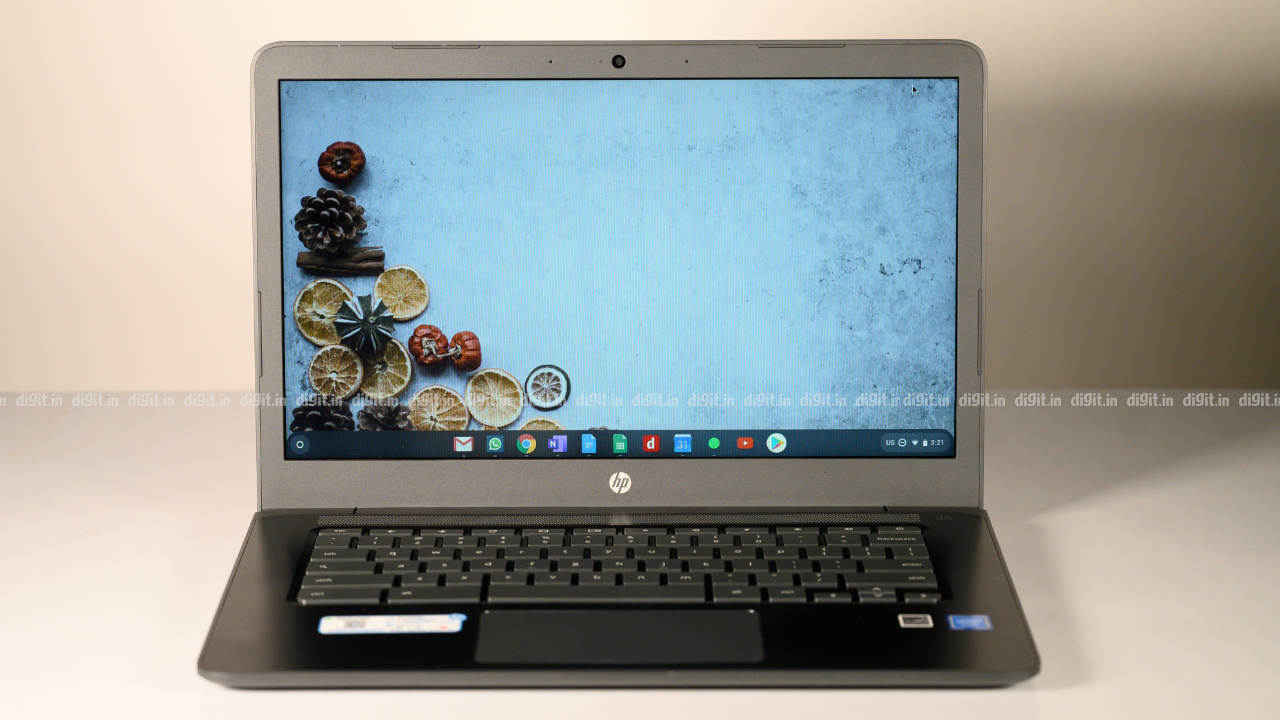
46
78
55
43
The HP Chromebook 14 can confidently handle light browsing, online document edits, and short video playbacks but not all at the same time. It delivers excellent battery life but is shy to multitask and offer higher speeds.
HP launched the Chromebook x360 in India a couple of months ago at a starting price of Rs 44,990. You can read our review of it here. While I was quite pleased to see HP launch a Chromebook in the country after a long gap, I was admittedly more kicked about the product it launched next. Just a few days after launching the Chromebook x360, HP launched the Chromebook 14 in India at a much more accessible price of Rs 23,990 (updated price: Rs 22,990). And that’s exactly the laptop on which I’m writing this review.
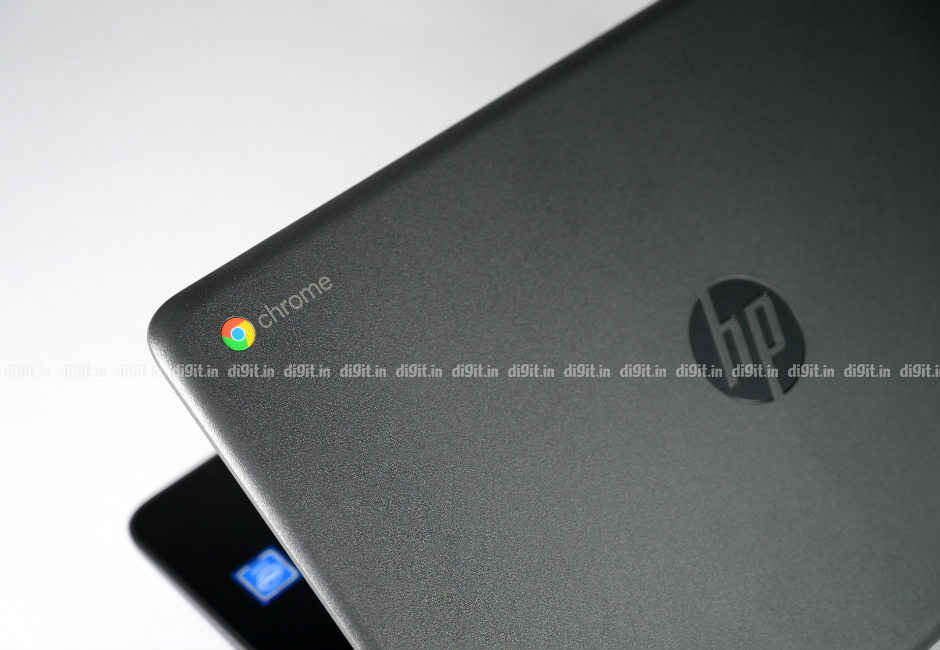
I was thrilled about the Chromebook 14 because I felt it had a significant role to play in the Indian entry-level laptop market. You see, unlike typical Windows 10 laptops in the same price range, the Chromebook 14 is not bogged down by heavy software or slow hard drives. It may come with a piddly 4GB of RAM, but it’s not burdened by a weighty operating system. It also sports a slightly faster storage unit in the form of a 64GB eMMC drive. This, I thought, should at least result in faster web-only computing than running Chrome on a typical Windows 10 laptop. Was I right? Let’s find out.
Our review unit came in the only configuration the Chromebook 14 is available in right now: Intel Celeron N3350 Dual-core CPU, 4GB RAM, and 64GB eMMC flash storage. After a week or two with the review unit, I was mostly pleased with the performance of the Chromebook 14 even though I was left wanting more speed from time to time. With the tab count not exceeding a dozen in total across all virtual desktops, the review unit loaded each page in less than five seconds. Some heavier pages (including Gmail) took a few seconds longer to load completely, but that delay can be chalked up to the low-cost Celeron chip inside. Playing videos on YouTube one at a time was no problem but multitasking with a video playing in the background often resulted in audio stutters.
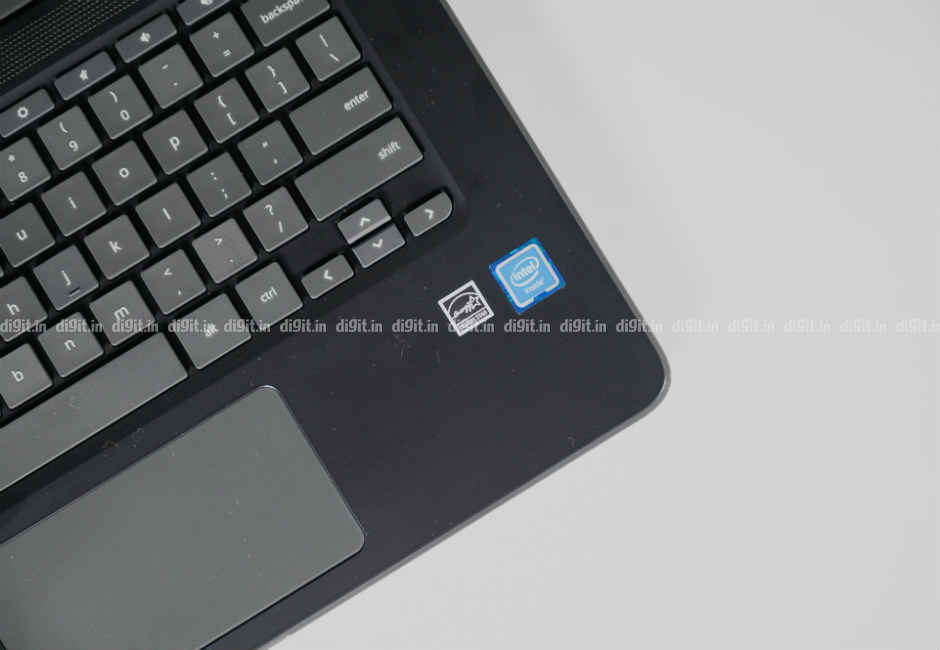
Intel Celeron inside
Accessing common websites such as Google Docs, Sheets, Keep, Gmail, Netflix, YouTube, and OneNote Online was no major problem unless multiple sites were being loaded simultaneously. The review unit was best suited to static work on a single window, such as composing a long document on Google Docs. Moving quickly from one tab/window to another or clicking on multiple links at once often resulted in a brief freeze or a series of stutter. A cold boot to the lock screen took approximately 11.46 seconds, and getting to the first Chrome tab from there took another 12.46 seconds, so that's 23.93 seconds in total.
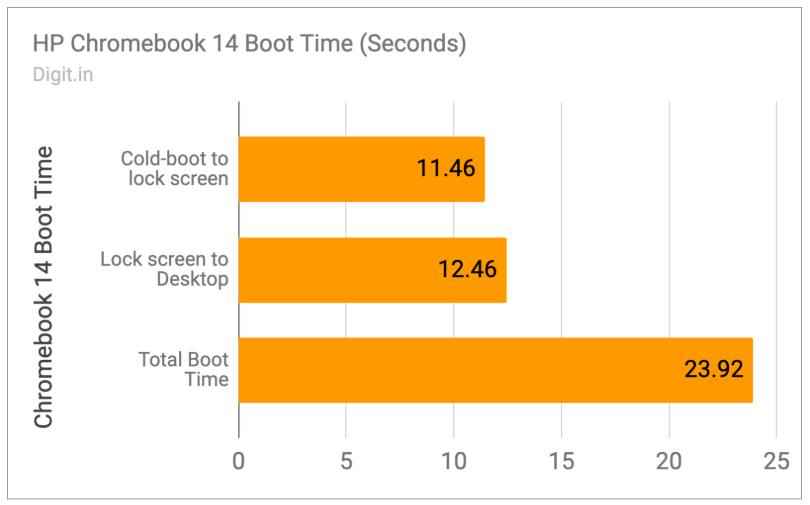
This grade of response, in my experience, is still better than that observed on other Windows 10-powered budget laptops out there in the market, including the new Lenovo IdeaPad S145 (read our review of it here). I’m willing to bet the Chromebook 14 will outpace every average budget Windows 10 laptop out there with the following (or similar) specs: Intel Core i3 CPU, 4GB RAM, 1TB hard drive spinning at 5,400 rpm. In other words, if all you want to do is browse on Chrome lightly and maybe watch a few videos without spending more than Rs 23,000, the HP Chromebook 14 is your best bet. It’s a device on which you can occasionally check your email, watch a few videos one at a time, and video-call your loved ones but that’s about it.
This is one distinct department in which the Chromebook 14 excels without a shadow of a doubt. During our everyday tests, where the screen is set to 70 percent brightness, Wi-Fi + Bluetooth are enabled, and a USB mouse is connected, the review unit consistently lost about 7–10 percent every passing hour. During one such test, there were over twenty tabs open, one of which played internet radio in the background through USB headphones. After about three hours, the charge fell from 100 to 74 percent. A full charge happened in about one and a half hours. To sum it up, the Chromebook 14 is great for anyone wanting to work away from the wall socket for about 8 or 9 hours continuously.
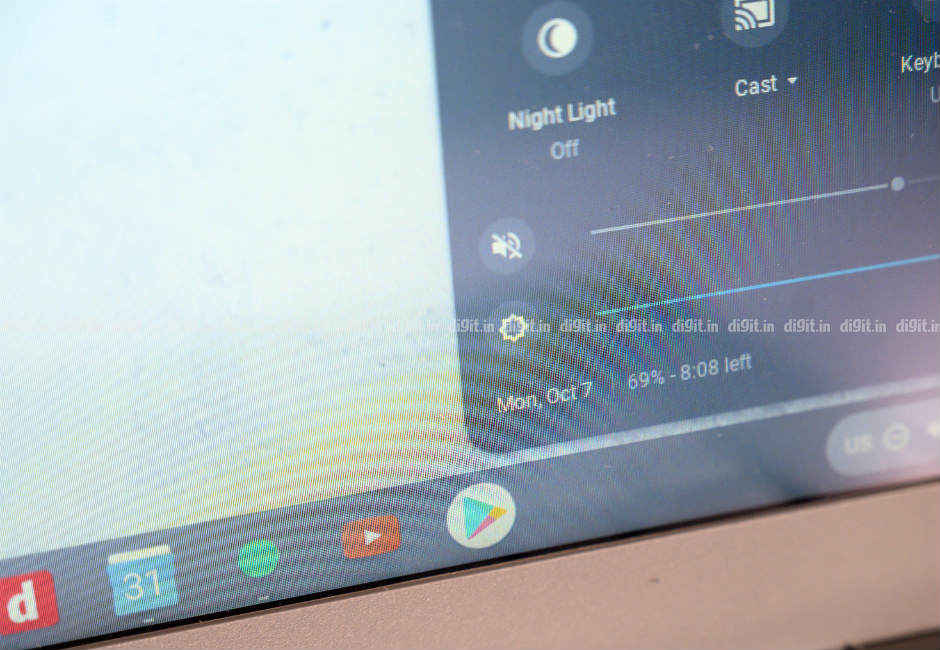
Expect 8 to 10 hours on battery power
The display on the Chromebook 14 is, as you can imagine, a 14-inch WLED-backlit LCD touchscreen unit with a depressingly low resolution of 1366 x 768 pixels. Colours on the display appear washed out and the viewing angles are severely limited. On the whole, text appears grainy on the panel no matter which font size you go with. The capacitive touch works well but there’s no palm rejection on offer in case you decide to annotate. Fortunately, the panel doesn’t suffer from too much glare as it does not use a glass surface. If anything, I wish the Chromebook 14 came with the option of a Full HD display.
The Chromebook 14, like its more expensive Pavilion and Spectre cousins, confidently sports a Bang & Olufsen logo next to the single top-firing speaker strip on its keyboard island. But the sound that emanates from the drivers inside simply doesn't do justice to that long-standing Danish name. Popular titles, like The Weeknd's Starboy, sound absolutely flat across all frequencies. Lows in particular end up sounding muffled at max volume. There's a fair amount of distortion heard even in videos with only vocals in them, leaving the speaker strip best used for message alerts.
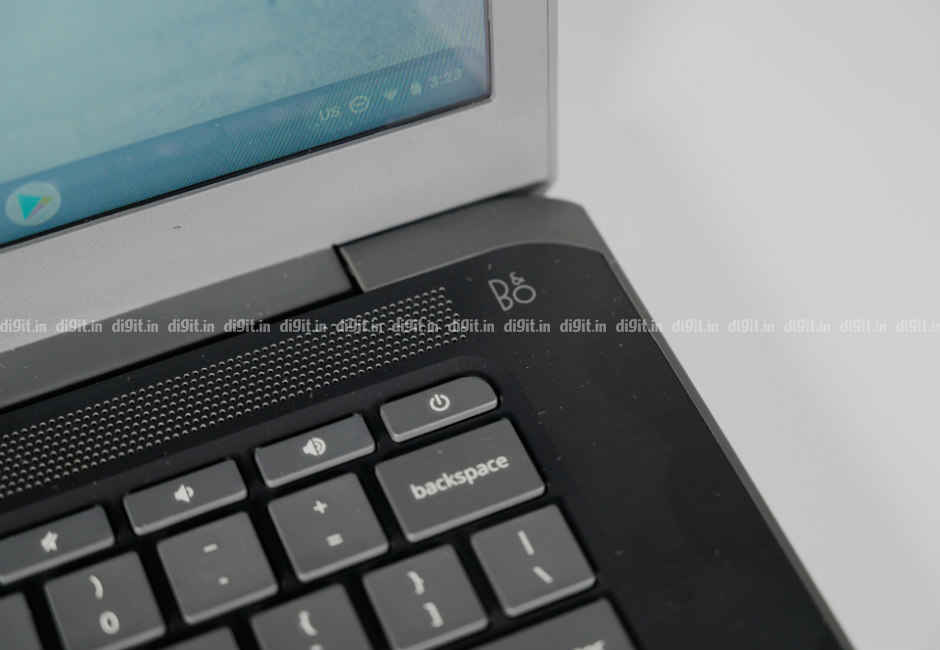
B&O badging is lost on this device with flat audio
The Chromebook 14 doesn't come with a very wide variety of ports but has the right stuff for USB mice and headphones. On the left side of its body, we see a USB-A 3.1 port and a USB-C 3.1 port along with a Kensington lock slot. On the right side, we see another USB-A 3.1 port, a second USB-C 3.1 port, a microSD card slot, and a 3.5mm audio jack for headsets. Because it's equipped with HP's Sleep and Charge technology, you can use the USB-A ports to charge a smaller device, like a smartphone, even when the laptop is turned off. Needless to say, the laptop skips the fingerprint scanner.
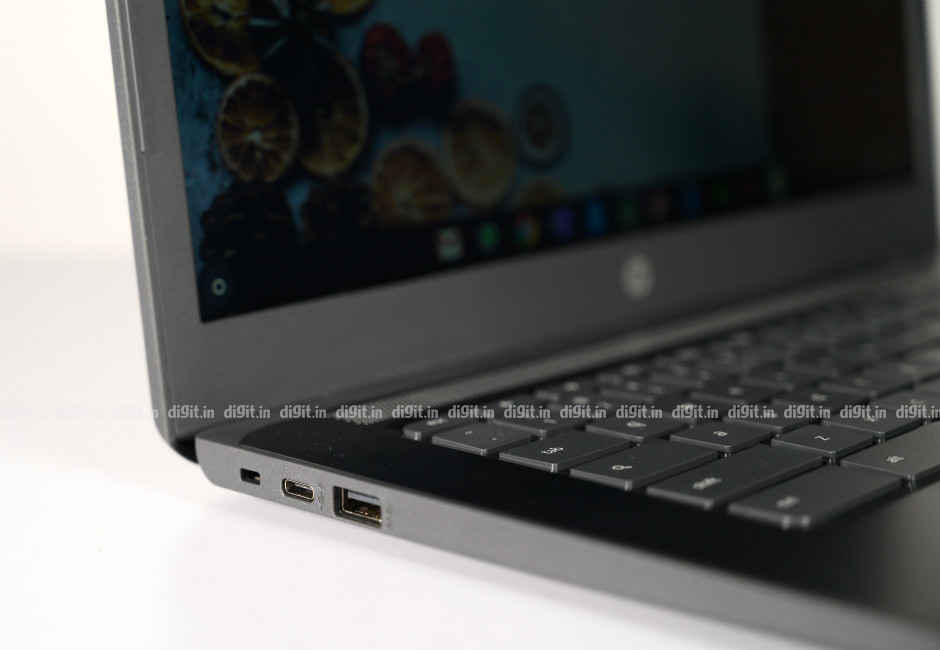
Two USBs on the left...
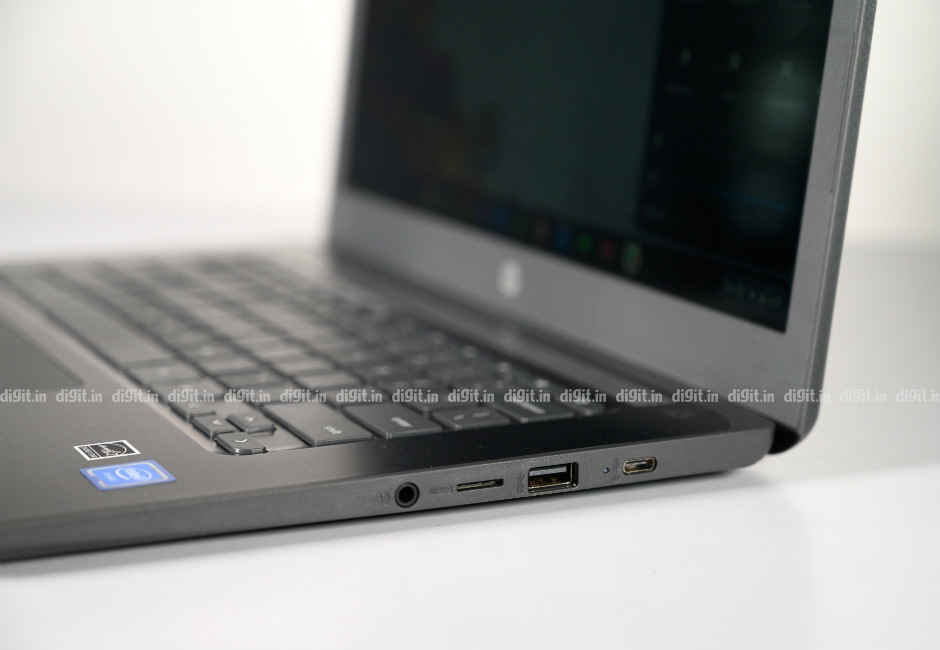
...and two more on the right
The keys on the Chromebook 14 are flat and totally unlit but offer sufficient comfort and feedback while composing long emails and documents. They have decent travel but could have done with a bit more distance. What's most annoying are the empty clicks you hear from the hollow surface below while typing hard on the keys. Yes, the entire keyboard island suffers from quite a bit of panel flex even under normal typing pressure. Unlike the more expensive Chromebook x360, the Chromebook 14 does not get a dedicated lock key on the top row of its keyboard. Instead, it gets a power button, which you have to press and hold to get the Chromebook running. Summing things up, the keyboard on the Chromebook 14 is good for everyday typing on a laptop of its price.
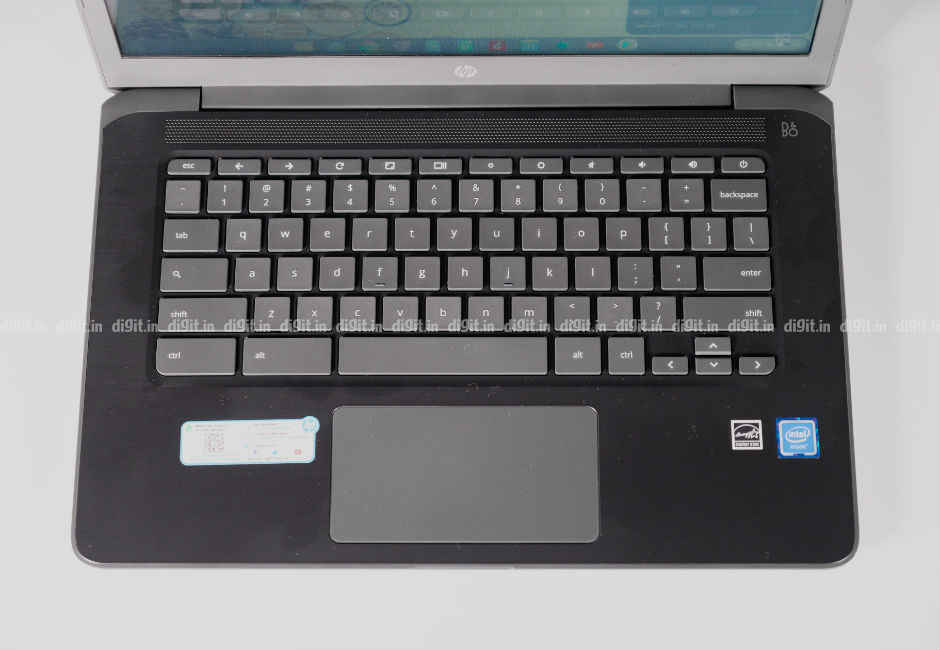
Decent keyboard + touchpad setup
The touchpad on the Chromebook 14 is as good as the laptop's keyboard. It's functional and sufficiently comfortable but nothing to write home about. The accuracy of pointer movements is somewhere between that of a Windows 10-recognised precision unit (seen on the likes of the Asus VivoBook X403) and a non-precision unit (seen on the likes of the Lenovo IdeaPad S145). What doesn't help improve the feedback is the coarse plasticky surface of the touchpad. Having said that, it's still a decent touchpad for everyday use. What's more, the two click keys beneath the touchpad surface are fairly easy to press.
The outer cover of the Chromebook 14 is made of hard plastic, which lends the device a sturdy and hardwearing look but also a perceptibly hollow feeling. This feeling of hollowness becomes apparent when you press down hard on the panels. The top cover sports a rough matte finish, which aids greatly in the user's grip over it. Opening the lid from one side reveals a good amount of panel flex, which is common in laptops of this price range. The Chromebook 14 sure looks like it can take the occasional drop but we recommend you treat it with ample care nonetheless.
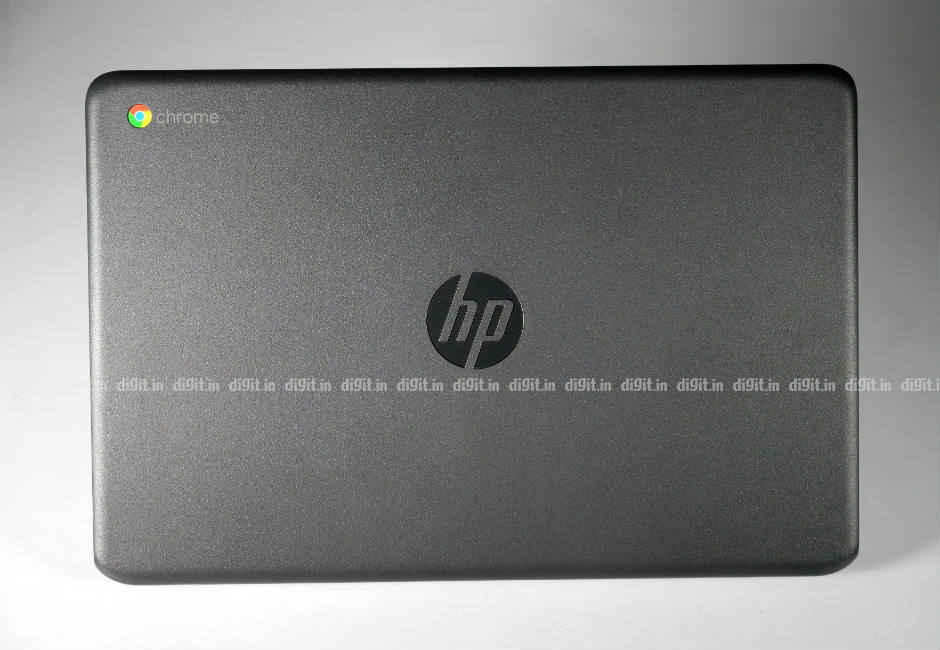
Hard-wearing matte look on the grey top cover
Opening the rather tight lid reveals a 14-inch touchscreen panel with a semi-glossy finish. The bezels around the display are fairly thick on all four sides, which gives the device is a slightly dated look. The display hinge folds all the way back to 180 degrees, a convenience found rarely in laptops of this price range. At 1.54 kilogrammes, the device is quite easy to carry around and doesn't eat up too much space in a typical laptop backpack. All things considered, the Chromebook 14 is built and designed quite well for its price.
The HP Chromebook 14 truly is a game-changer in the entry-level laptop market in that it gives the average user the freedom to browse and perform web-only tasks with a fair amount of responsiveness when compared to other Windows 10-powered models in its price range. What's more, it offers close to ten hours of battery life on Wi-Fi. But there are some apparent drawbacks: it's not very fast and it's shy to multitask, something that becomes evident the minute the tab count crosses eight or ten.
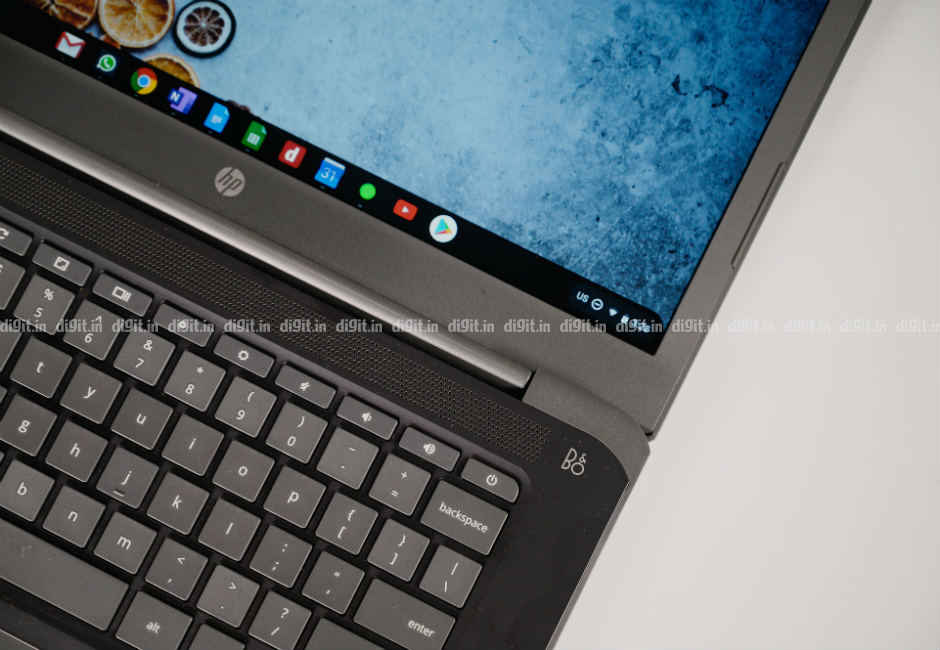
Who should buy the new HP Chromebook 14 then? Well, its ideal buyer is someone who needs a responsive budget laptop only for web-based activities, such as checking email, composing documents online, watching an occasional YouTube video, etc. They have a stable broadband connection at home and don't care if they miss out on access to Microsoft Word, Visual Studio, Edge, Paint, and a whole lot more. They're satisfied that their budget laptop doesn't take an entire decade to open up just one new browser tab.
| Price: |
 Rs. 22990
Rs. 22990
|
| Release Date: | 29 Aug 2019 |
| Variant: | None |
| Market Status: | Launched |
 OS
OS
 Display
Display
 Processor
Processor
 Memory
Memory






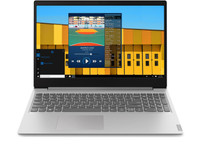




Digit caters to the largest community of tech buyers, users and enthusiasts in India. The all new Digit in continues the legacy of Thinkdigit.com as one of the largest portals in India committed to technology users and buyers. Digit is also one of the most trusted names when it comes to technology reviews and buying advice and is home to the Digit Test Lab, India's most proficient center for testing and reviewing technology products.

We are about leadership-the 9.9 kind! Building a leading media company out of India.And,grooming new leaders for this promising industry.

With 23 days to the governorship election, tension is currently brewing in Ondo State following the attack on the convoy of Governor Oluwarotimi Akeredolu by political thugs suspected to be loyalists of the candidate of the People’s Democratic Party, PDP, Eyitayo Jegede.
According to sources, the campaign train of Governor Akeredolu who is the candidate of the All Progressives Congress, APC was on transit through Oba-Akoko to Ikare-Akoko in Akoko North-East Local Government of the state when the incident happened.
Meanwhile, the PDP has said it was APC supporters who were in the convoy of Akeredolu that attacked the campaign train of Jegede when both convoys met at Oba-Akoko in Akoko South West.
Speaking on the development, the Spokesperson of Akeredolu/Aiyedatiwa Campaign Organization, Olabode Richard Olatunde said that the attack led to the burning of one of the campaign vehicles in the convoy of the governor adding that the driver of the vehicle sustained serious bodily injury.
“While we are shocked and saddened by this attack, we are not too surprised, because the PDP has shown that it is not focusing on issues in its campaign for the election. They will rather deploy violence and falsehood to score cheap political points.”
Meanwhile, 10 campaign vehicles in the convoy of Jegede were said to have been vandalised in the attack.
It was gathered that Jegede was at the palace of Oloba of Oba, Oba Nathaniel Adegoroye, the traditional ruler of the town, where he had gone to pay homage as part of his campaign visits to the town when the attackers allegedly struck.
According to the Publicity Secretary of the PDP, Kennedy Peretei, the attackers who were hooded stormed the location after alighting from the convoy of the governor.
Peretei alleged that neither Akeredolu nor the police operatives in the governor’s convoy did anything to stop the attackers.
“Everybody was taken by surprise. Aketi people were passing before they stopped abruptly, and before you could say Jack, these masked men rushed down and started breaking Jegede’s vehicles.
When contacted, the Police Spokesperson in the state, Tee-Leo Ikoro who confirmed the attack stated that mobile policemen have been deployed to the area on the order of the Commissioner of Police, Bolaji Salami.

RBI Governor Shaktikanta Das said economic recovery is likely to be gradual
Reserve Bank of India (RBI) Governor Shaktikanta Das said on Wednesday that the uptick noticed in the economy in the June-July period seems to have levelled off. The country's economy is likely to recover gradually, he said in a virtual address to members of industry body FICCI. His remarks come days after official data showed the country's GDP or gross domestic product crashed a record 23.9 per cent in the April-June period, as restrictions to curb the spread of the coronavirus pandemic hurt an economy already struggling against low demand and weakness in key sectors. Separate data this week showed retail inflation in the country eased marginally in August, but remained above the central bank's target range of 4-6 per cent for the fifth month in a row, supporting views that the RBI will avoid easing monetary policy further in its scheduled, bi-monthly review, due in October.

Dallas Stars goalie Anton Khudobin (35), Mattias Janmark (13), Alexander Radulov (47) and Jason Dickinson (18) celebrate their win over the Vegas Golden Knights during overtime NHL Western Conference final playoff game action in Edmonton, Alberta, Monday, Sept. 14, 2020. (Jason Franson/The Canadian Press via AP)
EDMONTON, Alberta: Inside a lounge at the JW Marriott usually reserved for their meals and meetings, the Dallas Stars enjoyed a moment.
It wasn’t an all-out party because they are still four wins away from winning the Stanley Cup. It was a low-key celebration of reaching the final, a significant accomplishment for a team that has been through some real challenges in recent years.
“To watch the staff, the players some guys that have never lived this before it was very exciting,” general manager Jim Nill said. Theres guys that have been on this team for a long time and never been this far. Its an exciting time for them. But we do know that there is one more step here yet.
The steps to this point included plenty of stumbles. Remember when CEO Jim Lites ripped captain Jamie Benn and top center Tyler Seguin for being terrible? That was December 2018. Or how about this past December, when the Stars abruptly fired coach Jim Montgomery for unprofessional conduct?
Add in being eliminated in a heartbreaking double-overtime Game 7 loss in the second round last season to eventual champion St. Louis, and things haven’t been easy for Dallas on or off the ice. That adversity is one major reason the franchise is in its first final since 2000.
Seguin said the Stars believe they are are never out of a game.
Theres just been so much stuff thats happened to us that we always seem to rise to the occasion, he said. Because of those experiences as a group, we have that confidence, that composure and that ability to get the job done when we need it most.
Not terrible for a team that made the playoffs just three times in the past 11 seasons. Since Nill took the reins in 2013, the Stars have four playoff appearances and are now in the final on their fourth coach in as many seasons after Rick Bowness took over for Montgomery.
Perhaps they wouldn’t have gotten this far if Montgomery were the coach, or if Nill picked one of his other two assistants with previous experience to take over. He chose the 65-year-old hockey lifer as the interim replacement because Bowness had been around an extra year. It has worked out.
Its been a crazy year for all of us and Im sure especially him, Benn said. To come in halfway through the year and jump right back into a head coaching role, it cant be that easy, but hes done a great job with us.
It wasn’t easy for Benn or Seguin to take criticism from Lites and others about their play and their big-ticket contracts. When they helped Dallas make the 2019 playoffs, that run ended with Patrick Maroon ‘s goal for the Blues in the second overtime one victory shy of the Western Conference final.
You learn from that, you get in those situations and that makes you stronger, makes you hungrier and thats where were at, Nill said. Youve got to learn to lose before you win.
Barry Trotz knows that well. The New York Islanders coach stepped into his previous job with Washington after the Capitals had absorbed six early playoff exits, and Trotz had three of his own before winning the Stanley Cup in 2018.
Theres very few teams in any sport (that) have sort of put a group together and theyve won a championship right away without maybe a little bit of failure on the way, Trotz said. “How you focus with defeat, how you pick yourself up after a tough loss or a game that doesnt go your way individually or collectively thats what builds winners or champions.”
To become champions, the Stars still need to win one more series. Barclay Goodrow and the Tampa Bay Lightning could next be up next.
Theyre in the Stanley Cup Final for a reason, said Goodrow, who played against Dallas the past several seasons while with San Jose. They defend hard. They just find ways to win. Its not a fluke why they made it to the finals.
After being outshot 166-118 by Vegas in the second round and leaning on goaltender Anton Khudobin to make some timely saves, the Stars aren’t apologizing for moving on to the final. Nill agreed with Goodrow that it’s not a fluke, and now his team gets to keep proving that.
“I definitely believe we deserve to be here,” he said. Our guys have stuck with it. They believe in themselves, theyre hardened and theyre resilient and thats what you have to be in the playoffs. Youre not going to make it very far in the playoffs if youre not resilient, and we have a resilient group of guys.
___
More AP NHL: https://apnews.com/NHL and https://twitter.com/AP_Sports
Manchester United manager, Ole Gunnar Solskjaer, could be without up to 11 players for their Premier League opener against Crystal Palace this weekend.
United were given an extra week to prepare for the 2020/2021 season, after their Europa League campaign run into August.
The Manchester Evening News reports that Paul Pogba, Juan Mata, Fred, Aaron Wan-Bissaka and Eric Bailly only returned to full training on Monday, while Bruno Fernandes started only days before.
Phil Jones is fit, but is unlikely to be selected, as he could leave Old Trafford in the coming days. Sergio Romero is in the same situation, but is yet to return to training as he seeks a move away.
Mason Greenwood is still training in isolation after returning to Carrington last week. The young striker was sent home from England camp after breaching COVID-19 guidelines in Iceland last week.
Axel Tuanzebe is definitely out for the visit of Palace, as he continues his recovery from a long-term injury.
Victor Lindelof and Anthony Martial are set to be assessed by United medical staff, after they went on international duty for Sweden and France respectively.

The ministry of home affairs had set up a committee for reforms in criminal laws this May. (File)
The Union home ministry has sought suggestions from governors, chief ministers, lieutenant governors, the Chief Justice of India and chief justices of various high courts on comprehensive amendments in criminal laws.
Union Minister of State for Home G Kishan Reddy told the Rajya Sabha today that a committee has been made under the chairpersonship of Delhi National Law University Vice-Chancellor to suggest reforms in the criminal laws.
"The Ministry of Home Affairs has also sought suggestions governors, chief ministers of states, lieutenant governors and administrators of union territories, the Chief Justice of India, chief justices of various high courts, the Bar Council of India, bar councils of various states and various universities and law institutes on comprehensive amendments in criminal laws," he said in a written reply to a question.
Reddy said the suggestions received and the report of the committee is subject to examination by the ministry in consultation with all stakeholders.
(This story has not been edited by NDTV staff and is auto-generated from a syndicated feed.)
UK Government officials says 'capacity is the highest it has ever been'

More coronavirus testing centre chaos has been reported at a North Wales facility.
Last night people expressed anger and frustration, after queuing for hours at the UK Government run testing centre, on Deeside Industrial Estate.
Then some said they still couldn't get a test because time had run out or a code wasn't sent to complete it and they were turned away.
On Twitter one person said: "My daughter was sent to Deeside,booked in, had the test done, but they didn't send her the pr code so the test was ruined and she has to go again tomorrow to Deeside."
Another said: "Just spent 3 hours in a 2 mile queue at Deeside drive in only to be told no test. Thousands sent message in error telling them they had 7pm appointment. Total shambles."
And another Twitter user added: "Absolute chaos trying to get a covid test (not me, I was driving) 2 days online before offered a test 20 miles away at Deeside. Then a two hour queue backing up the whole road for miles. No tests when you got to the front, apparently. We came home."

It comes after other North Wales problems booking tests and a school staff member being offered a test in Inverness, Scotland.
The Department of Health and Care (DHSC) have repeated problems are down to a huge demand for tests, including from people who do not need one.
A DHSC spokesman said: "NHS Test and Trace is working and our capacity is the highest it has ever been but we are seeing a significant demand for tests including from people who do not have symptoms and are not otherwise eligible.
“New booking slots and home testing kits are made available daily for those who need them and we are targeting testing capacity at the areas that need it most, including those where there is an outbreak, and prioritising at-risk groups.
“Our laboratories are processing more than a million tests a week and we recently announced new facilities and technology to process results even faster. If you do not have symptoms and are not eligible to get a test you can continue to protect yourself if you wash your hands, wear a face covering and follow social distancing rules.”

According to the DHSC an estimated 25% of tests are being booked by people who are no elligible and shouldn't be coming forward.
The number of test centres are also set to increase to 500 by the end of October.
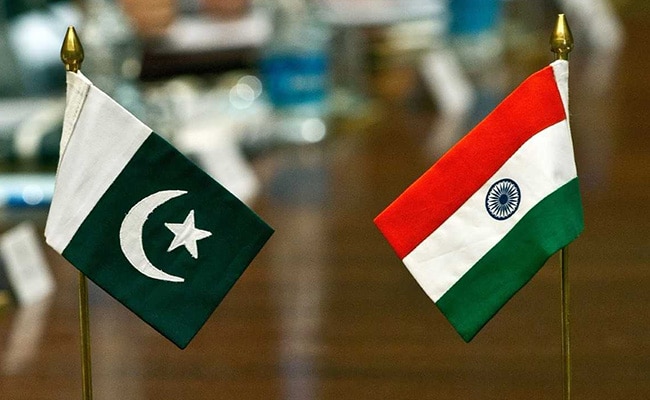
India also slammed Pakistan for abusing various HRC mechanisms (Representational)
India on Tuesday described Pakistan as an "epicenter of terrorism" and said no one deserves unsolicited lecture on human rights from Islamabad that has consistently persecuted its ethnic and religious minorities including Hindus, Sikhs and Christians.
Exercising the Right of Reply to the statements made by Pakistan at the 45th session of Human Rights Council (HRC), the Indian representative said that it has become habitual for Pakistan to malign India with false and fabricated narratives for its self-serving malicious purposes.
"Neither India nor others deserve this unsolicited lecture on human rights from a country that has consistently persecuted its ethnic and religious minorities, is an epicenter of terrorism, has the distinction of providing pensions to individuals on UN Sanctions list and has a Prime Minister who proudly admits training tens of thousands of terrorists to fight in Jammu and Kashmir," the Indian diplomat said.
The diplomat said that it was not surprising that other relevant multilateral institutions have been raising serious concerns on Pakistan's failure to stop terror financing and lack of effective actions against all terror entities in Pakistan.
Highlighting the nefarious designs of Pakistan in Pakistan-occupied Kashmir, the diplomat said, "the mass influx of outsiders has whittled down the number of Kashmiris to an insignificant number in Pakistan occupied parts of Indian Union Territories of Jammu and Kashmir and Laddakh."
"In its zeal to reassert its theocratic ideology, it has ensured that ethnic and religious minorities have no future through systematic persecution, blasphemy laws, forced conversions, targeted killings, sectarian violence and faith-based discrimination," the diplomat said.
"Thousands of Sikh, Hindus and Christian minority women and girls have been subjected to abductions, forced marriages and conversions in Pakistan."
On the plight of people in Balochistan, Khyber Pakhtunkhwa and Sindh, the Indian diplomat said, "Not a single day has gone by when a family in Balochistan doesn't find its members picked up or kidnapped by the security forces of Pakistan."
"Pakistan does well when it comes to intimidation and attacks against journalists, human rights defenders and political dissidents in particular by its state machinery. It is not without a reason that Pakistan has been highlighted by international organizations as a country where journalists are slain and their killers go scot free," the diplomat said.
India also slammed Pakistan for "abusing various HRC mechanisms and platforms for raising issues, which are extraneous to the mandate of the HRC and which relate to internal affairs of India, with a view to distract the attention of the international community from serious human rights violations committed by it against its own people, including in Indian territories occupied by it."
India also rejected the reference made by the Organisation of Islamic Cooperation (OIC) to Jammu and Kashmir, which is an integral part of India.
"The OIC has no locus standi to comment on internal affairs of India. The OIC has allowed itself to be misused by Pakistan to subverse its own Agenda. It's for the members of the OIC to decide if it is in their interests to allow Pakistan to do so," the Indian representative said.
India also advised Turkey to refrain from commenting on its internal affairs and develop a better understanding of the democratic practices.
(This story has not been edited by NDTV staff and is auto-generated from a syndicated feed.)
80
75
80
76
The Canon PowerShot G7 X Mark II is a great compact shooter. It delivers good colours, details and overall imaging performance, along with a few nifty features, upgraded dials and toggles and decent battery life, all at a compelling price point. While the Sony RX100 V does have a few more features up its sleeve, it retails at nearly double the price, which lends superior value for money to the G7 X II, which is priced at an MRP of Rs. 40,995.
For those who do not want the bulk and interchangeable lens factor of a DSLR and need a camera that delivers competent imaging quality in a small, pocketable frame, the Canon PowerShot G7 X Mark II is highly recommendable.
Compact cameras with 1-inch sensors have their own place in the imaging market. They are targeted at being fast, sharp shooters, without the hassle of changing lenses, and being small enough to fit in pockets quite easily. While Sony has held fort in this category with its iconic RX100 lineup, Canon has been thereabouts, too. While the first generation G7 X or even the G9 X were reasonably decent attempts, they had troubles in core performance, lens optics and a few other areas.
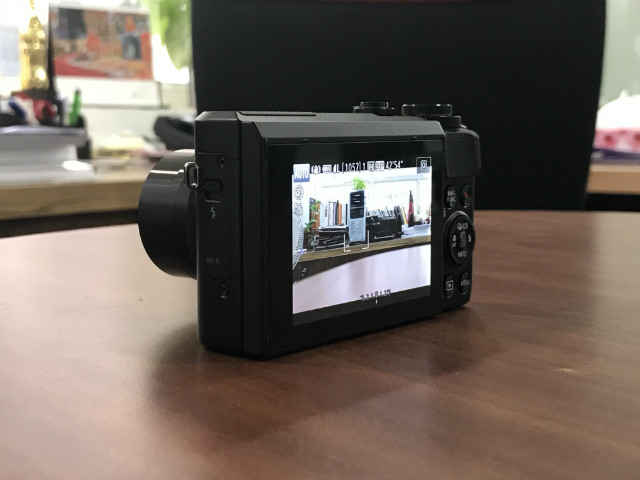
The PowerShot G7 X Mark II here, Canon’s second-round attempt at Sony’s behemoth RX100 lineup, is a pretty solid camera on paper. There are a number of notable upgrades, and Canon wants the G7X Mark II to be a camera that everyone would consider to be an essential in their travel kits. Does it hit the right chords?
Specifications
The two present generation compact cameras right now are the Sony CyberShot RX100 V, and the Canon PowerShot G7 X Mark II. Before we begin talking about the performance on offer, we look at what each of these have on offer.
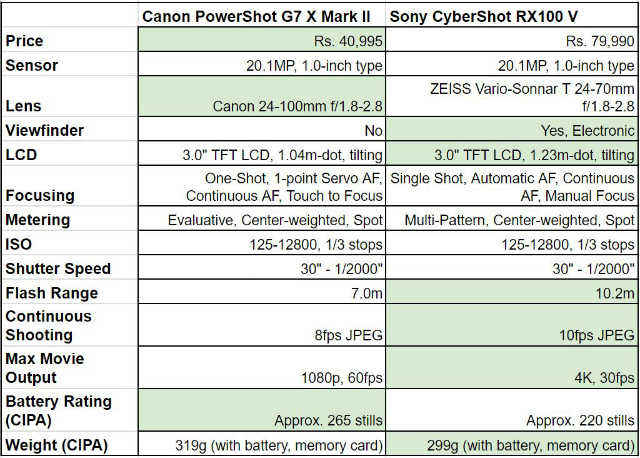
While the RX100 V does provide more in terms of continuous shooting, highest video resolution and even an electronic viewfinder within the compact, pocketable frame, the Canon G7 X II provides an equal bang for the buck on face of competition. As against older compatriots like the Sony RX100 IV, Canon’s inclusion of the latest generation DIGIC 7 image processor is a benefit, as it gives a good edge in terms of processing, autofocus and more.
Performance
Colour, saturation, white balance
The colour production of the PowerShot G7X Mark II is largely typical of Canon’s warmer tone. Colours look sharp, although reds seem to get an unnatural amount of favour. Yellows, blues and particularly greens look slightly undersaturated, particularly in rich, vibrant compositions. However, they do not look bleak, and you can opt to shoot RAW for post-shooting rectification. The new DIGIC 7 processor allows better, faster shooting of RAWs, and the G7 X II also produces lesser noise and better dynamic range, all of which lead to making this camera one of the most useful compacts out there today.
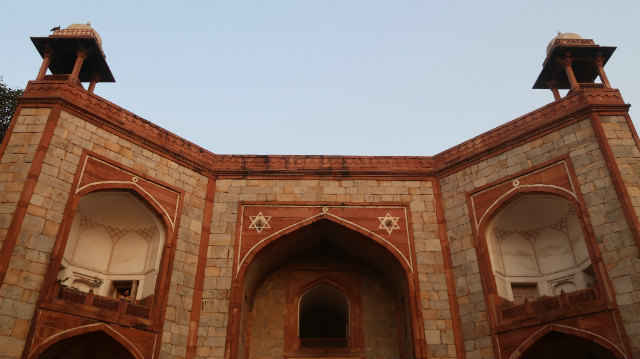
To clarify, the colours are fairly accurate and good to look at, losing out on a certain richness of tone in its JPEGs. Saturation levels are biased towards high colour temperatures, and the white balance algorithms work fairly well. Here too, the camera tends to adjust to warmer temperatures, which can be rectified by using the custom manual presets. Despite the better dynamic range, the Canon G7 X II produces a slightly limited range of colours, but you only realise this when you shoot in an extensively vibrant atmosphere, and compare results parallely.

For reference, seeing that the average Indian user is more inclined towards a basic DSLR than a premium compact, our comparison between the Nikon D3400 and the Canon PowerShot G7 X Mark II revealed the differences that show slightly limited dynamic range.
Details, sharpness, noise and ISO
Canon has significantly improved the level of details, sharpness, noise reduction and ISO performance over its previous generation compacts. There is decent levels of coarse details that work in wider frames, although macro shots do reveal the lack of fine details. The improved sharpening here works for most objects, although it does appear rather coarse upon finer inspection.

This also lends edgy outlines in certain cases, particularly in falling light. Despite that, the G7 X II is actually a fairly remarkable performer in terms of detailing and object sharpness in most scenes. You also get a dedicated Picture Styles mode to adjust sharpening strength, feathering and threshold, allowing control over sharpening radius.

Yet another impressive element is noise reduction, and the Canon G7 X II does fairly well in low ISO shots. Lowering noise reduction levels do not ruin photos with grains, and even in low light, although soft edges are recurrent, the G7 X II manages to retain colour accuracy, not rendering unusable noise levels beyond ISO 3200.

ISO performance is also decent, and you can shoot comfortably at up to ISO 1600 without much difficulty. Low ISO performance does not generate banding in uniform colours on low light, and flash range also extends up to 7.0m at ISO 100, which is fairly decent. You can also adjust the angle of the pop-up flash module to bounce flash against walls, which is a neat addition.
Autofocus
As before, the autofocus performance still has a couple of weak areas. For one, letting go of the half-shutter-press while tracking a subject leads to the camera failing to recognise subject movement, and takes significantly long to attempt refocus. The phase detection pixels also struggle with macro focusing consistency, and gets particularly confused if there are distinct shapes or sharper colours in the background.

Full continuous autofocus on the Canon PowerShot G7 X Mark II can be obtained with the 1-shot Servo AF, and this works fairly well. Constant subject tracking works well with swift moving objects. However, this can significantly reduce battery life if you use it extensively. The autofocus performance is fairly decent, and just in case the autofocus fails to work for you, the inclusion of a smoother rear ring facilitates easier manual focusing.
More camera samples
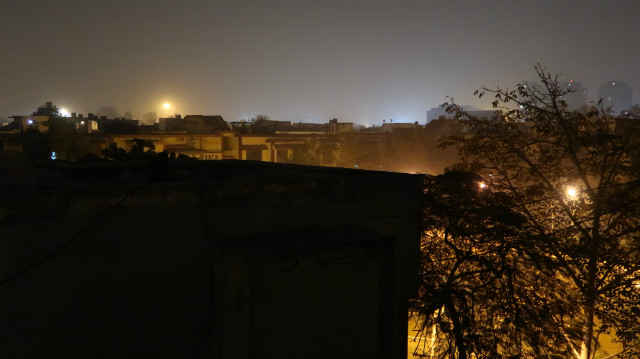



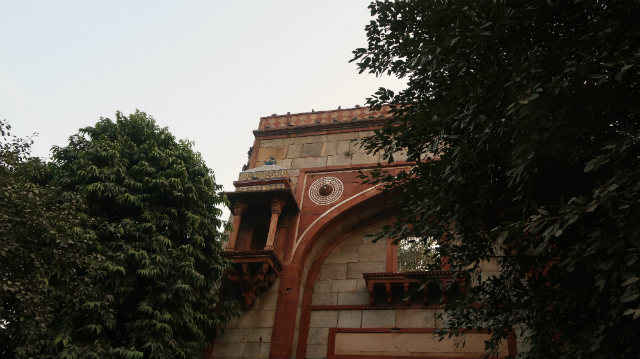

Build, Design and Ergonomics
The Canon PowerShot G7 X Mark II is marginally more compact than its predecessor. In what is an important little addition, it adds a small grip to the right of the camera body. This makes it easier to hold. The power button, zoom toggle, mode and EV compensation dials are on the top, and are fairly easy to operate.
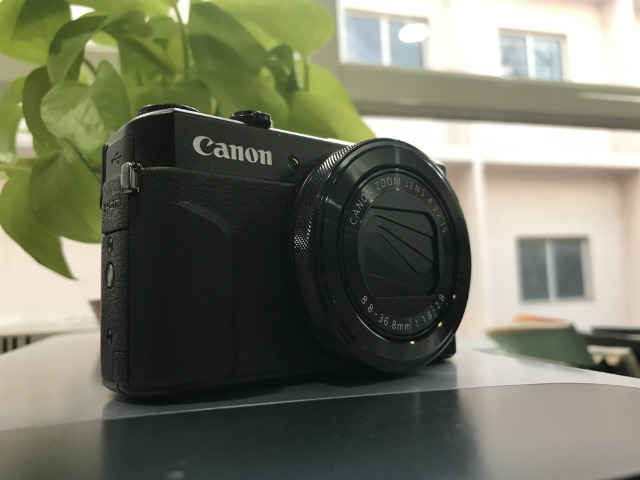
You also get a small thumb grip on the rear that makes shooting much easier. There is also a shortcut to assign a specific function to the front ring, and the video recording button is placed here as well. Talking about the ring, it now gets a lock that allows it to be switched between smooth or stuttered operation. This makes manual focusing on the G7 X II significantly easier, and you can use the stuttered mode when sifting through settings.
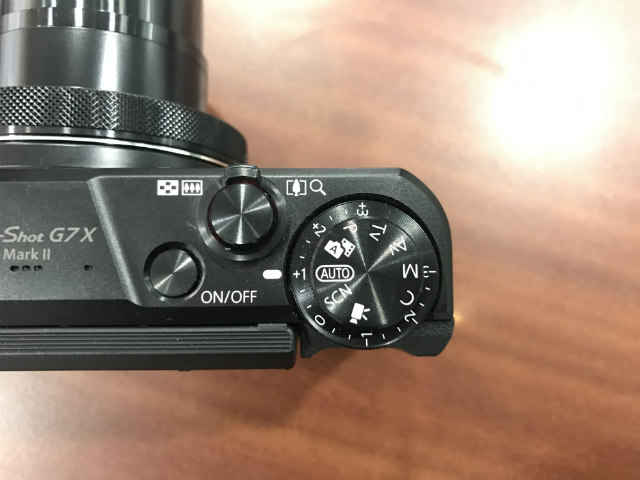
Another neat decision by Canon is shifting the display hinge to the bottom, and it can now be tilted downward by 45 degrees, instead of just being tilted upward. All of these make the camera more ergonomic and easier to use, and its 319g weight is not too much on pockets. The design also gets more defined edges thanks to the added grip and slightly reduced bearings, all of which make it look, feel and operate quite well.
Connectivity and Battery life
The Canon G7 X II gets Wi-Fi and NFC connectivity. You will need the Canon CameraConnect app on your phone, and use it to transfer files on the go, or use your phone as a remote for the camera. For NFC-enabled Android users, choosing the NFC mode and tapping the phone on the bottom of the camera body transfers the photo being displayed on the camera LCD at that moment.
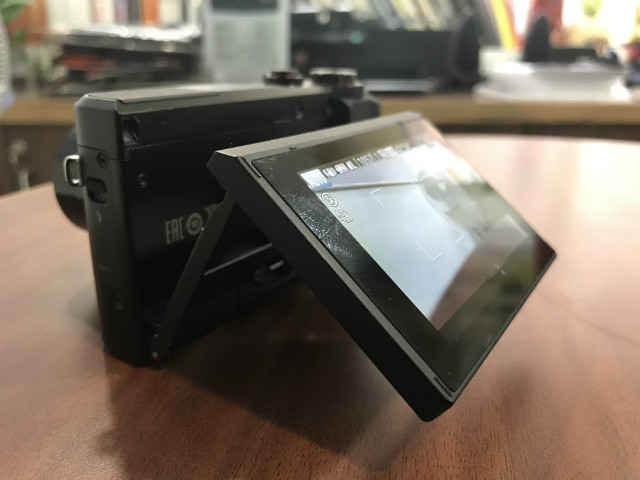
The battery cycle for the Canon PowerShot G7 X Mark II lasts for nearly 300 shots, which is somehow more than what the company advertises. This translates to about three full days of shooting with it for most casual/tourist photographers. This is fairly average, and is actually more than its prime market rival, the Sony RX100 lineup.
Bottomline
The Canon PowerShot G7 X Mark II is a great compact shooter. It delivers good colours, details and overall imaging performance, along with a few nifty features, upgraded dials and toggles and decent battery life, all at a compelling price point. While the Sony RX100 V does have a few more features up its sleeve, it retails at nearly double the price, which lends superior value for money to the G7 X II, which is priced at an MRP of Rs. 40,995.

For those who do not want the bulk and interchangeable lens factor of a DSLR and need a camera that delivers competent imaging quality in a small, pocketable frame, the Canon PowerShot G7 X Mark II is highly recommendable.
| Price: |
 Rs. 35999
Rs. 35999
|
| Release Date: | 28 Feb 2017 |
| Market Status: | Launched |
 Resolution
Resolution
 Shutter Speed
Shutter Speed
 ISO
ISO
 Optical Zoom
Optical Zoom

Digit caters to the largest community of tech buyers, users and enthusiasts in India. The all new Digit in continues the legacy of Thinkdigit.com as one of the largest portals in India committed to technology users and buyers. Digit is also one of the most trusted names when it comes to technology reviews and buying advice and is home to the Digit Test Lab, India's most proficient center for testing and reviewing technology products.

We are about leadership-the 9.9 kind! Building a leading media company out of India.And,grooming new leaders for this promising industry.

Hello and welcome to our live coverage of the final ODI of the series between England and Australia. The series is level at 1-1 and both teams will plan to end the English summer on a high.
Hello and welcome to our live coverage of the final ODI of the series between England and Australia. The series is level at 1-1 and both teams will plan to end the English summer on a high.

England vs Australia, 3rd ODI Live Score, Old Trafford, Manchester, Latest Updates: Hello and welcome to our live coverage of the final ODI of the series between England and Australia. The series is level at 1-1 and both teams will plan to end the English summer on a high.
Second ODI Report: Australia collapsed from a position of victory in a moderate chase as England leveled the series with a 24-run victory in Manchester in the second One-Day International.
Australia were chasing 232 and were cruising at 144 for 2 before Jofra Archer and Chris Woakes, and then Sam Curran, created mayhem in the middle overs. From there, Australia slipped to 147 for 6 and eventually 207 all out. Archer, Woakes and Sam Curran got three wickets each.
Australia's chase started on the wrong note courtesy a terrific spell by Archer. The pacer got David Warner yet again, the opener nicking to the keeper for just 6 in the fourth over.
Soon, Marcus Stoinis was undone by a snorter of a short ball from Archer in the eighth over, the well directed bouncer lobbing straight off the bat to the keeper. Australia were 37 for 2 and England were right in the game.
However, Aaron Finch and Marnus Labuschagne steadied the ship with a sturdy partnership. Finch got past his fifty, and the partnership reached 107 but the game change rapidly in a space of four overs.
Labuschagne fell to Chris Woakes, lbw two runs short of his half-century with Australia 144 for 3. In the very next over, Archer bowled Mitchell Marsh, after which Woakes got the big wicket of Finch, bowled for 73, to leave Australia 145 for 5. That became 147 for 6 when Glenn Maxwell missed a straight one from Woakes.
Pat Cummins attacked with a six off Adil Rashid but Sam Curran struck twice in two balls to dent Australia further, dismissing Cummins and Starc to leave Australia 166 for 8.
Australia need 60 off 48, and then 37 from 18, with Alex Carey fighting at one end, but the task was too stiff without support from the other end.
Earlier, Adam Zampa proved a thorn in England's side again as Australia restricted the world champions to 231-9.
The leg-spinner took 3-36 from a maximum 10 overs to follow his 4-55 during Australia's 19-run win in Friday's first of a three-match series.
England captain Eoin Morgan top-scored with 42 but could not prevent his side slumping to 149-8 in the 41st over.
But a ninth-wicket partnership of 76 between the recalled Tom Curran (37) and Adil Rashid (35 not out) kept England in the game.
Rashid pulled fast bowler Pat Cummins for six before last man Jofra Archer ended the innings with a four off Mitchell Marsh.
Left-arm fast bowler Mitchell Starc enjoyed an early strike when he had Jonny Bairstow caught behind for a duck.
Jason Roy hit three fours in an over off fast bowler Josh Hazlewood -- an off-drive, a whip shot through square leg and a square-cut.
But his promising 21 ended when he was run out by Marcus Stoinis' direct hit from cover as Test captain Joe Root, struggling for runs, set off for a risky single.
A change of bat saw Root hit two fours off Cummins and his pulled six off Stoinis brought up a fifty partnership with Morgan.
Zampa, however, struck third ball when Root edged a well-flighted delivery to Australia captain Aaron Finch at slip to end an innings of 39 off 73 balls.
Left-hander Morgan hit fours off successive Zampa deliveries and Finch, with Jos Buttler in, recalled Cummins.
His move was vindicated when Cummins had Buttler lbw for just three.
Zampa had Morgan lbw on review to end a relatively fluent 52-ball innings and then had Sam Billings, fresh from his maiden ODI hundred on Friday, chopping on for just eight.
| Rank | Team | Points | Rating |
|---|---|---|---|
| 1 | Australia | 6047 | 275 |
| 2 | England | 5959 | 271 |
| 3 | India | 9319 | 266 |
| 4 | Pakistan | 6009 | 261 |
| 5 | South Africa | 4380 | 258 |
| FULL Ranking | |||

File photo of Union Minister Nitin Gadkari. (Photo: PTI)
Union Minister Nitin Gadkari on Wednesday said he has tested positive for the coronavirus infection and has isolated himself. He also appealed to those who have come in contact with him to get tested.
"Yesterday, I was feeling weak and consulted my doctor. During the course of my check-up, I have been tested COVID-19 positive. I am at present doing well with the blessings and good wishes of all. I have isolated myself," said the Union Minister of of Road Transport and Highways in a tweet, urging those who have come in contact with him to undergo tests.
Yesterday, I was feeling weak and consulted my Doctor. During the course of my check up, I have been tested COVID 19 positive. I am at present doing well with the blessings and good wishes of all. I have isolated myself.
— Nitin Gadkari (@nitin_gadkari) September 16, 2020
Gadkari is the latest Union minister to have tested positive for the infection. Union Home Minister Amit Shah had also contracted the virus, recovered recently and was discharged from AIIMS Delhi.
The news about Gadkari's infection came on the day when Lok Sabha MP from Tirupati, Balli Durga Prasad, died of Covid-19. The YSRCP leader, who was 64 years old, was undergoing treatment for coronavairus at a private hospital in Chennai.
Before the start of the Monsoon Session of Parliament on September 14, 17 MPs tested positive for coronavirus in mandatory tests. As many as 12 MPs from the BJP, the most from any party in Lok Sabha, were found infected during the test followed by the YSR Congress's two MPs and one each of the DMK, the Shiv Sena and the RLP.
The Lok Sabha members were tested at the Parliament House on September 13 and 14 -- during a mandatory test for those attending this year's Monsoon Session which will end on October 1.
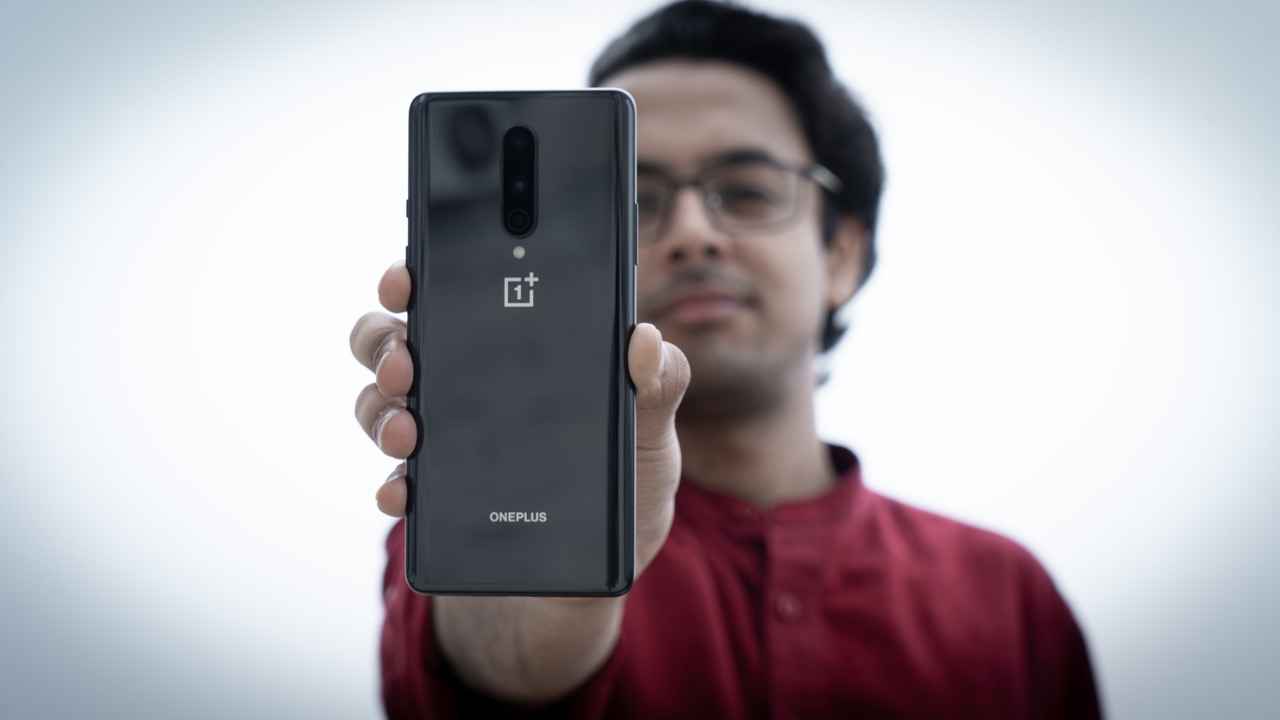
73
77
75
74
OnePlus 8 nails the essentials which makes it a pretty well-balanced offering from the company. Notwithstanding the unsettled camera performance, it remains a powerful performer with the smoothest Android experience currently available in the market.
OnePlus 8 is a flagship smartphone with the right amount of brains and brawn, part of the OnePlus 8 series and the younger sibling of the OnePlus 8 Pro. OnePlus’ flagship smartphones have really come of age with these two new products that aim to give you the slickest Android experience while building upon fundamentals established by the previous “flagship killers”. Words like speed, fluidity and robust performance have become synonymous with OnePlus smartphones from a while now, but with the OnePlus 8, we get to see a smartphone that stands tall when it comes to the essentials and redefines what it means to be a flagship phone in this day and age.
OnePlus 8 is a powerful performer as you’d come to expect with any OnePlus phone. At the heart, lies the Qualcomm Snapdragon 865 chipset with inbuilt 5G modem powered by OxygenOS 10 that provides arguably the slickest Android experience on a phone yet. It has an octa-core CPU that is clocked at upto 2.84 GHz and Adreno 650 graphics processor, paired with upto 12GB RAM and 256GB storage.
It’s fast and responsive and the 90Hz refresh rate ensures that every element in the UI, be it animations or transitions, plays out smoothly.
When it comes to benchmarks, the OnePlus 8 scored 576820 points on AnTuTu 8.0 tests which is higher than OnePlus 8 Pro, Mi 10 and Realme X50 Pro and is only bested by the iQOO 3 5G.
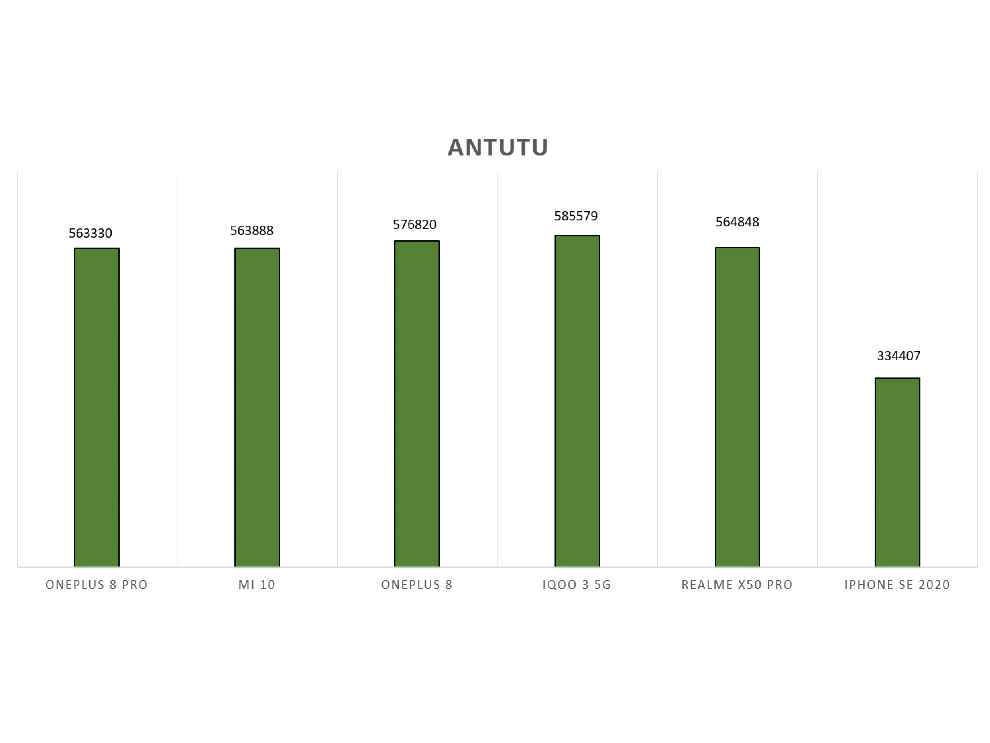
In GeekBench 5 CPU tests, the OnePlus 8 got a single-core score of 914 points and 3358 points in multi-core tests. Here again, the phone leads the scoreboard along with iQOO 3.
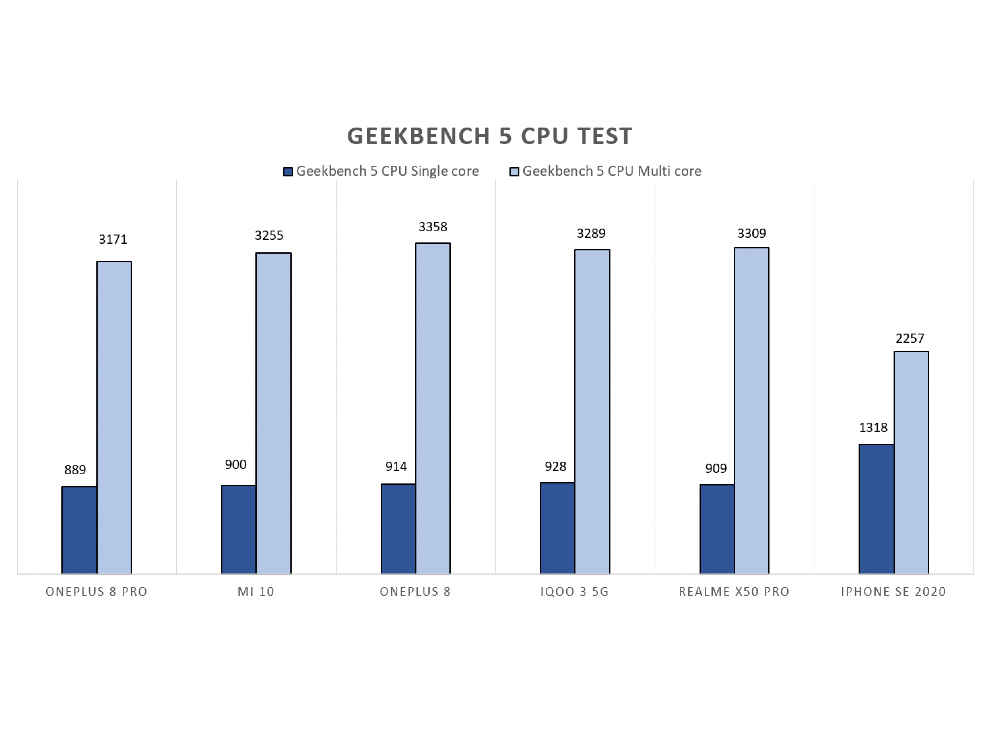
We found similar results when we ran the 3D Mark Slingshot Extreme test on the phone which awarded it 7243 points in OpenGL tests and 6704 points in Vulkan tests.
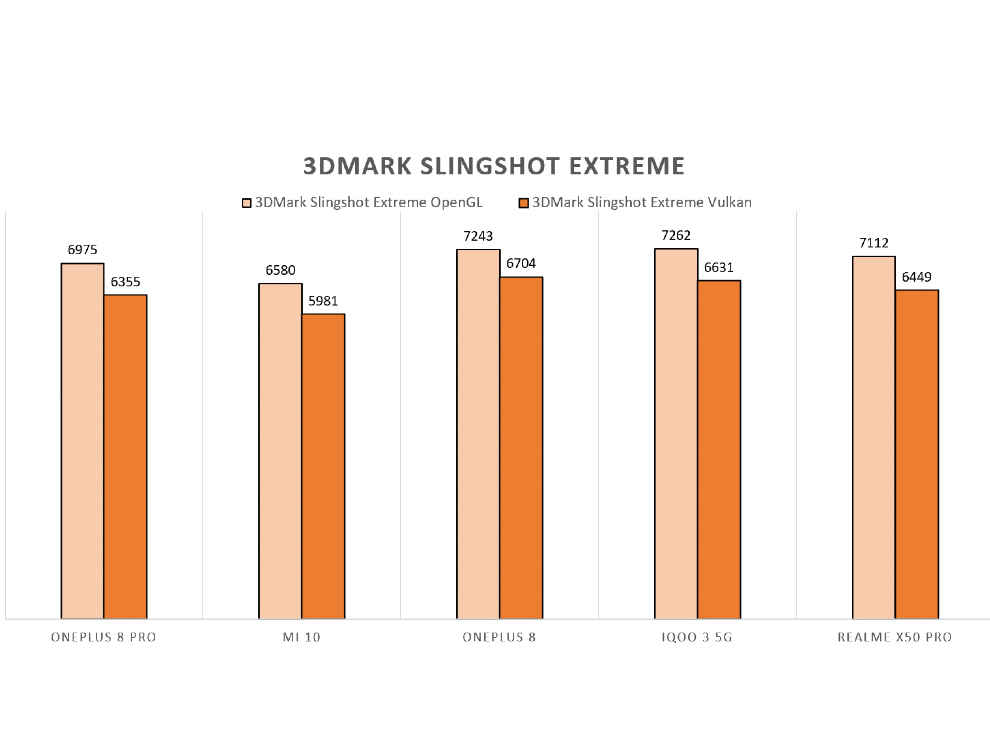
As it stands, the OnePlus 8 is a supremely powerful phone when it comes to sheer raw power as it is around 22-24 per cent more powerful than the OnePlus 7T. This also means that you can expect a steadfast performance from OnePlus 8 in the long run and it wouldn’t disappoint.
Gaming Performance
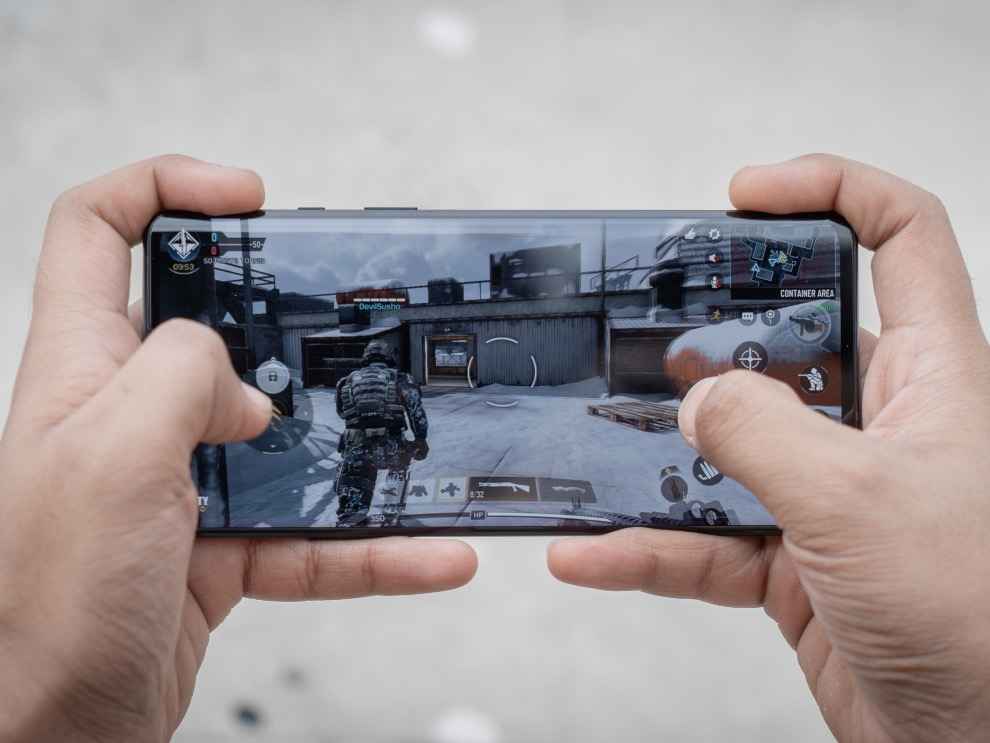
With the OnePlus 8 running on the latest Snapdragon chip under the hood, there’s no question of the chip to falter when running existing gaming titles. It does it all without breaking a sweat and it is a delight to play games on the OnePlus 8.
For our brief test, we played a couple of rounds of PUBG Mobile, Call of Duty: Mobile, Forza Street and LifeAfter to get a sense of how the OnePlus 8, with all its might, performs when running some graphic-intensive titles. We recorded the performance metrics using GameBench and all the games ran without any apparent hiccups.
The phone was able to run COD Mobile and PUBG Mobile at 60FPS with 95% stability with the prime core rarely being used during the gaming session. It’s just how OnePlus has optimized its software with the hardware as the CPU never reaches its full potential because there’s just no use for it to power through apps and games because the other seven cores are able to deliver a sustained performance which goes a long way in ensuring the longevity of the phone.
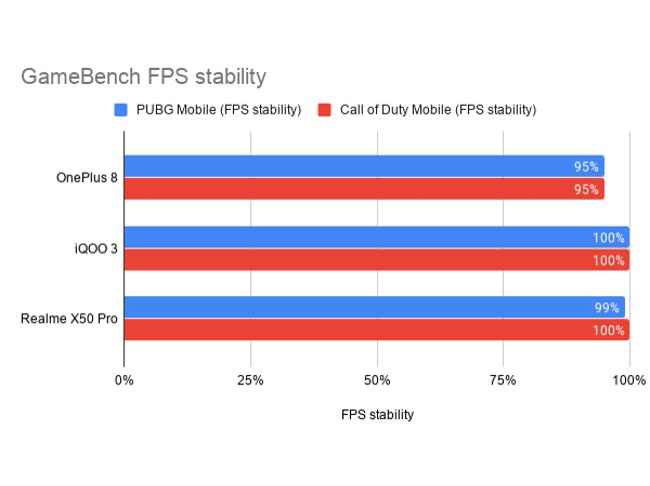
You can read more about our comprehensive gaming test of the OnePlus 8 Pro where we also compare it against the iQOO 3 and Realme X50 Pro.
Software Performance
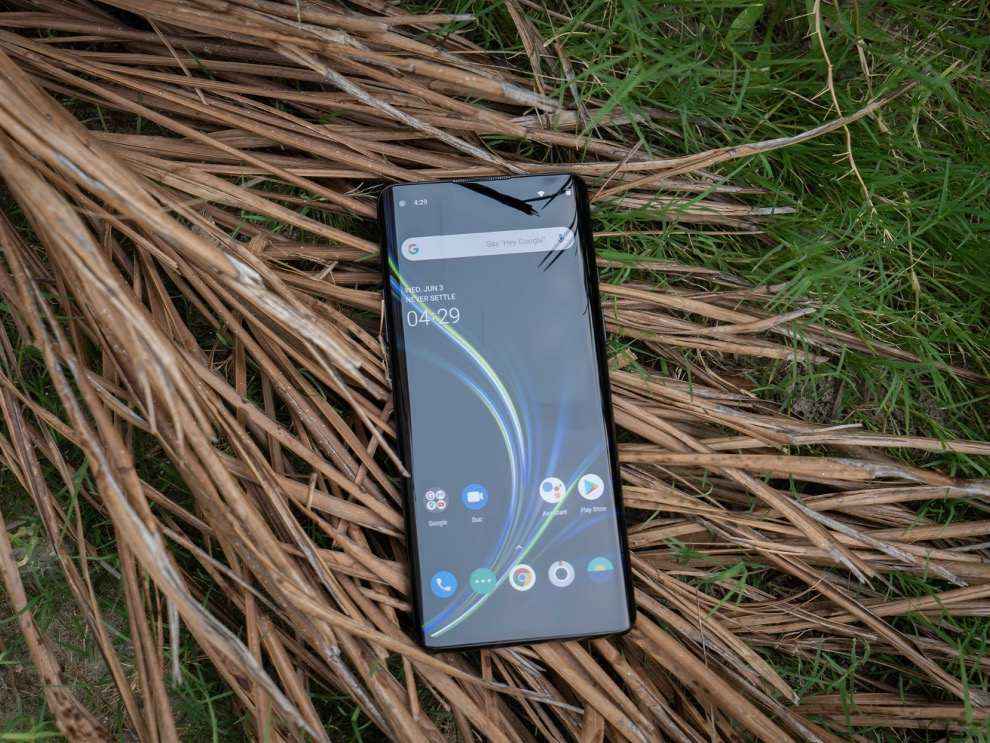
OnePlus 8 runs on OxygenOS 10 which is arguably the cleanest Android UI out there in the market. There are no pre-loaded bloatware apps, other than a generous set of Google apps and the whole user interface looks a lot refined right out-of-the-box. The smooth experience that you get is also a result of system-level optimisations and the 90Hz refresh rate that irons out every animation, transition, scrolling and makes it a fluid phone to use.
The gesture navigation offered by Android 10 ties-in well with OxygenOS letting you interact with the screen with ease. The UI also offers tons of customisations options along with a dedicated work mode profile, dark mode, zen mode and more. It’s also efficient in the way it allows users to multitask easily and features like RAM Boost keeps apps in the background ready for you to resume using it. With the OnePlus 8, the OxygenOS feels like a very refined, no-frills version of Android that every user can naturally be familiar with it. This is something that most Android smartphone UI’s lack and don’t focus on, which results in poor user experience, especially when you have random advertisements thrown in between.
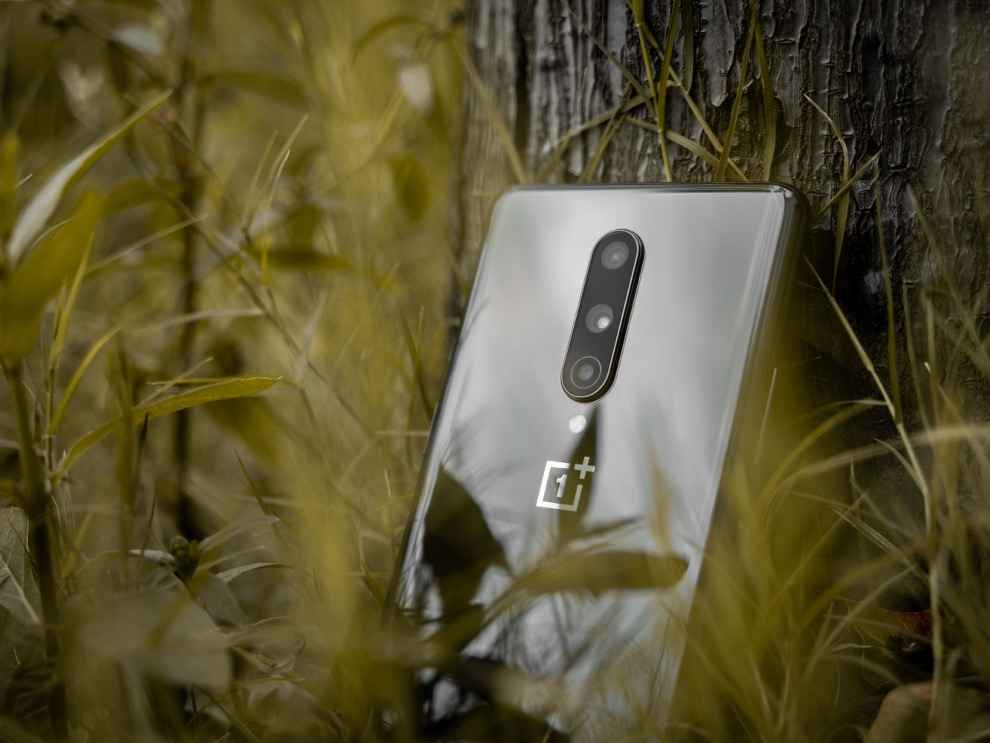
OnePlus 8 remains an underachiever primarily in the camera department, but that’s not to say it comes with bad cameras. It’s just not as versatile as the OnePlus 8 Pro and even the OnePlus 7T which came before it.
It features a 48MP camera that uses the ½-inch Sony IMX586 sensor with an f/1.8 aperture and support for OIS and EIS. This is followed by a 16MP ultra-wide-angle camera with a 116-degree field of view. It trades the telephoto lens from 7T for a 2MP macro camera instead and this is where things get a little confusing. Being a sub-Rs 50,000 smartphone, one would automatically expect flagship-level camera setup but that just isn’t the case here as two of the three cameras are similar to the ones found on older generation OnePlus phones.
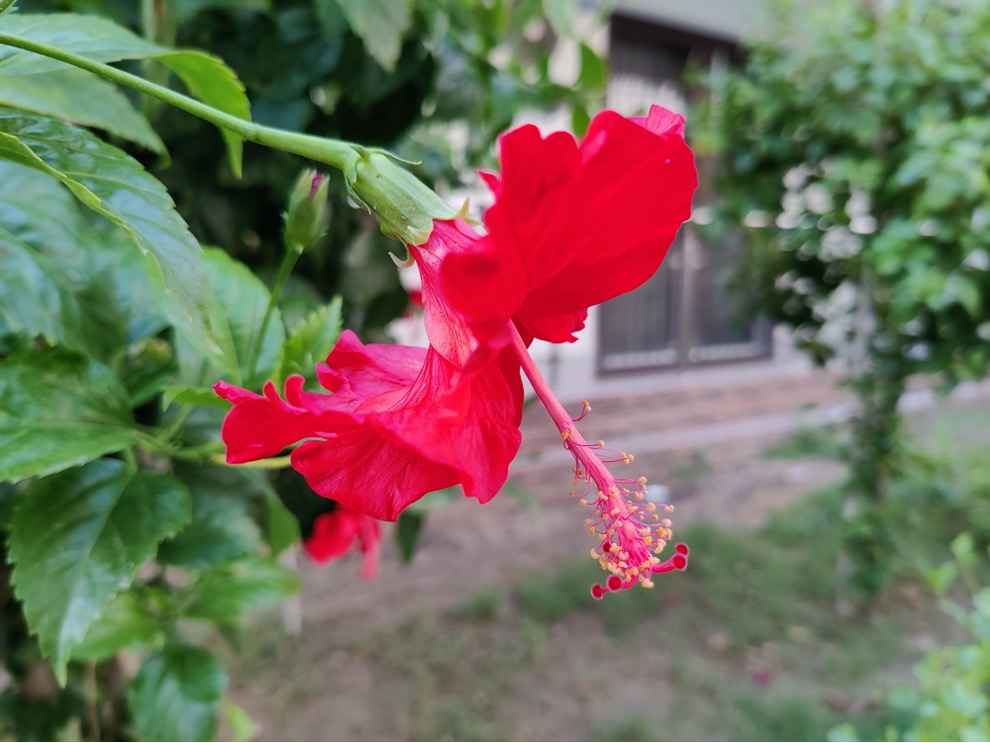
The primary camera on the OnePlus 8 is still very good at creating pictures with vivid colours, balanced exposure, excellent details and good dynamic range.

The camera is quick to autofocus and snap a picture in daylight but takes some time processing the shot at night or in low-light environments. While the camera setup is devoid of a telephoto lens, the camera app allows you to digitally zoom into the frame upto 2X by default and it’s pretty decent as well.
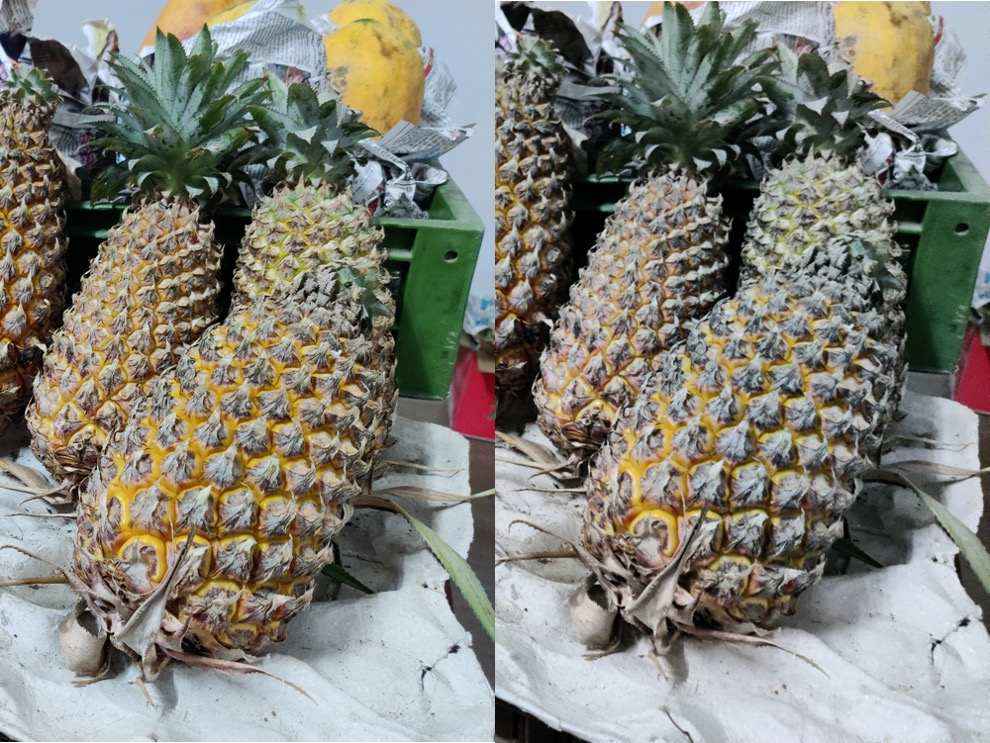
There’s a dedicated 48MP mode that lets you create pictures in an 8000 x 6000-pixel resolution but the images often look dull with low saturation across the board. Additionally, it does capture more details than what you’d get with a 12MP-binned picture but the pictures aren’t as sharp as you’d expect.
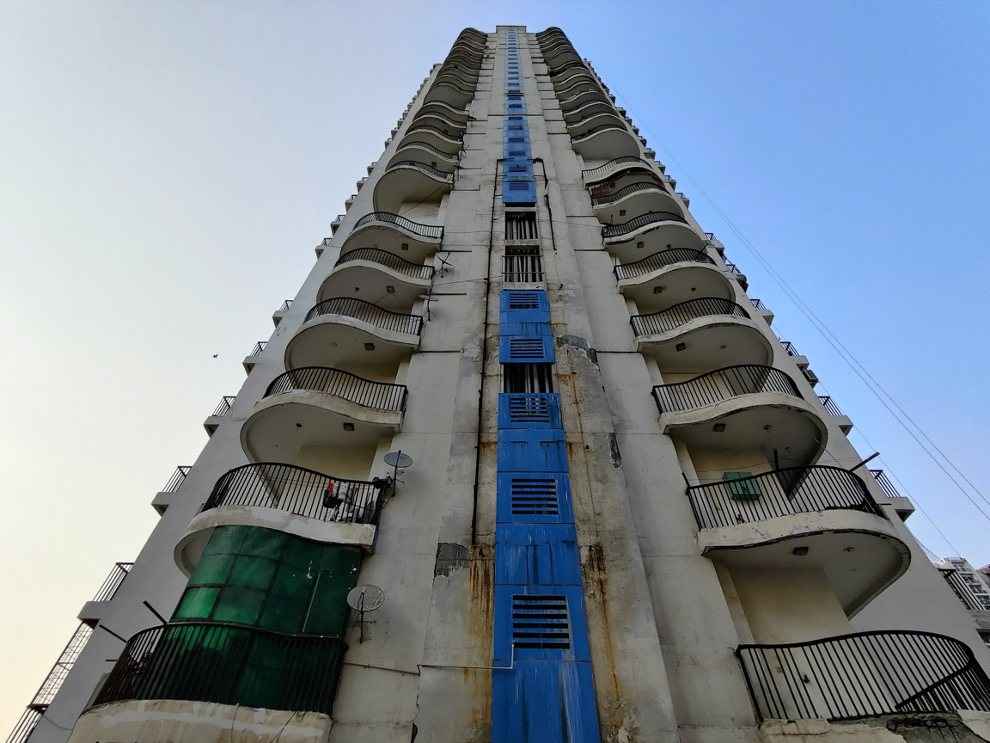
The 16MP ultra-wide-angle camera is capable of filling more elements into the frame and the pictures from this camera came out to be well-detailed and with similar characteristics as the primary sensor. Though we noticed that the pictures often had a higher saturation level than normal with less sharpness around the corners. We’d have liked to see a high-res ultra-wide-angle sensor on the OnePlus 8 as well, but it seems the company saved all the upgrades for the Pro model.

Nevertheless, the ultra-wide-angle camera isn’t half as bad as the macro sensor on the phone. While a macro camera requires you to go up close to the subject to capture intricate details, the 2MP sensor on the OnePlus 8 isn’t capable of producing a well-detailed macro picture. This camera has a narrow plane of focus in the macro mode which makes focusing a bit of a task. The pictures from the macro camera often looked dull without any details and is the most disappointing feature of this phone.
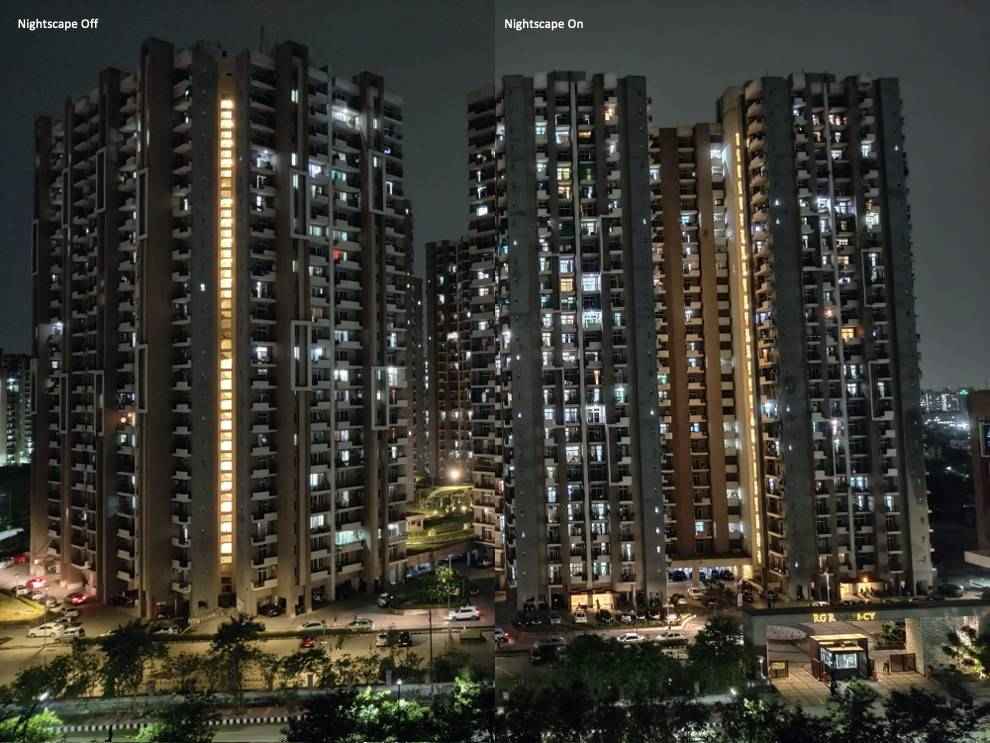
Using the Nightscape mode we were able to get pictures with greater details, though autofocusing behaved erratically at times. Even though the sharpness goes for a toss near the corners as more noise creeps in, the centre area remains in focus and brightens up the scene by a decent margin. The same goes for the ultra-wide-angle camera in Nightscape mode which is better at producing colours and details in low-lit environments.
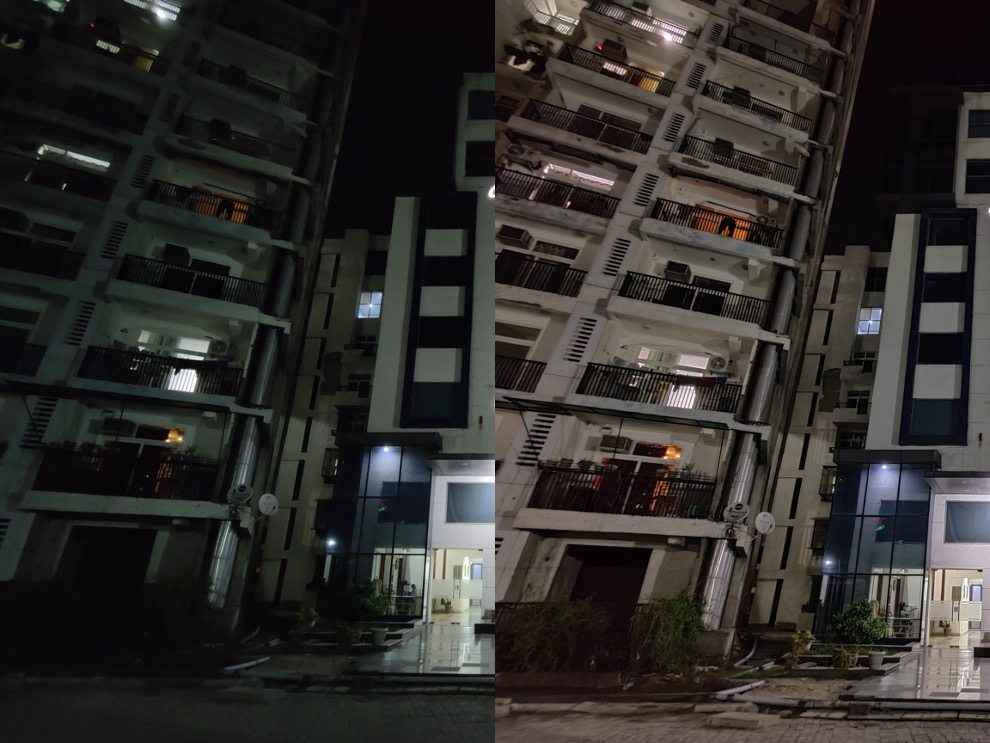
The OnePlus 8 is capable of recording videos in 4K UHD at up to 60FPS and Full HD at up to 240FPS with support for EIS and OIS. The videos from the primary camera are pretty good and stable for the most part. While recording, the camera is able to maintain the focus instantly which is something that the Pro model lacked as it takes too much time to attain focus on a subject of your choosing. One thing we noticed was that there was no option of switching to ultra-wide-angle camera when shooting videos which is a bummer.
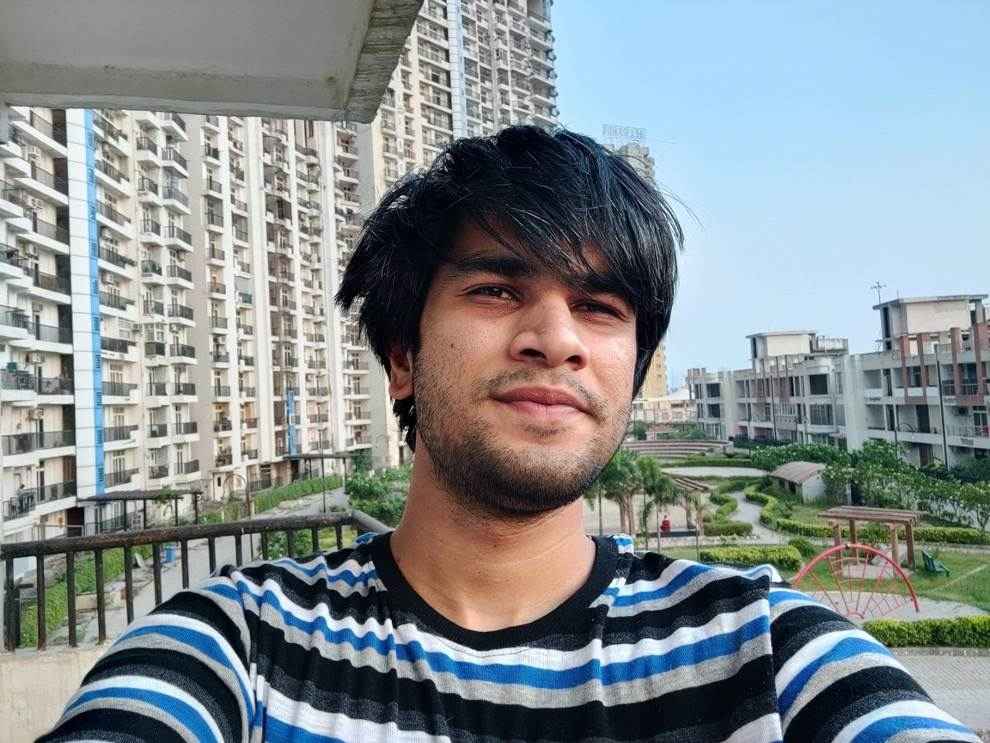
As for the 16MP selfie camera, it creates good-looking pictures in daylight while in low-lit environments the pictures look increasingly processed.
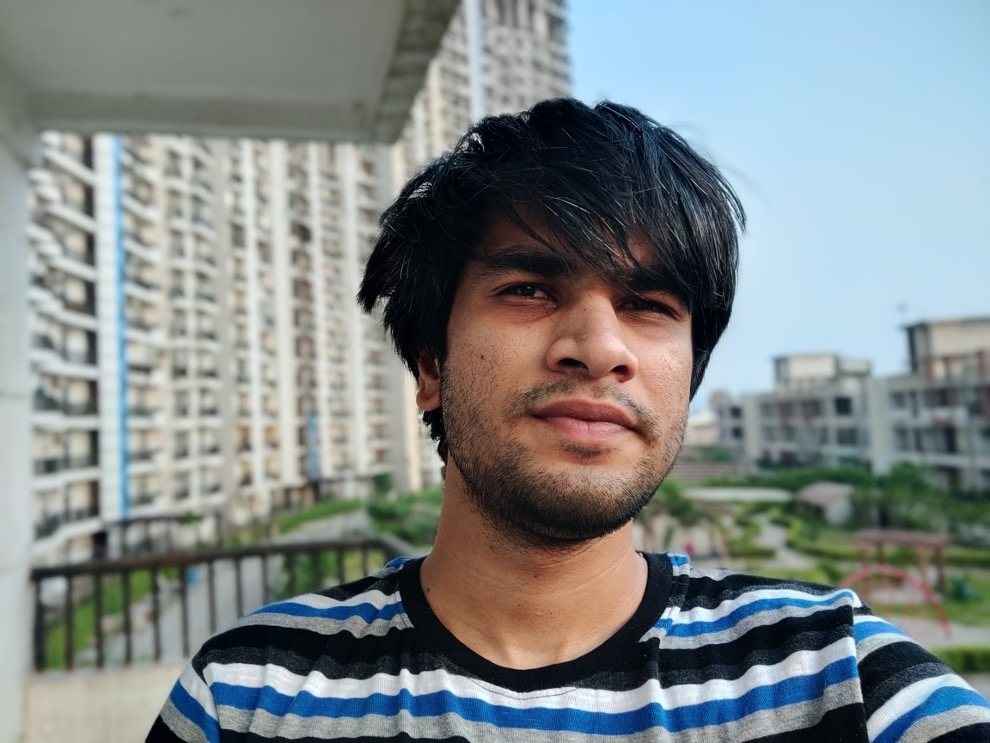
There’s a portrait mode that creates a depth-of-field effect around your face while taking a selfie and it is able to separate the foreground from the background pretty easily.
(Note: The camera samples here are resized for web. You can view the high-res pictures here.)
OnePlus 8 has a 4,300mAh battery that supports 30W fast charging and comes with the Warp Charge 30 adapter in-the-box. The battery performance depends on different use cases and based on my use, the phone is able to last for a full day and sometimes even more than 24 hours on normal use consisting of a lot of social media use, web browsing, listening to music and watching videos in between.
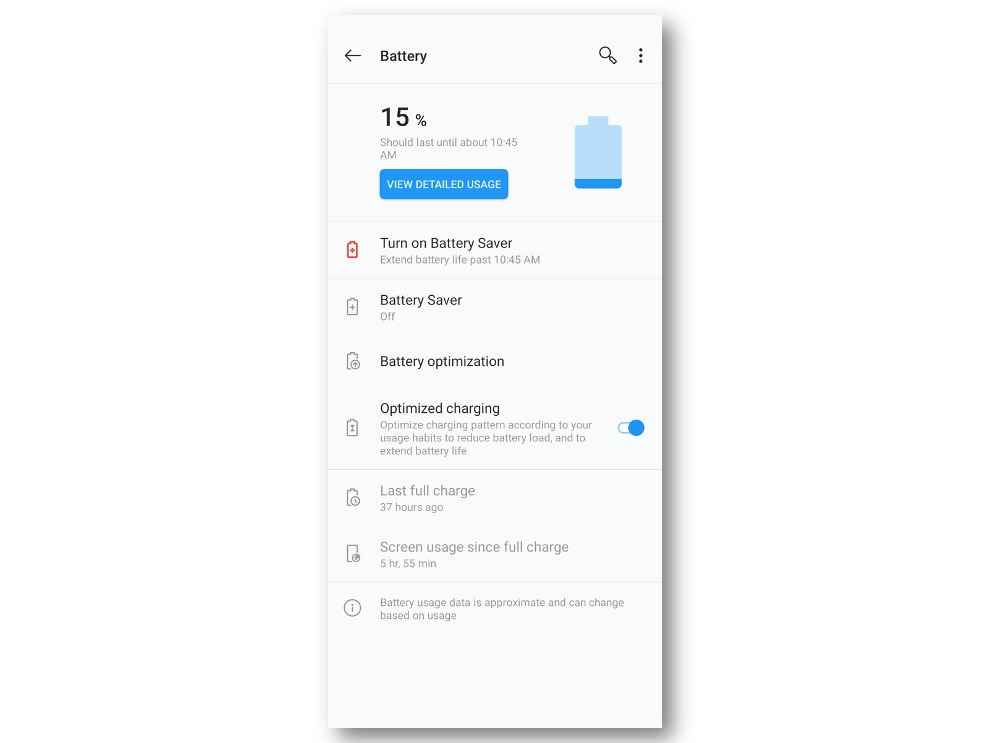
If you’re someone who plays games like Call of Duty Mobile and PUBG Mobile extensively, the phone should still give you a day’s worth of use on a single charge and it’s definitely on the higher side considering the competition.
Surprisingly, in our video loop test, the OnePlus 8 lasted for a full 15 hours on 100 per cent brightness with a three-hour movie running on a loop for the entire time and constant internet connectivity. This is a pretty good result in our books when it comes to battery efficiency especially with the 90Hz refresh rate. The battery took a 7 per cent hit on a 15 minutes session of CoD Mobile, which again is pretty decent.
The phone took 30 minutes to go from 0-50 per cent and 72 minutes to charge fully from 0 to 100 per cent. While it isn’t the fastest fast-charging solution available in the market, you’d just be fine with what the OnePlus 8 offers.
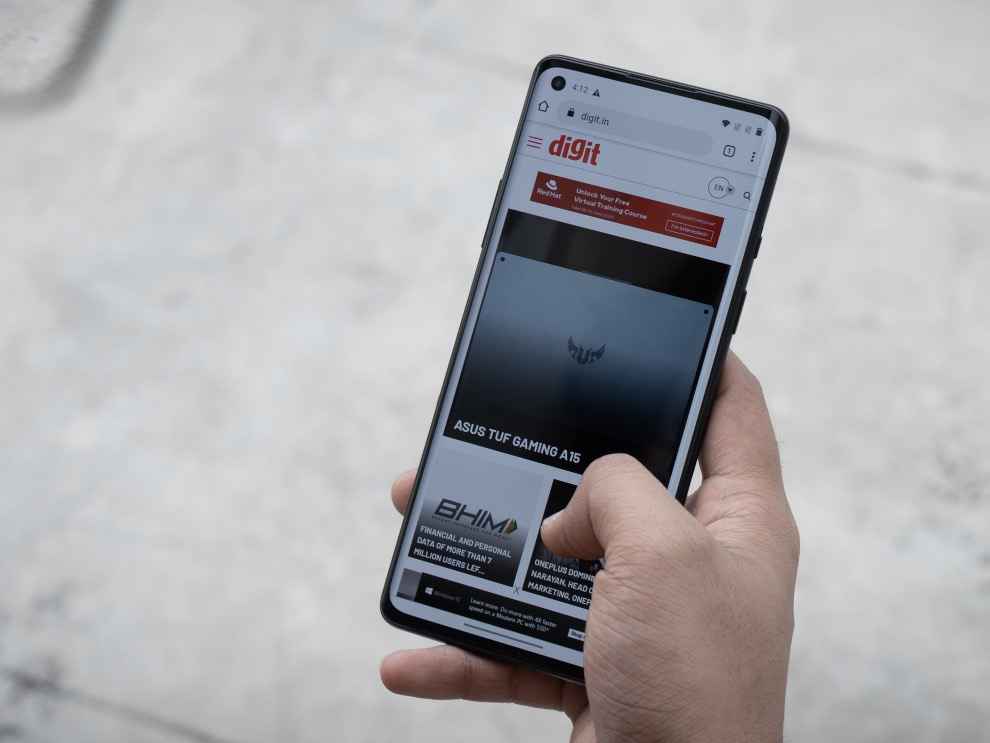
OnePlus 8 features a 6.55-inch display that has a Full HD+ (2400 x 1080 pixels) resolution and uses an AMOLED panel. The screen is HDR10+ certified and has a 90Hz high-refresh-rate which makes everything look buttery-smooth. The display has a peak brightness of 908 nits as measured by our light meter and minimum luminance of 7 nits. This means that the screen can achieve an excellent level of brightness which comes in handy when watching a video or a movie on the phone.
OnePlus has gone with a punch-hole cutout for the front-facing camera this time which gives the screen a 20:9 aspect ratio. It can feel a bit odd when looking at the display for the first time, not so much as the small cutout but rather a black dot in the top corner, but give it some time and your eyes will likely be comfortable with it at the end.
The display is also curved on the sides offering an immersive viewing experience, something that's common with premium flagship phones these days. It has the perfect amount of bend, lesser than the 8 Pro, which makes it comfortable to use with one hand and with gestures enabled. In my use, I did not notice any accidental touch inputs something that's known to be irksome with a curved screen.
The screen on the OnePlus 8 is fairly good at reproducing colours accurately with excellent clarity and has great viewing angles. The sunlight legibility is good too and on par with the competition.
But say for instance you prefer screens with more saturation, OnePlus offers an advanced screen calibration option that lets you tweak the colours between preset options Adobe sRGB and DCI-P3 range. Another thing we noticed was that the curvature of the screen isn't too prominent so you won't be able to notice it when looking directly at it. This adds to the overall experience of interacting with the display.
Another notable thing about OnePlus phones in recent years has to be the biometric security it offers with the in-display fingerprint reader which is able to identify your prints and unlocks your phone in a jiffy.
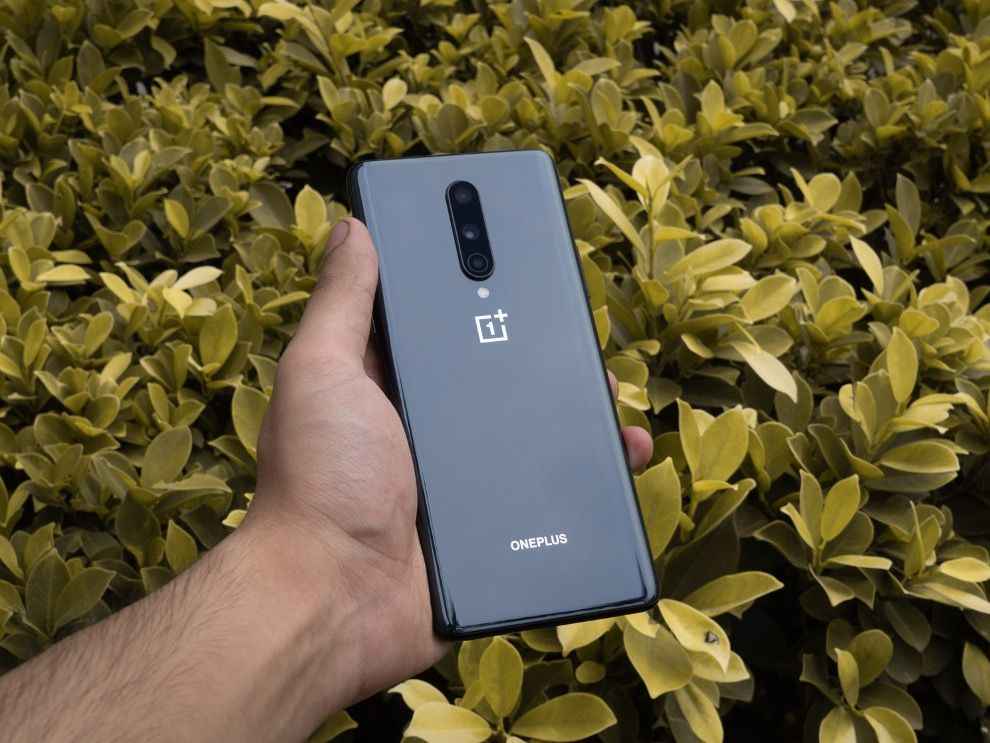
The OnePlus 8 seems to be a very refined smartphone in terms of the design language and is lightweight as well. The phone measures 8 millimetres at its thickest point and weighs in at 180 grams, making it one of the thinnest and lightweight flagship phones to exist right now.
OnePlus 8 comes in three colours-- Onyx Black with a glossy finish, Interstellar Glow with a reflective finish and Glacial Green with a matte finish. Naturally, the black and Glow colour variants are prone to smudges a lot more than the matte version.
It is quite handy to use for day-to-day activities and at no point did the size or weight come across as a hurdle in the overall experience. The OnePlus 8 is built using aluminium chassis slapped with Gorilla Glass 5 on both sides making it durable and comfortable when in the hand.
The conventional candy-bar design just seems refreshing and comfortable to hold with its rounded corners along with a display that just perfectly tapers a bit on the edges. OnePlus offers a transparent case in-the-box which fits just perfectly on the phone with big and bold "Never Settle" written across. It doesn't look odd as it's only visible from certain angles and the best part is that it doesn't add to the weight of the phone. In my use with the case put on, the phone came unscathed after a couple of drops to the marble floor.
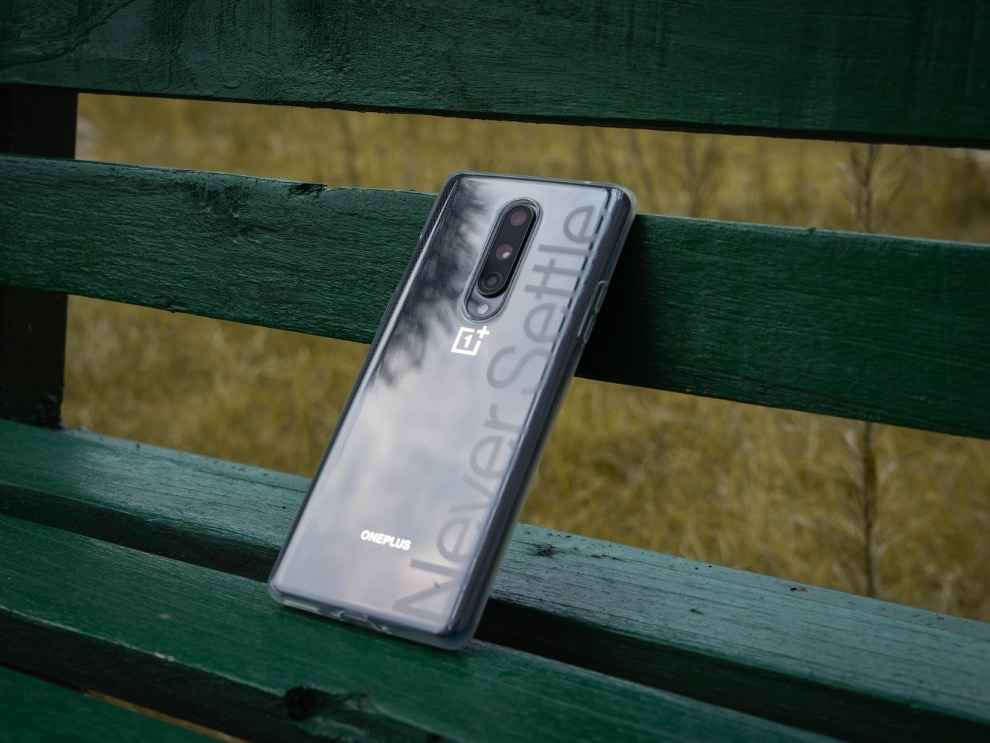
You'll find the alert slider and power button on the right edge and the volume buttons on the left. These buttons are fairly tactile and can be easily reached with one hand. There's a USB Type-C port at the bottom along with the SIM card slot and a speaker unit.
OnePlus 8 doesn't come with an official IP certification in India, however, the same phone has received an IP68 rating when bought in-contract from the US. The missing certification is likely a cost-cutting decision and the phone you get in India offers the same ingress protection, even though it's not officially certified.
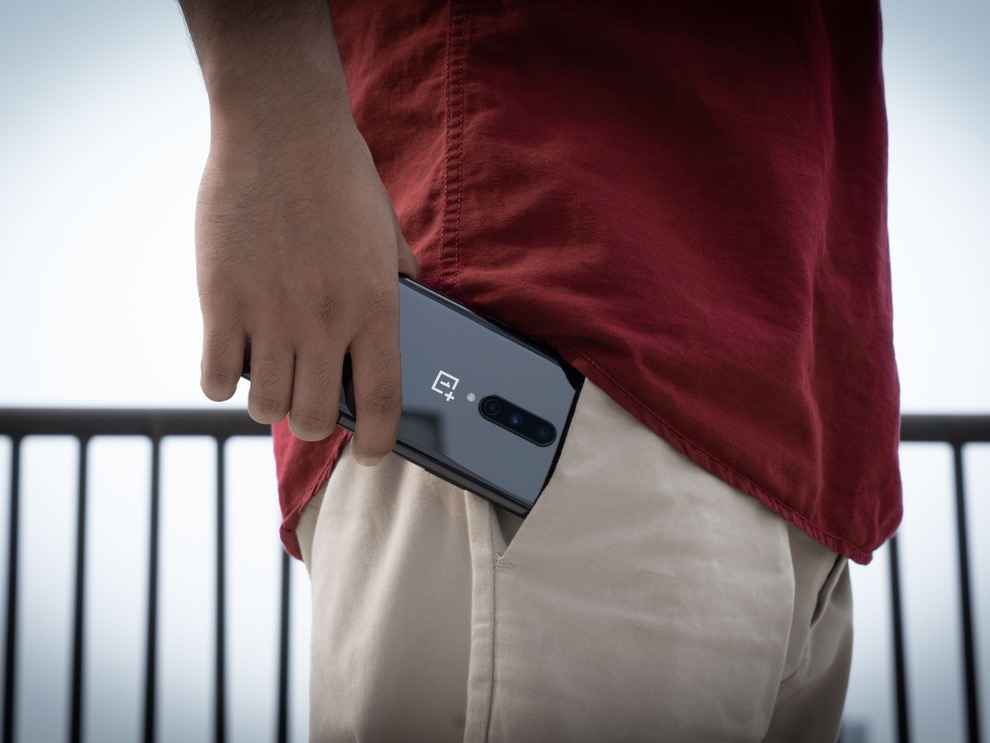
OnePlus 8 nails the essentials which makes it a pretty well-balanced offering from the company. Notwithstanding the unsettled camera performance, it remains a powerful performer with the smoothest Android experience currently available in the market. The display on the OnePlus 8 is great for watching videos and binge-watching Netflix. The battery life of OnePlus 8 is great too and if not better, it’s at least on par with the competition.
So, if you’re not that critical about getting a versatile pair of cameras on your smartphone, the OnePlus 8 can be considered as a viable option as it offers you a no-frills Android experience and is a phone you can depend upon starting at Rs 41,999.
Sure there are alternatives like the Realme X50 Pro and the iQOO 3 that offer a versatile set of rear cameras but the overall experience of the OnePlus 8 remains unmatched.
| Price: |
 Rs. 41999
Rs. 41999
|
| Release Date: | 14 Apr 2020 |
| Variant: | 128GB8GBRAM , 256GB12GBRAM |
| Market Status: | Launched |
 Screen Size
Screen Size
 Camera
Camera
 Memory
Memory
 Battery
Battery

Digit caters to the largest community of tech buyers, users and enthusiasts in India. The all new Digit in continues the legacy of Thinkdigit.com as one of the largest portals in India committed to technology users and buyers. Digit is also one of the most trusted names when it comes to technology reviews and buying advice and is home to the Digit Test Lab, India's most proficient center for testing and reviewing technology products.

We are about leadership-the 9.9 kind! Building a leading media company out of India.And,grooming new leaders for this promising industry.

55
59
55
65
The Intex Q11 is a sub-par smartphone in all respects. It fails in terms of performance, camera and almost everything else. We would recommend spending a little more, to buy the Xiaomi Redmi 3s.
Smartphone makers have been relentlessly innovating in the budget segments. Unfortunately, the innovations we’ve seen in the sub-20K or sub-15k segments haven’t yet trickled down to phones that cost even lesser. To be precise, most sub 7K smartphones still feature 2-year-old hardware and negligible performance boosts compared to last generations. So, when the Intex Q11 4G was dropped off at my desk, I was a tad unsure about how it would fare. Frankly speaking, the phone doesn’t seem very competent on paper.
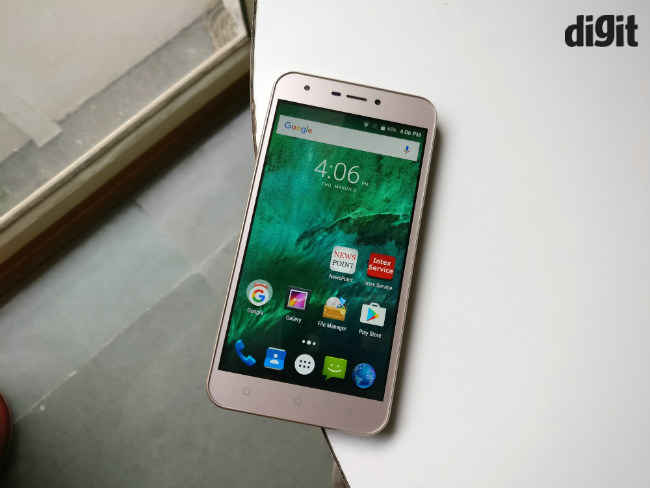
Interestingly, its main feature is the VR capabilities built into it. But, we’ll get to that later. For now, let’s begin with the look and feel.
Build and Design
The design and build quality of the Intex Q11 4G is pedestrian. The glossy back on the phone feels odd and somewhat cheap. It also looks low-end, but seems sturdy enough, considering the price. There’s a certain heft to it and even though the surface looks fragile, it’s not easily scratched, and can withstand an occasional knock or two. Intex does provide an additional clear-case and screen protector in the box, but I believe there’s definitely room for improvement.
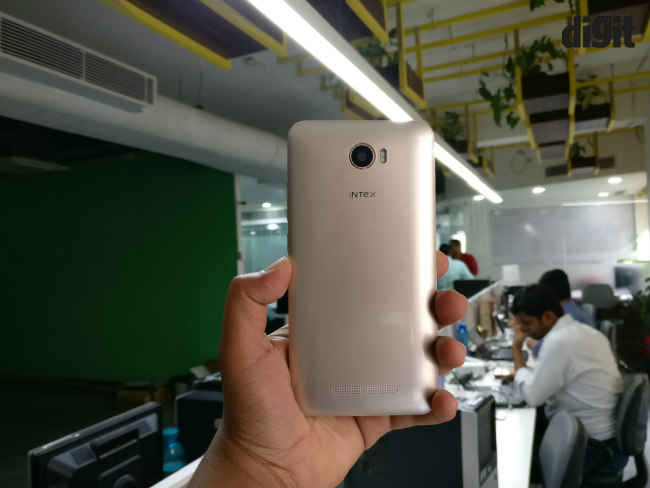
Beside the two physical power and volume rocker keys, there is a silent toggle on the left side of the phone. All three physical keys work as intended, but they don’t respond at times. Also, the buttons feel shallow, as they would if the phone was inside a case.
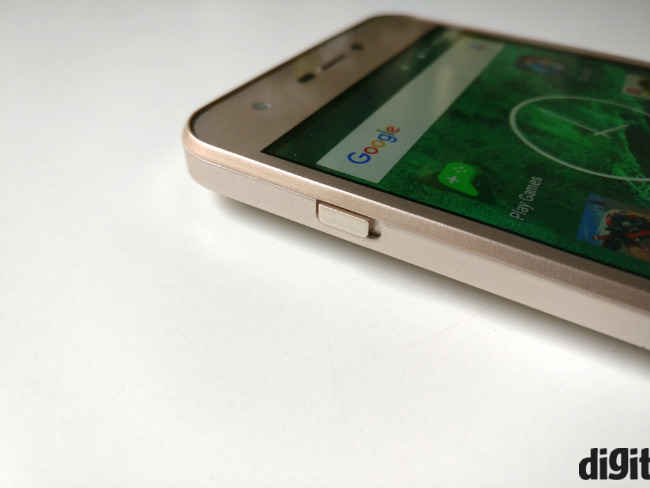
Also, the phone looks like a carbon copy of the Intex 5.5VR smartphone, which was launched a few months back. The two devices share features as well.
Display and UI
Even the displays on the two devices are the same. The 5.5-inch screen on the phone seems quite good, considering the price. Touch response is wonky, though, it’s more like a hit and miss at times. It works sometimes and at others, takes more than a single tap.
Slow performance makes the sub-par touch performance feel worse, which I shall explain in the performance section. The colour reproduction is quite good, but again, viewing angles are just about average. Sunlight visibility isn't great either and there is a visible colour shift from not so wide angles.
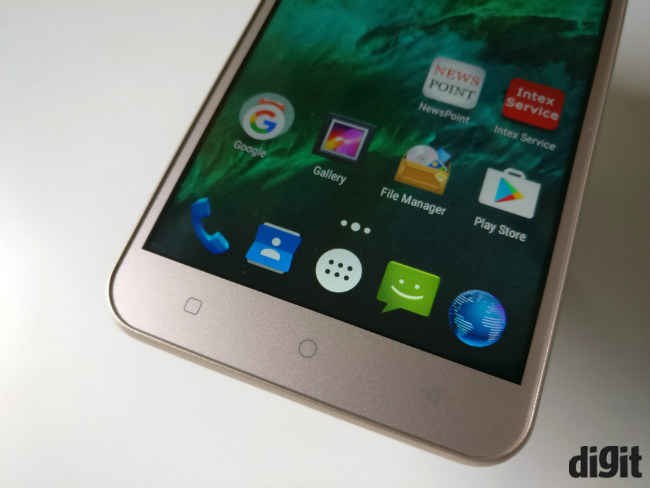
The UI remains the same as well. It bears a stock like facade, which is then integrated into an advert-ridden ecosystem. There are almost a dozen pre-loaded apps, most of which can't be uninstalled. The camera app has shortcuts to a shopping app and editing app. Intex’s own app aggregator will also keep popping up on the device’s notification panel and can be dismissed only after you open it and install a few apps. If you don’t want to, you just have to live with it.
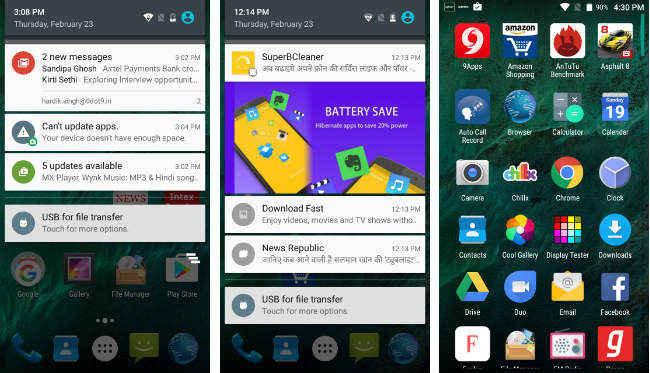
The leftmost homescreen include some weather and current news info from partner apps. While some may like this, and it works as intended, all this together makes it seem like the phone is made primarily to sell apps, rather than providing a good experience.
Performance
The performance of the phone was quite disappointing too. Firstly, there isn’t enough space on, with only 8GB of internal storage. With less than 4GB available to the user, the phone refused to install my regular set of test applications. Further, thanks to Intex’s app aggregator, I ended up installing more unwanted apps, which I then uninstalled.
Interestingly, the phone does not handle apps well either. It lags in simple navigation tasks, like opening recent tabs. This is partly due to the fact that it has only 1GB of RAM and partly because the UI lacks optimisation. It became quite apparent, as simpler games, such as 32 Secs hung a couple of times, when it was the only active task. While the phone does manage to run apps such Facebook, Gmail and Chrome, the experience here is sluggish.
VR is supposed to be a redeeming feature here, and while it does run, it’s not flawless. You can play 360 degree videos via YouTube or watch a pre-loaded videos, but that’s pretty much it. The gyroscope often loses alignment and there isn't much space to install VR games either. Here are some synthetic benchmarks, which do not truly justify the phone’s performance in day-to-day performance.
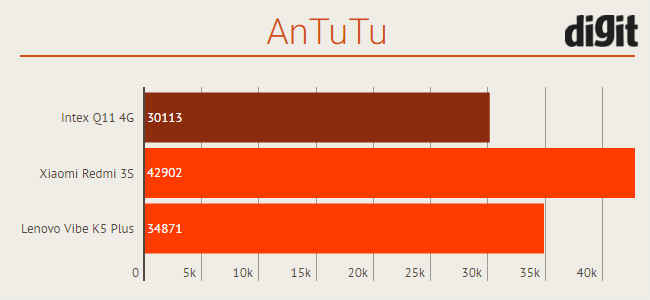
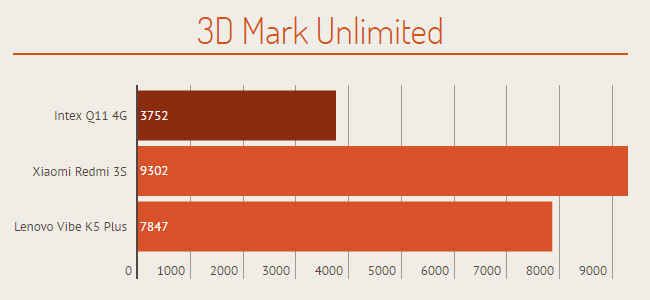
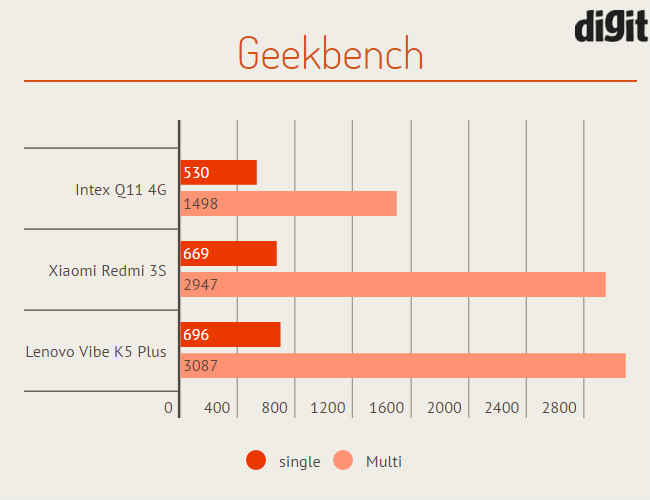
Given its performance otherwise, it’s confounding why Intex wants to sell it on VR capabilities. While lower tier markets may not be privy to things like the Samsung Gear VR (which are not perfect either), this is not the first taste of VR that you should get.
Battery
The PC Mark battery test returns 7 hours and 23 minutes of battery life, which is the industry average today. Using the phone as a daily driver with a Jio SIM, it made it through a normal work-day with over half a dozen calls, about an hour of video streaming, and heavy Facebook and browser usage.
I didn't game much on the device, though, due to unplayable frame rates. Looking past that, there was a drop of 18% in an hour of gaming, with Breakneck.
At one time, while testing the device, it was showing wrong info about the remaining battery percentage. The battery percentage dropped from 30% to 14% suddenly, and then went back up to 35% in the span of less than a minute. This could be an UI issue, or may even be a sign of larger problems. Regardless, it’s not something you want on a phone you just bought.
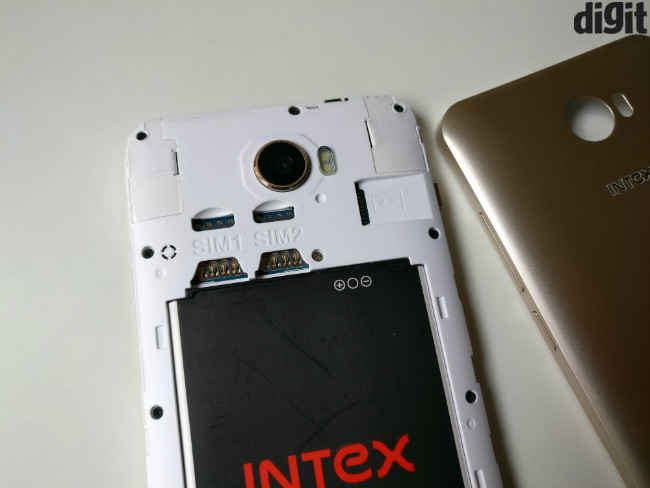
Once discharged, the 2800mAh removable battery takes about 4-5 hours to charge back, which is inconvenient.
Camera
The 8MP rear shooter is again sub-par. Images taken during daytime are dull, lack details and have softer focus, which ruins image all together. Colour reproduction is way off the mark and dynamic range is poor. This also means the camera is unable to process different shades of the same colour properly. As a result, objects lose appeal and pictures lose composure. Image quality further deteriorates as you move indoors and under low light. Under fluorescent light, images appear hazy, with softer focus. Photos are underscored by low details and visible noise. Low light images are almost unusable.
View post on imgur.com
Bottomline
The Intex Q11 4G is a sub-par phone, despite its low price. Its performance is inadequate, the UI is irritating, the camera is unsatisfactory and build quality and design are pedestrian. It’s VR elements aren’t flawless either. I would suggest you raise your budget to about 7K and get the Xiaomi Redmi 3S, which is a much better phone than this.
| Price: |
 Rs. 7800
Rs. 7800
|
| Release Date: | 25 Jan 2017 |
| Variant: | 8GB |
| Market Status: | Launched |
 Screen Size
Screen Size
 Camera
Camera
 Memory
Memory
 Battery
Battery

Light at the top, this odd looking creature lives under the heavy medication of video games.

Digit caters to the largest community of tech buyers, users and enthusiasts in India. The all new Digit in continues the legacy of Thinkdigit.com as one of the largest portals in India committed to technology users and buyers. Digit is also one of the most trusted names when it comes to technology reviews and buying advice and is home to the Digit Test Lab, India's most proficient center for testing and reviewing technology products.

We are about leadership-the 9.9 kind! Building a leading media company out of India.And,grooming new leaders for this promising industry.

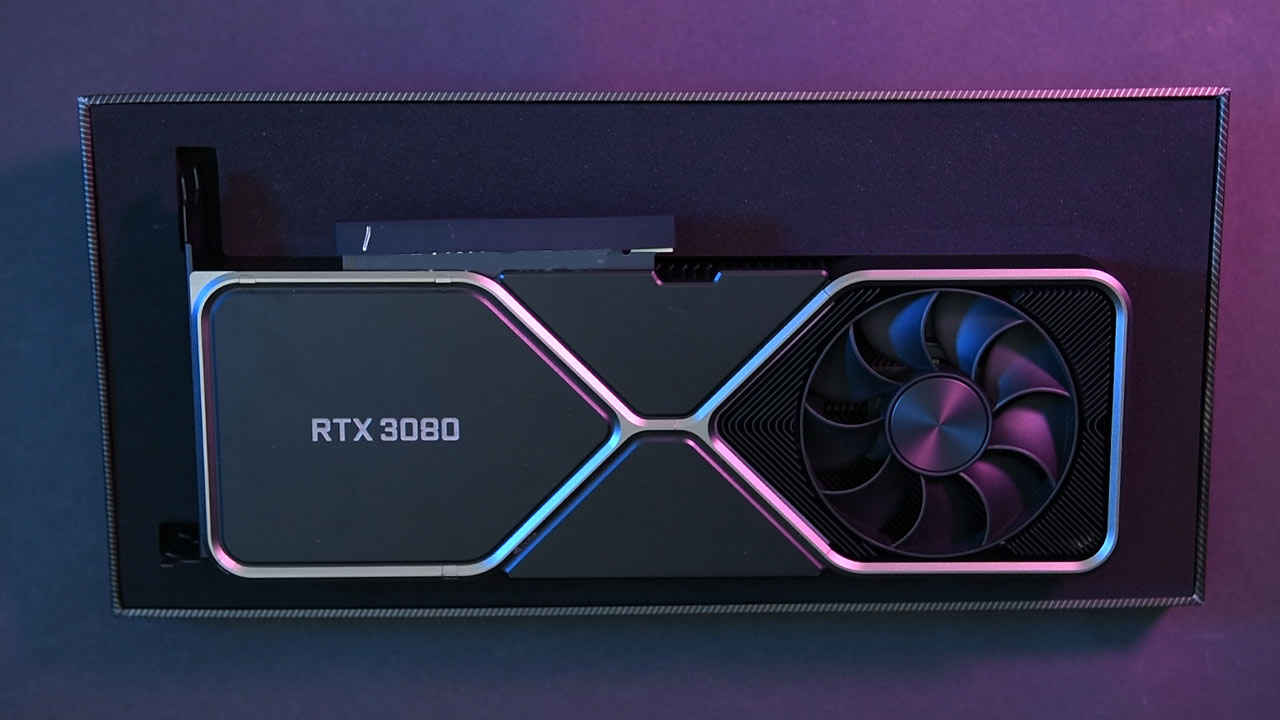
The NVIDIA GeForce RTX 3080 easily beats the RTX 2080 across all games and synthetic benchmarks by about 30-70 per cent. In some titles, it events goes ham and achieves 2x the performance. So there's little need to worry over there. It's even cooler than previous gen reference cards. So there's little reason to skip this generation. If you're looking for a flagship GPU to own, this is it. We're still going to wait for the AMD RDNA GPUS in the form of the RX 6000 series but by the looks of it, AMD has a tough job if it wants the performance crown.
| Price | 71000 |
After two whole years, we're looking at the next major GPU launch cycle with NVIDIA Ampere RTX 30 series and AMD's RDNA2 RX 6000 cards right around the corner. During launch, NVIDIA CEO showcased the new Ampere cards while claiming 2x performance and 1.9x greater performance-per-watt over the older Turing RTX 20-series cards. We're going to be looking at the RTX 3080 today since that's the first Ampere card to be launched with the RTX 3090 coming within two weeks from now and the RTX 3070 coming later in October. At Rs 71,000 it has the same launch price as the RTX 2080, the RTX 3080 doesn't have to convince gamers. It supposedly even beats the RTX 2080 Ti which costs a lot more but by what margin? Let's figure that out.
The specifications for the three RTX 30 cards when compared to their RTX 20 counterparts let you know exactly how they are positioned. With 24 GB of memory, the RTX 3090 is akin to the RTX TITAN and would be targeted at workstations and multitasking machines which require a lot of CUDA cores. Whereas, the RTX 3080 and RTX 3070 are very much similar to the RTX 2080 and RTX 2070 in terms of positioning. Which bears the question, what's the equivalent for the RTX 2080 Ti? It would appear that NVIDIA is holding back till AMD's RDNA2 "Big Navi" cards are released in November 2020. We should hopefully see RTX 3080 Ti or Super cards that equal or beat the RDNA cards as a reaction to AMD's cards.
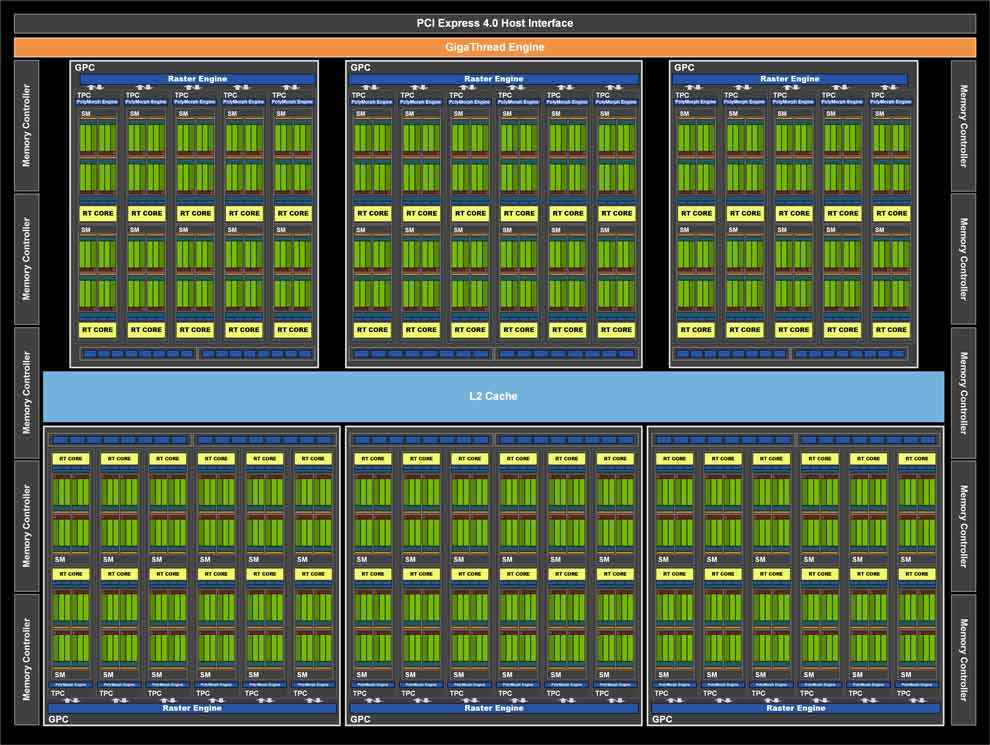
The RTX 3080 in particular has 8704 CUDA cores if you look at how the SMs have been completely revamped compared to Turing. We have six GPCs within the GA102 GPU for the RTX 3080 but there's asymmetry with the GPC configuration. There are 4 GPCs which have 12 SMs each and there are two GPUs with 10 SMs in them. Overall, we're looking at 68 SMs with a total with 8704 CUDA cores in all.
We have featured some of the GTX 10 series cards along with most of the RTX 20 series cards including the Super cards. A few AMD RX 5000 series cards were also thrown into the mix to see how good the cards perform against the competition. With AMD’s Big Navi around the corner, it’ll be great to see how these RTX 30 cards and RDNA2 cards go up against each other. Like always, we have a section for synthetic benchmarks as well as gaming benchmarks with plenty of charts to showcase differences. Coming to the rig, this is what we’re running our benchmarks on.
Processor - Intel Core i9-10900K
CPU-Cooler - Noctua NH-D15
Motherboard - ASUS ROG MAXIMUS XII EXTREME
RAM - 2x 16 GB Corsair Dominator Platinum @ 3200 MHz
SSD - Kingston KC2500 1TB + WD Blue 1 TB
PSU - Cooler Master V1200
Graphics cards:
RTX 3080
RTX 2080 Ti
RTX 2080 Super
RTX 2080
RTX 2070 Super
RTX 2070
RTX 2060 Super
RTX 2060
GTX 1080 Ti
GTX 1080
AMD RX 5700 XT
AMD RX 5700
AMD RX 5600 XT
Some of these cards were sourced from friends owing to the fact that the current lockdown situation has made it extremely difficult to get graphics cards in time for the benchmarks. Let's start with the synthetic benchmarks.
3DMark
In 3DMark, we prefer the Fire Strike Ultra benchmark since the Extreme and normal runs have started producing ridiculous scores with newer GPUs. The other benchmark within 3DMark which we use is Time Spy and we run both, the normal run and the extreme run. Here, we’re showcasing Fire Strike Ultra and Time Spy scores. The RTX 3080 scores 10959 in 3DMark Fire Strike Ultra which puts it 68.4 per cent ahead of the RTX 2080 and 35 per cent ahead of the RTX 2080 Ti
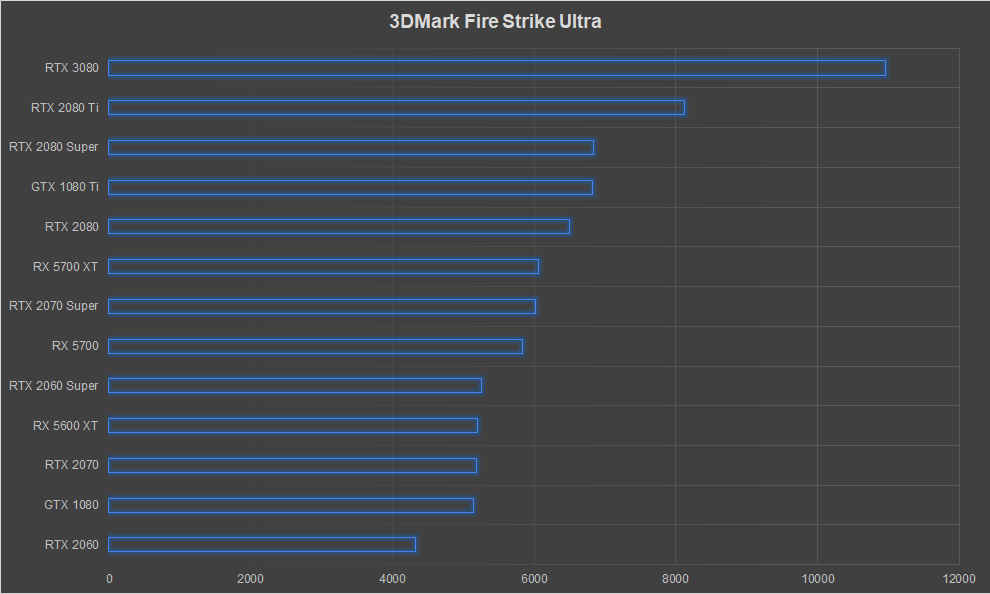
Time spy shows a slightly conservative figure with a 54.5 per cent lead over the RTX 2080 and a 30 per cent lead over the RTX 2080 Ti. Did we say conservative? We should have said “relatively conservative”.
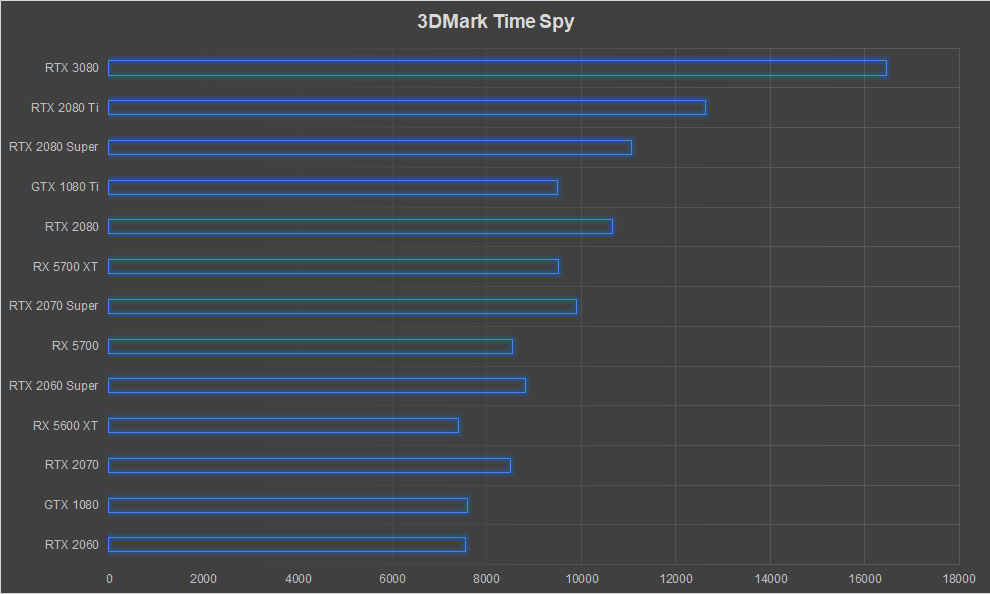
Basemark GPU
Basemark GPU is a nice benchmark to compare the performance of different graphics APIs between cards. We can use the same textures with OpenGL, Vulkan and DirectX 12 to see if the graphics card excels at any particular API more than the rest or if the performance is consistent across the board. The RTX 3080 achieves scores that are between 66-81 per cent greater than the RTX 2080 and about 26-31 per cent greater than the RTX 2080 Ti. Surprisingly, Ampere’s OpenGL performance has improved the most with DX12 coming in at second and Vulkan bringing in the rear.
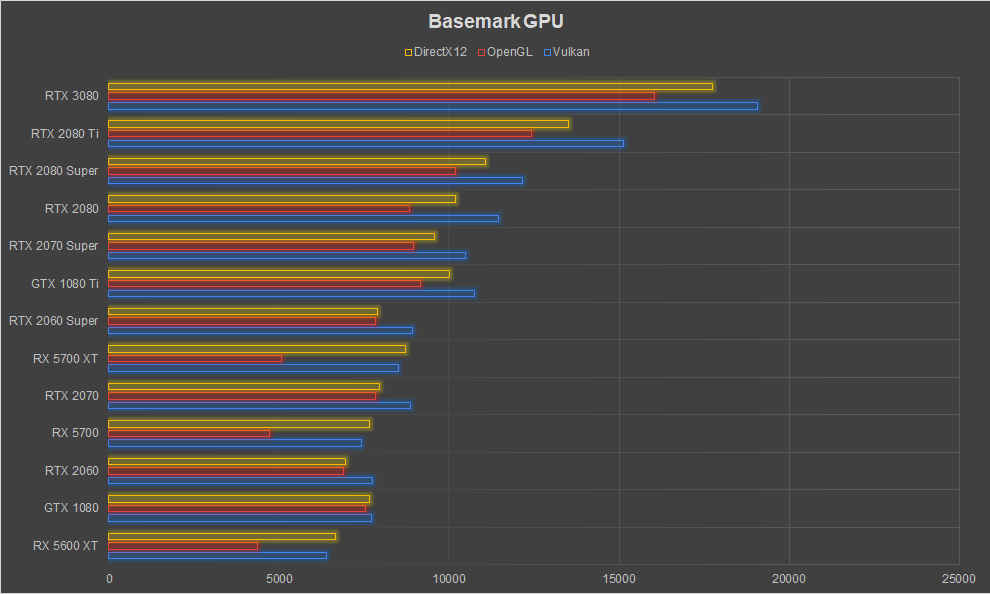
Blender
Blender is a great 3D modeling and animation software that’s open-source and it is the preferred tool for folks wanting to get their hands dirty with 3D modeling. We use version 2.8 to keep up with legacy scores that we have for older cards. The latest stable version would be 2.9 and it’s an incremental upgrade. We use the classroom scene since that’s capable of utilising the GPU for rendering the scene aside from the CPU. The RTX 3080 finished the scene in 1m 18s which is a decent 4 seconds lesser than the RTX 2080 Ti. As for the RTX 2080, it renders the scene in about 94 seconds so that’s a 16 second lead for the RTX 3080.
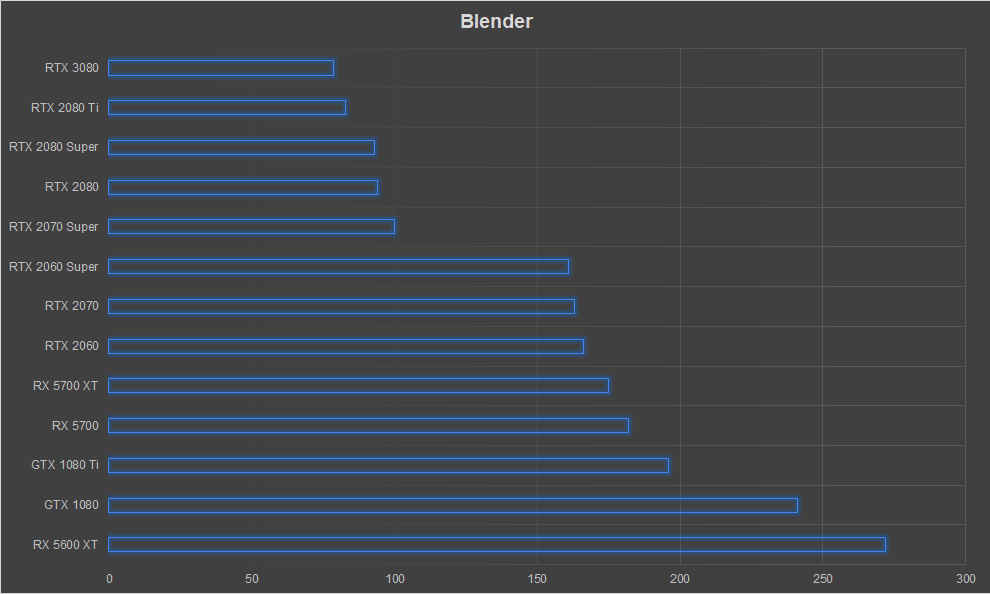
IndigoBench
This is the latest synthetic to be added to our test suite. IndigoBench is based on the Indigo 4 rendering engine that’s available for popular software such as SketchUp, Blender, 3ds Max, Cinema 4D, Revit and Maya. It uses OpenCL and can benchmark both, the CPU and GPU together or individually. We prefer to test just the GPU with the software and the score provided is in terms of .M samples/s’. The RTX 3080 clocked in at 35.751 M Samples/sec which is about 18.9 per cent more than the RTX 2080 Ti and 56.4 per cent more than the RTX 2080.
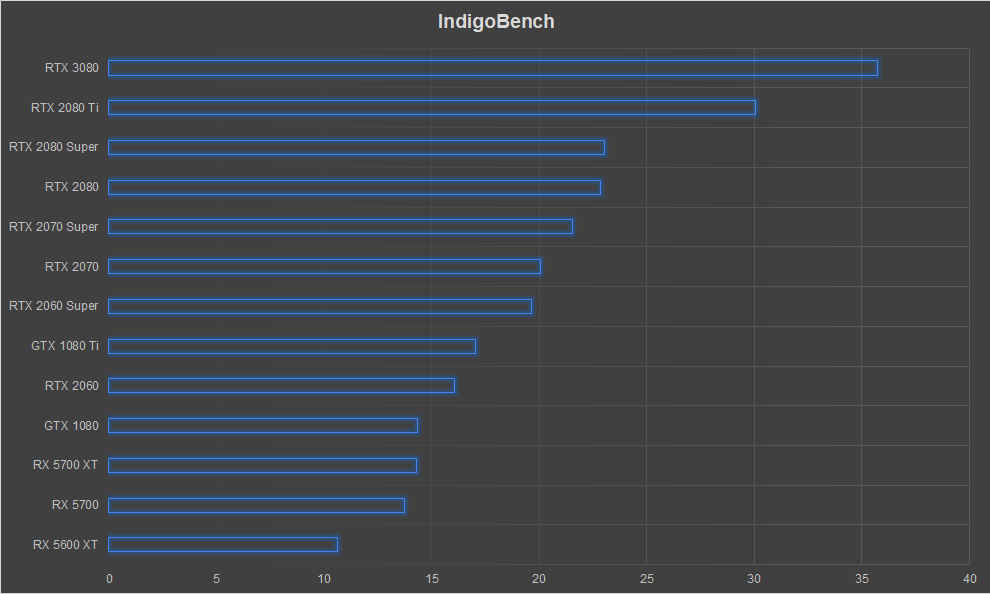
Unigine SuperPosition
Unigine SuperPosition is the other popular DX11 benchmark which we prefer to use alongside 3DMark. We run it on the Extreme Quality preset and use the score metric for delineating the performance between graphics cards. The RTX 3080 performs 17.5 per cent better than the RTX 2080 Ti and 49 per cent better than the RTX 2080.
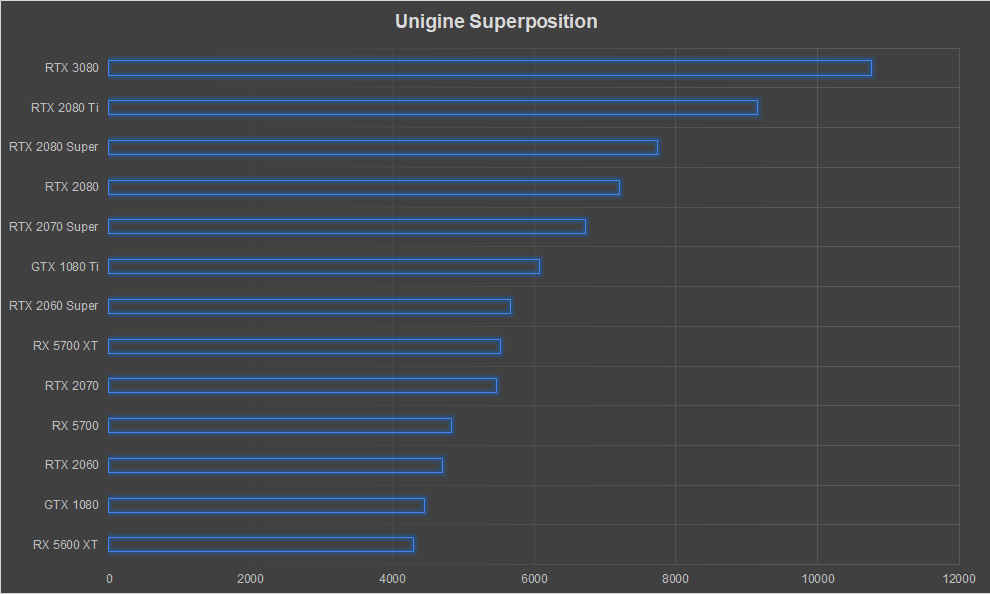
Borderlands 3
Gearbox’s latest game in the Borderlands franchise which uses Unreal Engine 4 and allows you to switch between DirectX 11 and 12. The game has an inbuilt benchmark which takes you through an array of stressful scenarios. The DirectX 12 version is quite flaky and we prefer to use the DirectX 11 API while benchmarking the game and all our existing data is based off the DX11 version so there’s no point switching now. In Borderlands 3, the RTX 3080 performs about 25-28 per cent better than the RTX 2080 Ti and about 56-58 per cent better than the RTX 2080. This is a pretty sizable jump in performance.
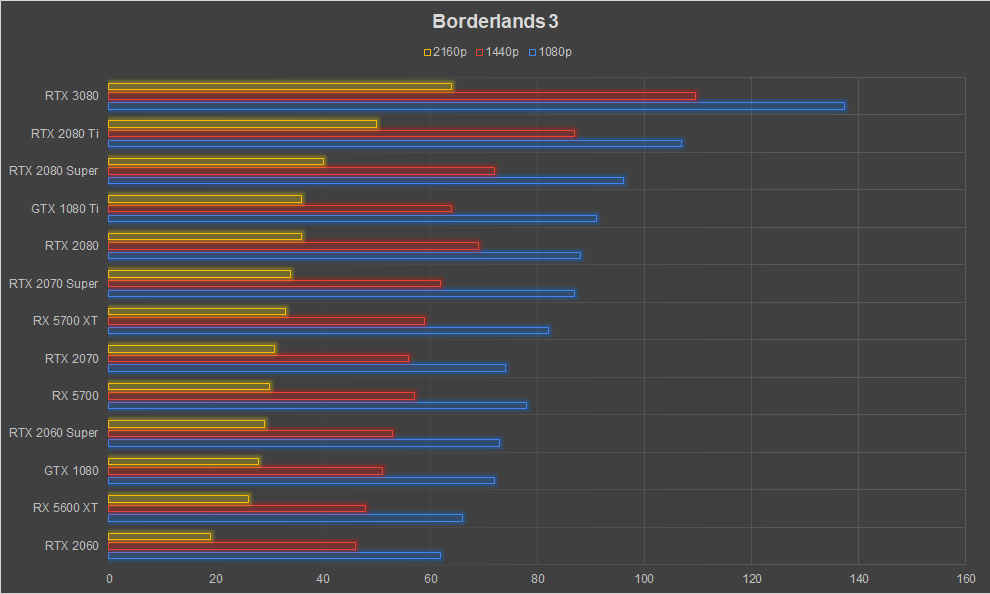
Death Stranding
Hideo Kojima’s Death Stranding has been a recent addition to the PC scene and had been a PlayStation exclusive until July 2020. Being a console game, the game engine is quite optimised to make use of the scarce resources one gets with consoles. However, when 505 Games ported the game to PC, you wouldn’t end up calling the game a console port. The Decima game engine is capable of rendering up to 4K and can use high dynamic-range imaging and is also geared for the upcoming next-gen PlayStation console. It’s also the same engine used by Horizon Zero Dawn. We saw the RTX 3080 perform about 23 per cent better than the RTX 2080 at 1080p and 1440p and about 11-15 per cent better than the RTX 2080 Ti.
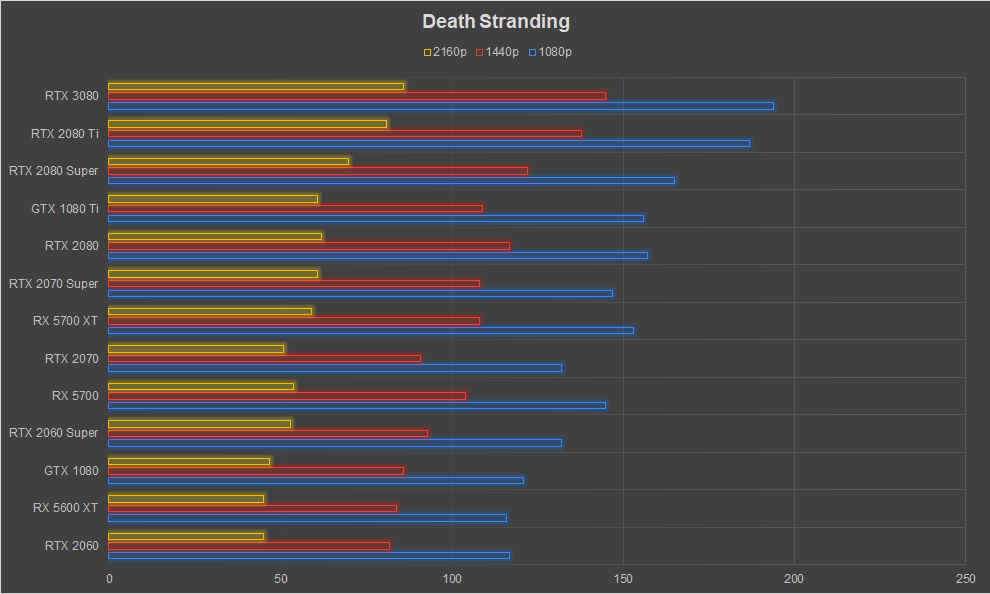
Doom Eternal
Doom Eternal takes the story forward from the 2016 DOOM and it does it in spectacular fashion. It’s also one of the new games to incorporate ray-tracing as an update. The game is based on the latest Id Tech 7 game engine from Bethesda and is tremendously optimised for current gen hardware. Unlike the previous DOOM which allowed you to choose between DirectX and Vulkan, Doom Eternal is locked to Vulkan and makes use of RTX to level-up the ingame visuals. We keep the FOV at default with all the other graphics settings cranked up to Ultra Nightmare. Motion Blur is switched off across all runs because it takes away from the visual fidelity and makes running a benchmark kinda pointless. Performance metrics for Doom Eternal put the RTX 3080 a good 2x over the RTX 2080 and 1x over the RTX 2080 Ti. And we’re talking 4K here. With 1080p resolution, the FPS values are so high that the difference isn’t clear. We averaged a 57 per cent improvement over the RTX 2080 at 1080p. And compared to the RTX 2080 Ti, it was 30 per cent better at 1080p.
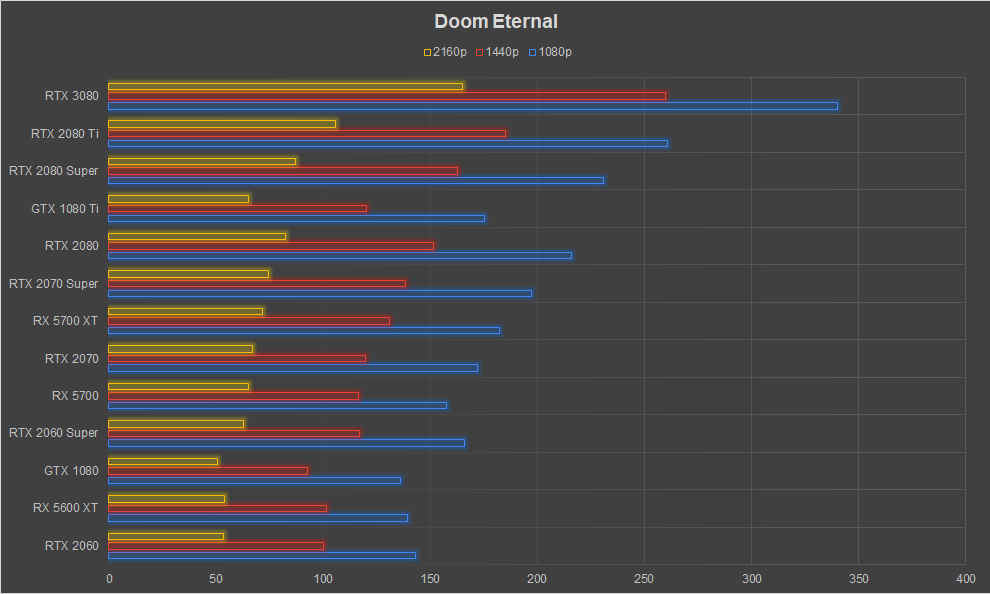
Shadow of the Tomb Raider
We run Shadow of the Tomb Raider in DirectX12 mode. It ends up consuming a little more memory as most games that support both DirectX 11 and DirectX 12. The preset is set to the highest quality and HBAO+ enabled. The ingame benchmark tool takes us through several scenes which feature open spaces as well as closed spaces with lots of world detail aside from the central character. The RTX 3080 performs about 61-67 per cent better than the RTX 2080 at 1440p and 2160p resolutions, whereas on 1080p, it ends up performing about 49 per cent better than the RTX 2080. When compared against the RTX 2080 Ti, we see the performance difference drop to about 30 per cent.
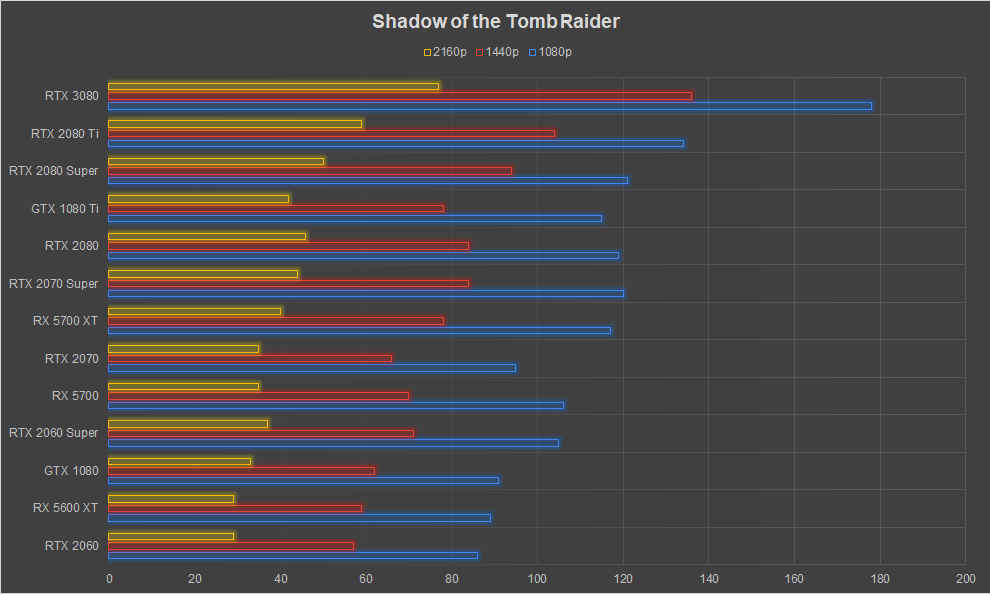
The Witcher 3
The Witcher 3: Wild Hunt is yet another game wherein we can see the generational improvements quite clearly as the game is still capable of stressing the top-end graphics cards. This seems to be changing of late as the RTX 3080 ended up getting 107 FPS at 4K with the ultra preset. We do switch off NVIDIA Hairworks in our bench runs since it’s a proprietary NVIDIA feature and that messes up the performance measurements between AMD and NVIDIA cards. When compared with the RTX 2080, we see that the RTX 3080 is approximately 74 per cent better in 1080p, 1440p and 2160p benchmarks. And when compared to the RTX 2080 Ti, which is the more appropriate comparison till it gets trumped later on, the RTX 3080 performs about 37-44 per cent better.
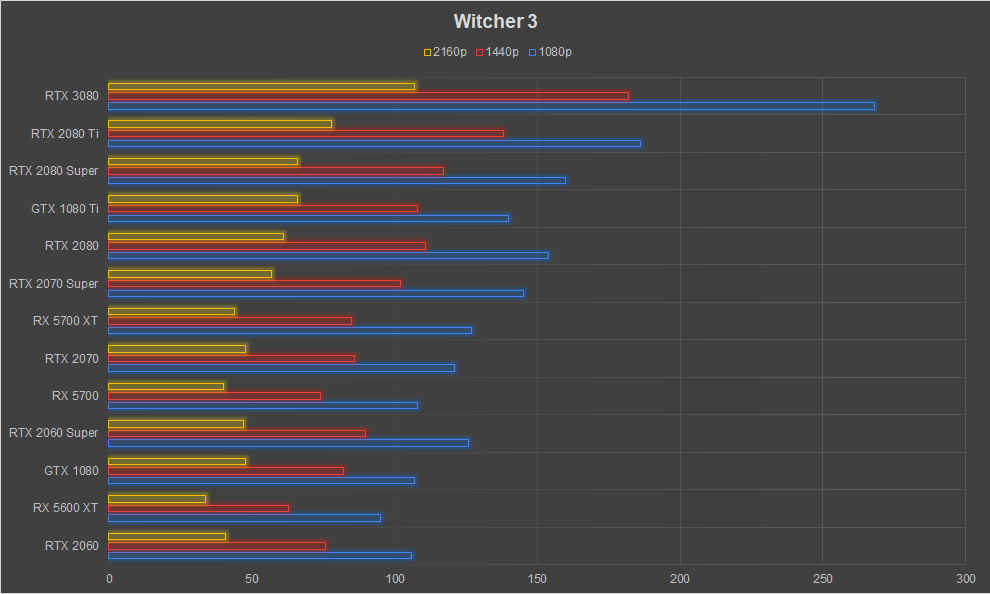
During most of our gaming benchmarks we didn't see the RTX 3080 go over 65 degrees celsius. The entire card is a massive heatsink so it has that in its favour. While cooling has been achieved, one needs to examine why such a beefy cooler was needed in the first place. In some benchmarks, we saw the RTX 3080 consume 320 watts consistently. Peak power consumption would hit 335 watts quite frequently which is a ridiculous amount for the graphics card. We're looking at the bygone era's of dual-GPU graphics cards with values such as this one. We can only imagine what the RTX 3090 would. Also, our 1200W PSU seems to have conked off in the midst of benchmarking the RTX 3080 and we had to slip in a newer 750W PSU for the rest of the benchmarks. Power consumption values remained the same with both PSUs.
The Founders Edition NVIDIA GeForce RTX 3080 will be priced at Rs 71,000 in India. The RTX 3080 and RTX 3070 pricing seem to be similar to the launch prices for their RTX 20 counterparts. Launch price for the RTX 2080 Ti Founder’s Edition was Rs 1,02,500 and the RTX 2080 started off for Rs 68,500 and lastly, the RTX 2070 was priced at Rs 51,200.
The NVIDIA GeForce RTX 3080 easily beats the RTX 2080 across all games and synthetic benchmarks by about 30-70 per cent. In some titles, it events goes ham and achieves 2x the performance. So there's little need to worry over there. It's even cooler than previous gen reference cards. So there's little reason to skip this generation. If you're looking for a flagship GPU to own, this is it. We're still going to wait for the AMD RDNA GPUS in the form of the RX 6000 series but by the looks of it, AMD has a tough job if it wants the performance crown.
| Price: | ₹71000 |
| Release Date: | 01 Sep 2020 |
| Variant: | None |
| Market Status: | Upcoming |

While not dishing out lethal doses of sarcasm, this curious creature can often be found tinkering with tech, playing 'vidya' games or exploring the darkest corners of the Internets. #PCMasterRace https://www.linkedin.com/in/mithunmohandas/











Digit caters to the largest community of tech buyers, users and enthusiasts in India. The all new Digit in continues the legacy of Thinkdigit.com as one of the largest portals in India committed to technology users and buyers. Digit is also one of the most trusted names when it comes to technology reviews and buying advice and is home to the Digit Test Lab, India's most proficient center for testing and reviewing technology products.

We are about leadership-the 9.9 kind! Building a leading media company out of India.And,grooming new leaders for this promising industry.




न्यूजट्रैक के नए ऐप से खुद को रक्खें लेटेस्ट खबरों से अपडेटेड । हमारा ऐप एंड्राइड प्लेस्टोर से डाउनलोड करने के लिए क्लिक करें - Newstrack App
Barcelona head coach, Ronald Koeman, has named a strong squad to face Girona in today’s pre-season friendly fixture at the Johan Cruyff Stadium.
Koeman released a list of 23 players to tackle the Segunda División side in a post via the club’s official website on Wednesday.
Barcelona head to the game after defeating Gimnastic 3-1 in their last fixture last Saturday.
Barcelona squad against Girona: Neto, Iñaki Peña, Arnau Tenas, N. Semedo, Piqué, Sergio, Griezmann, Messi, O. Dembélé, Coutinho, Lenglet, Jordi Alba, Braithwaite, S. Roberto, F. De Jong, Junior, Aleñá, Trincao, Pedri, Riqui Puig, R. Araujo, J. Cuenca and Konrad.
The kick-off time for the friendly match is at 6 pm.
67
71
71
73
The good looks of the Realme 1 hides the inconsistencies of the phone. It tries to get ahead of the game by gaming the synthetic benchmarks but falls flat in real world performance. It positions itself as a selfie-centric phone but the selfies from the phone comes off as artificial and puffed up.
Oppo has been a player in the Indian smartphone market for quite some time now. The China-based company, owned by BBK Electronics has positioned itself more as a premium brand in the country. Most of Oppo’s offerings have been more or less expensive with a strong emphasis on selfies. One could say Oppo’s offerings are more of a lifestyle device than just a piece of technology. However, the highest demand in the smartphone market in India is for mid-range phones that are low on price and high on features. Oppo wanted a piece of the mid-range cake, but being a premium brand, it can’t just come out with a cheap phone. Hence the brand, Realme. Just like what Xiaomi did with the Redmi brand, Realme wants to do the same for Oppo.
But whether the bet of introducing a new brand will pay off for Oppo or not is fodder for another discussion. The focus right now is whether Realme 1, the first phone under the new sub-brand is an attractive proposition. The phone certainly look different and the diamond black flair adds to the premium charm of it.
The Realme 1 launched in India exclusively to take on the Redmi Note 5 Pro, but how far does it go to settle the argument? We find out.
Design
The Realme 1 looks distinctly different from all other phones at its price, thanks to the diamond-like reflective body. The phone is housed inside a fibre-glass casing that has been cut at different angles such that each section of the glass back turns to a different shade of black when light is reflecting off it. It does look a lot like a diamond. If you like your gadgets shiny and glossy, this phone will catch your eye. The same glossy finish runs along the edges as well.
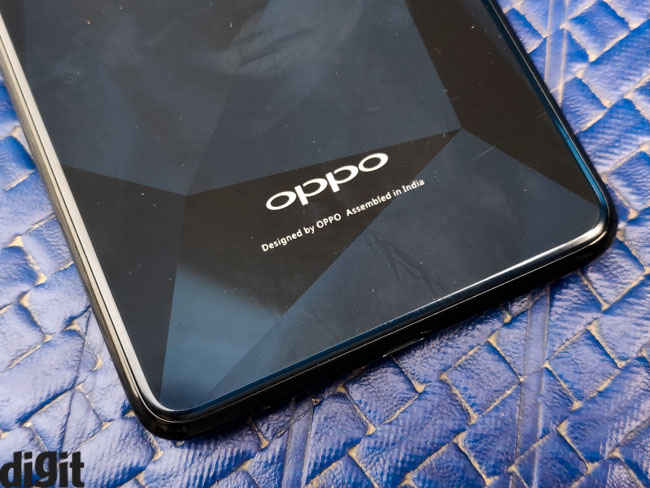
The front is all screen. There are no capacitive navigation button on the front. Even the fingerprint sensor is missing. The Realme 1 relies only on facial recognition for authentication. It’s a brave move by a brand that’s taking its first plunge in a highly competitive market, and other than just being perceived as future forward, it’s actually detrimental to the experience. The user loses out on the reliability of the fingerprint when authenticating purchases. The face unlock is quick, but isn’t reliable enough to keep user’s data secure. You can use facial authentication to access the private space (where you can store apps and data securely), and private apps (that are password-locked). In a practical scenario, the phone was unlocked by a colleague by simply pointing it at my face from a distance.
Apart from the diamond-black finish, it’s a pretty straightforward phone. It rocks the in-vogue univisium form factor and is just 7.8mm thick. There’s an ugly bulge along the edge of the phone that messes with the grip. The screen takes up most of the real-estate up front. The screen-to-body ratio is around 84 percent, which Realme managed to do by fitting the usual 6-inch display in a smaller 6.14-inch frame. The phone is offered in two more colours — Red and silver, but that will be available later in June.
Display
The Realme 1 sports a standard-issue 6-inch Full HD+ display of 18:9 aspect ratio. The panel is just about average with decent colour reproduction. The colour tones are slightly on the cooler side and brightness isn’t high enough to be visible properly when outdoors. In fact, there’s some colour loss at peak brightness and texts appear faded under direct sunlight. The panel quiet reflective too. You get the usual blue-light filters and options to tweak the colour temperature.
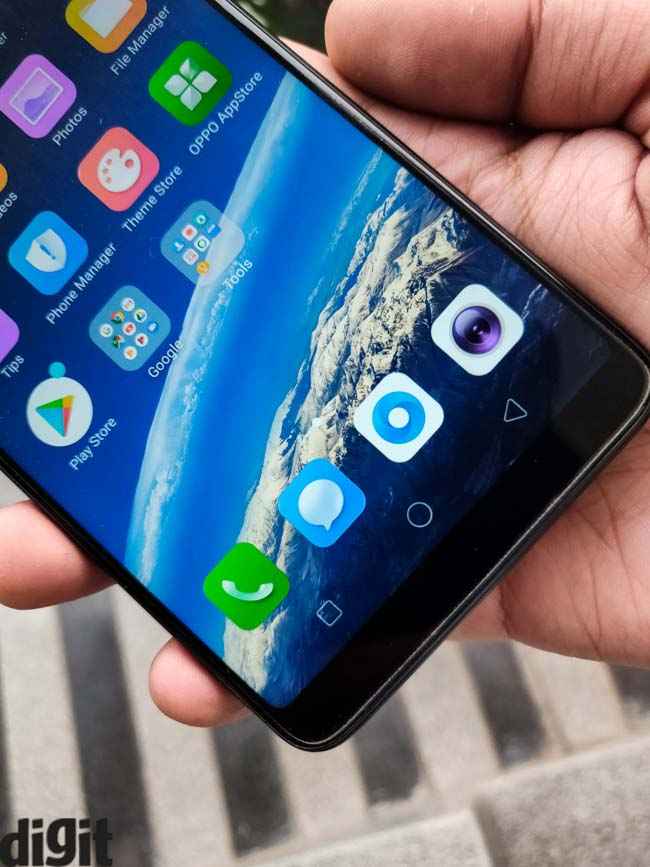
The good part about the panel is that it takes up most of the real estate up front with minimal bezels on the top and the bottom. The sides are also quite thin, which gives off an immersive feel to the content.
Performance and UI
The Realme 1 wants to be the phone of choice for mid-range buyers. The undercutting price point is one instance where it shows. But more than that, it’s the brand’s attempt to beat the best in its maiden attempt that brings out the competitive attitude of the company.
The Realme 1 is powered by the MediaTek Helio P60 SoC which is MediaTek’s most advanced chipset. It comes with an AI chip inside that can compute machine learning tasks on the device itself. It is what powers the facial recognition and the battery efficiency, apart from other things. It’s an octa-core chipset built on a 12nm FinFET process with four Cortex A53 and four Cortex A73 cores, all clocked at 2GHz frequency. On paper it’s faster than its Qualcomm counterpart, as the benchmark results from AnTuTu 7.0 and Geekbench will state. However, when I monitored how the chipset was being used, I observed some anomaly. It seemed for both the benchmark tests, which is comprised of multiple small tasks that stress the CPU to measure performance, the chipset was running at a constant 2.0GHz, irrespective whether the load on the CPU was minimal or at its peak. It could either be an anomaly with the unit I received or Realme is gaming a popular benchmark tests. In a more real world scenario, when the performance was measured while playing the new PubG Mobile game, the CPU speed matched the load put on it. The AnTuTu score for the Realme 1 was 138260 against the Redmi Note 5 Pro’s 112652. The Geekbench Single Core and Multi Core scores are also higher at 1490 and 5682 respectively. But in both cases, the CPU was artificially plonked up to eke out a better score.
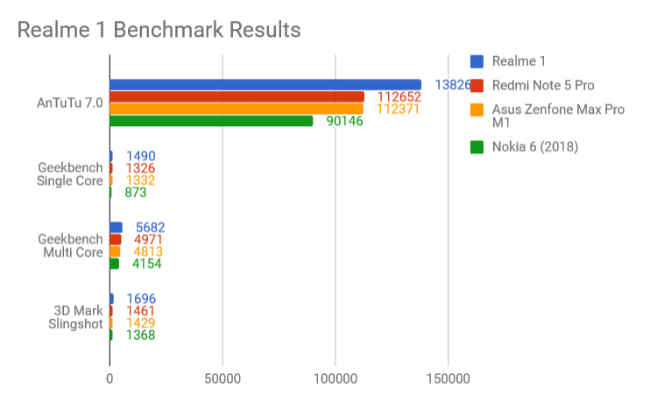
We performed a similar analysis on the Redmi Note 5 Pro which proved to be more consistent in responding to CPU load both during synthetic benchmark tests and real world scenarios. The Realme 1’s anomaly seems a little too deliberative. Nevertheless, there’s 6GB RAM and 128GB storage on the unit we re. It leaves enough resources free despite a heavy user interface. It also support dual VoLTE which is useful in the Indian context.
The Realme 1 relies on Oppo’s Colour OS. It’s definitely functional like all Android-layered user interfaces these days, but I wouldn’t call it particularly appealing. It lacks the attention to detail that MIUI is known or the simplicity of stock Android. Instead, the UI seems cluttered with disproportional icons and overall looks quite cartoonish. It does come with a game mode, a private space and the usual bells and whistles of Android Oreo, but that doesn’t take away the fact how uninviting the UI looks for a nitpicking user.
Camera
The fate of smartphones these days is decided by how good the camera is. The Realme 1, in that section, is quite underwhelming in comparison to the competition. It has a single 13-megapixel sensor at the back while on the front is an 8-megapixel shooter. The focus, unsurprisingly, is on selfies and portrait shots. The phone relies on Oppo’s AI algorithms to fine-tune the photos which the company claims works by analysing 296 recognition points to understand the skin tone, age, gender, etc. Based on that analysis, the phone applies one of 8 million ‘beauty solutions’ to the image.
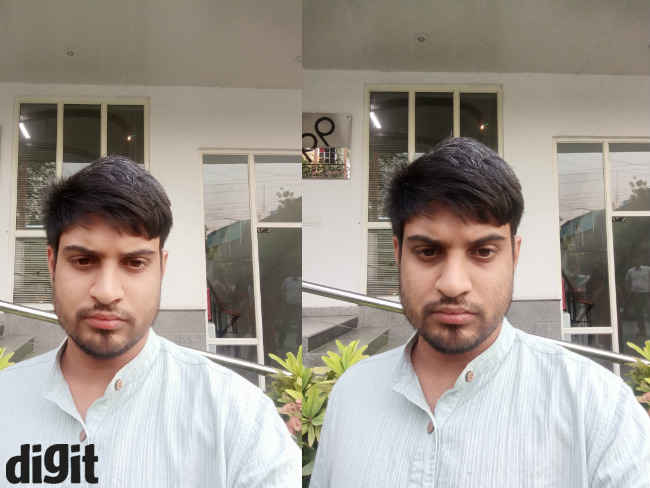
The end result is simply a photo with extreme layers of softening, so much so, that all spots and blemishes are hidden. It was a tad difficult for me to accept the effects, but I suppose there’s a demand for them in a country where fairness creams are one of the highest selling products. If beautification is what you’re seeking from a smartphone camera, the Realme 1 will be a pure delight. But if you’re a little more serious about taking good photos, the phone might leave you hanging.
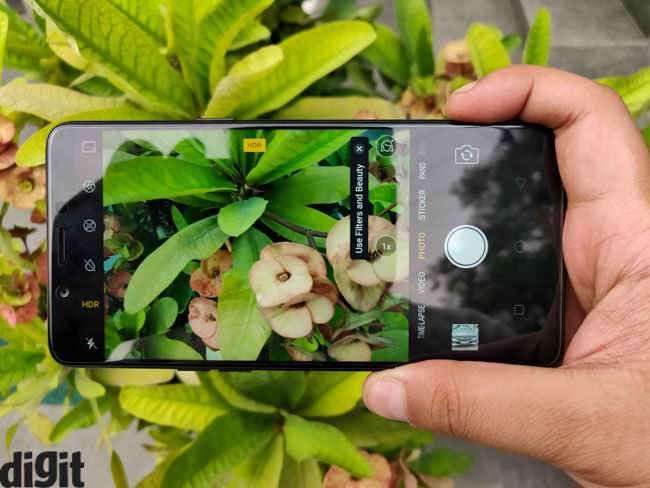
In daylight, the photos have ample highlight clipping. There’s practically no detail in the bright sky in the photo below. Furthermore, the camera tends to saturate the colours more than they are in reality. It also lacks the desired dynamic range.

Indoor shots are a little more polished. The controlled light brings out the good side of the camera. There’s more controlled AI enhancement and the little that it does, it makes objects look much better than they are in real. You get good sharp images with a slightly warmer white balance. There’s some glare off the source of light though, which might be a lens issue.
Under low light, the camera fails to show much promise. Grains show up if you try to dial the exposure higher to take an image under poor lighting, with little to no detail. The shutter speed is actually dialled up when there’s less light which demands a steady hand and if the object is moving, you get a blurred photo.
The portrait mode is present both on the front and the back camera. The Realme 1 relies on software to simulate the depth-of-field effect. It’s nowhere as consistent as the Redmi Note 5 Pro, but it does the job as far as blurring the background is concerned.
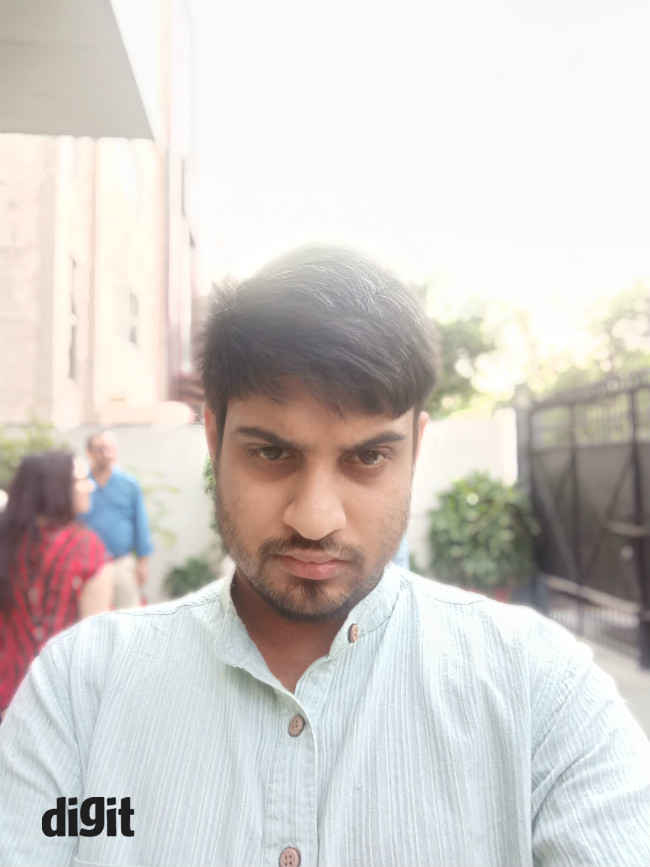
Battery
The Realme 1 is powered by a 3410mAh battery. For those comparing, that’s a hairline more than what Xiaomi’s best mid-range phone offers, and the battery life of the phone is more or less at par. The phone managed to run for 6 hours on the PCMark Battery 2.0 Test which should easily convert to over a day’s usage for an average user. For the review, I used the phone to browse the internet, play games, take photos and use social media. It did last me for a typical work day and then some more. The Helio P60 chipset seems to be quite energy-efficient and based on the battery life, Realme seems to be delivering on its promise of using machine learning to manage resources. The battery section in the Settings app gives some insight in how much juice each app takes and apart from the resource-intensive game I was playing, the UI sucked up most of the battery. When you are running out of power on this phone, you know what to blame.
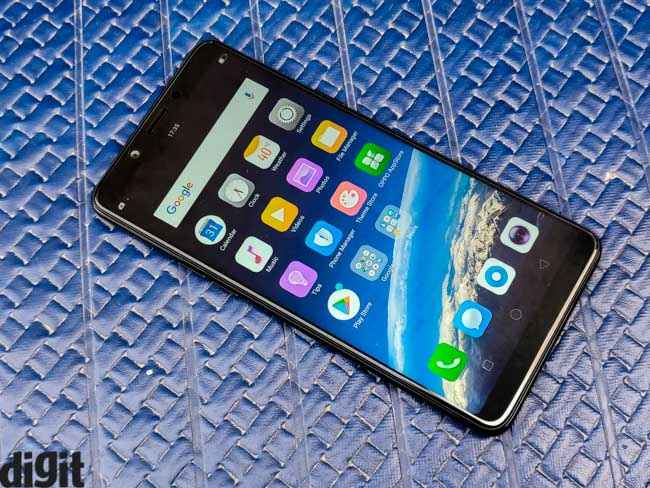
Bottomline
The debutante Realme 1’s ambition to compete with the likes of Xiaomi Redmi Note 5 Pro is quite apparent. It looks boldly different from the rest, but a good design will only take it so far. The performance is nowhere near the best in the market, despite the benchmark results telling you so. The camera which is propped up by on-device machine learning ends up delivering unnaturally softened photos while the UI comes off quite amateurish. The battery life is the only saving grace, but overall this phone isn’t what it advertises to be. Oppo’s decision to come out with a new sub-brand to cater to the highly competitive mid-range market may be driven by consumer demand, but there’s little in the phone to entice buyers, apart from a good looking device.
| Price: |
 Rs. 10999
Rs. 10999
|
| Release Date: | 25 May 2018 |
| Variant: | 32GB , 64GB , 128GB |
| Market Status: | Launched |
 Screen Size
Screen Size
 Camera
Camera
 Memory
Memory
 Battery
Battery

Digit caters to the largest community of tech buyers, users and enthusiasts in India. The all new Digit in continues the legacy of Thinkdigit.com as one of the largest portals in India committed to technology users and buyers. Digit is also one of the most trusted names when it comes to technology reviews and buying advice and is home to the Digit Test Lab, India's most proficient center for testing and reviewing technology products.

We are about leadership-the 9.9 kind! Building a leading media company out of India.And,grooming new leaders for this promising industry.


Digit caters to the largest community of tech buyers, users and enthusiasts in India. The all new Digit in continues the legacy of Thinkdigit.com as one of the largest portals in India committed to technology users and buyers. Digit is also one of the most trusted names when it comes to technology reviews and buying advice and is home to the Digit Test Lab, India's most proficient center for testing and reviewing technology products.

We are about leadership-the 9.9 kind! Building a leading media company out of India.And,grooming new leaders for this promising industry.


Shruti Modi reached Narcotics Control Bureau's office in south Mumbai today for questioning
A member of the Narcotics Control Bureau (NCB) team probing drugs angle in actor Sushant Singh Rajput's death case has tested positive for coronavirus on Wednesday following which questioning of the actor's former manager Shruti Modi has been postponed, an official said.
Shruti Modi reached the NCB office in south Mumbai around 10 am for questioning by the Special Investigation Team (SIT).
But, before the probe team could start recording her statement, the NCB received report of one of its SIT members testing positive for coronavirus, the official said.
The SIT member's antigen test came out positive, he said, adding that other members of the probe team will also be tested and all protocols will be followed.
"Accordingly, we sent back Shruti Modi who had joined the investigation in the morning," he said.
The NCB on Tuesday asked Shruti Modi and Sushant Singh Rajput's talent manager Jaya Saha to join its investigation to get a better picture on some aspects of the case. Jaya Saha will now be called later, the official said.
So far, the top drug law enforcement agency has arrested 18 people, including Sushant Rajput's friend and actress Rhea Chakraborty and her brother Showik Chakraborty.
Earlier, statements of Shruti Modi and Jaya Saha were recorded by the Central Bureau of Investigation (CBI), which is separately probing the Sushant death case.
They were also questioned by the Enforcement Directorate (ED) and the Mumbai Police in connection with cases linked to the actor's death probe.
Chats of Jaya Saha with Rhea Chakraborty had come to light during the ED's questioning, the official added.
Sushant Singh Rajput (34) was found hanging in his flat in Mumbai's suburban Bandra on June 14.